Pride or Embarrassment? Employees' Emotions and Corporate Social Responsibility
VerifiedAdded on 2023/06/12
|30
|11652
|362
AI Summary
This study explores how the employees of a financial firm use emotional arguments to construct different views of their employer’s corporate social responsibility. The study identifies six categories of emotional arguments the employees used to construct views of where their employing organization’s CSR is derived from.
Contribute Materials
Your contribution can guide someone’s learning journey. Share your
documents today.
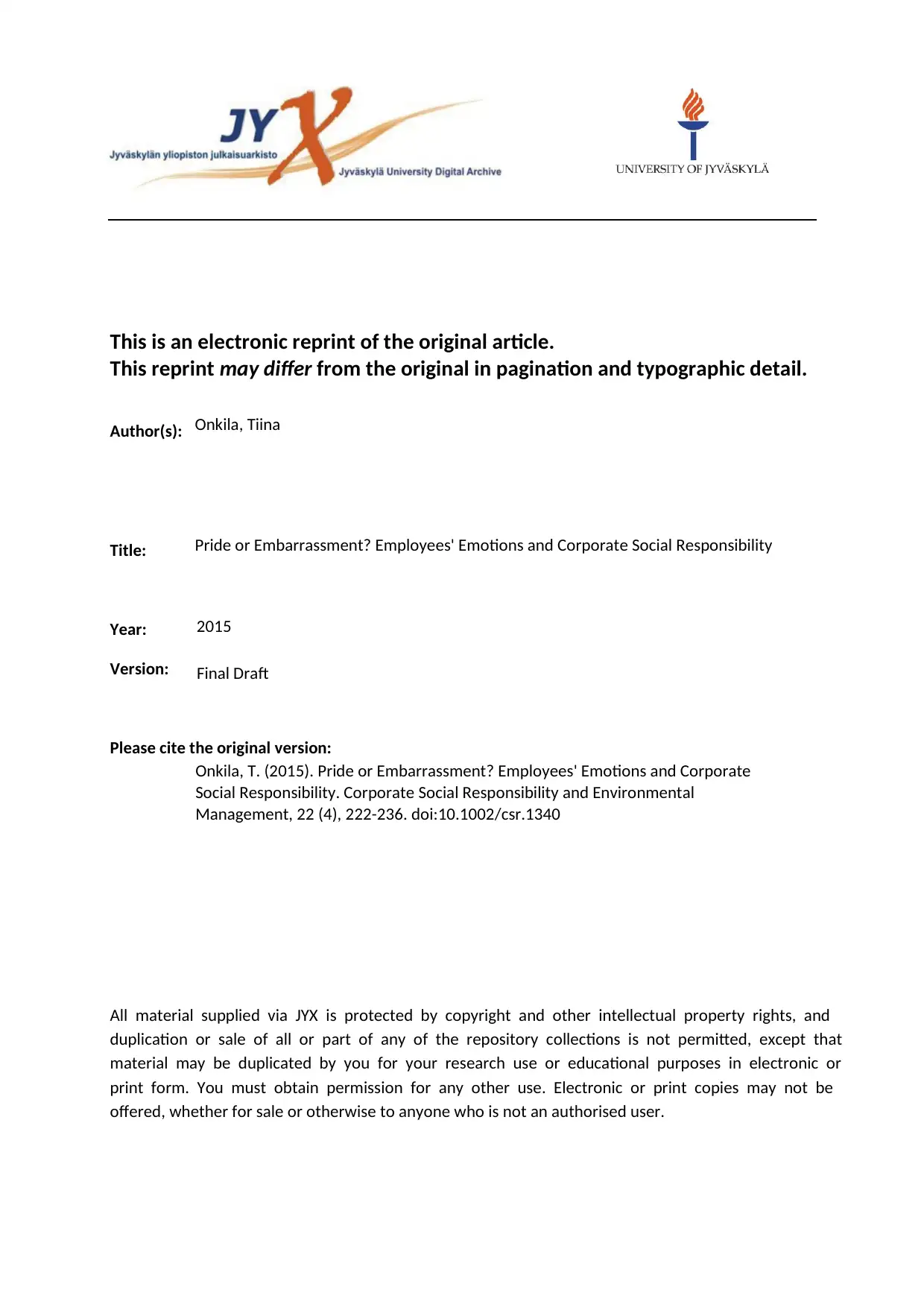
This is an electronic reprint of the original article.
This reprint may differ from the original in pagination and typographic detail.
Author(s):
Title:
Year:
Version:
Please cite the original version:
All material supplied via JYX is protected by copyright and other intellectual property rights, and
duplication or sale of all or part of any of the repository collections is not permitted, except that
material may be duplicated by you for your research use or educational purposes in electronic or
print form. You must obtain permission for any other use. Electronic or print copies may not be
offered, whether for sale or otherwise to anyone who is not an authorised user.
Pride or Embarrassment? Employees' Emotions and Corporate Social Responsibility
Onkila, Tiina
Onkila, T. (2015). Pride or Embarrassment? Employees' Emotions and Corporate
Social Responsibility. Corporate Social Responsibility and Environmental
Management, 22 (4), 222-236. doi:10.1002/csr.1340
2015
Final Draft
This reprint may differ from the original in pagination and typographic detail.
Author(s):
Title:
Year:
Version:
Please cite the original version:
All material supplied via JYX is protected by copyright and other intellectual property rights, and
duplication or sale of all or part of any of the repository collections is not permitted, except that
material may be duplicated by you for your research use or educational purposes in electronic or
print form. You must obtain permission for any other use. Electronic or print copies may not be
offered, whether for sale or otherwise to anyone who is not an authorised user.
Pride or Embarrassment? Employees' Emotions and Corporate Social Responsibility
Onkila, Tiina
Onkila, T. (2015). Pride or Embarrassment? Employees' Emotions and Corporate
Social Responsibility. Corporate Social Responsibility and Environmental
Management, 22 (4), 222-236. doi:10.1002/csr.1340
2015
Final Draft
Secure Best Marks with AI Grader
Need help grading? Try our AI Grader for instant feedback on your assignments.
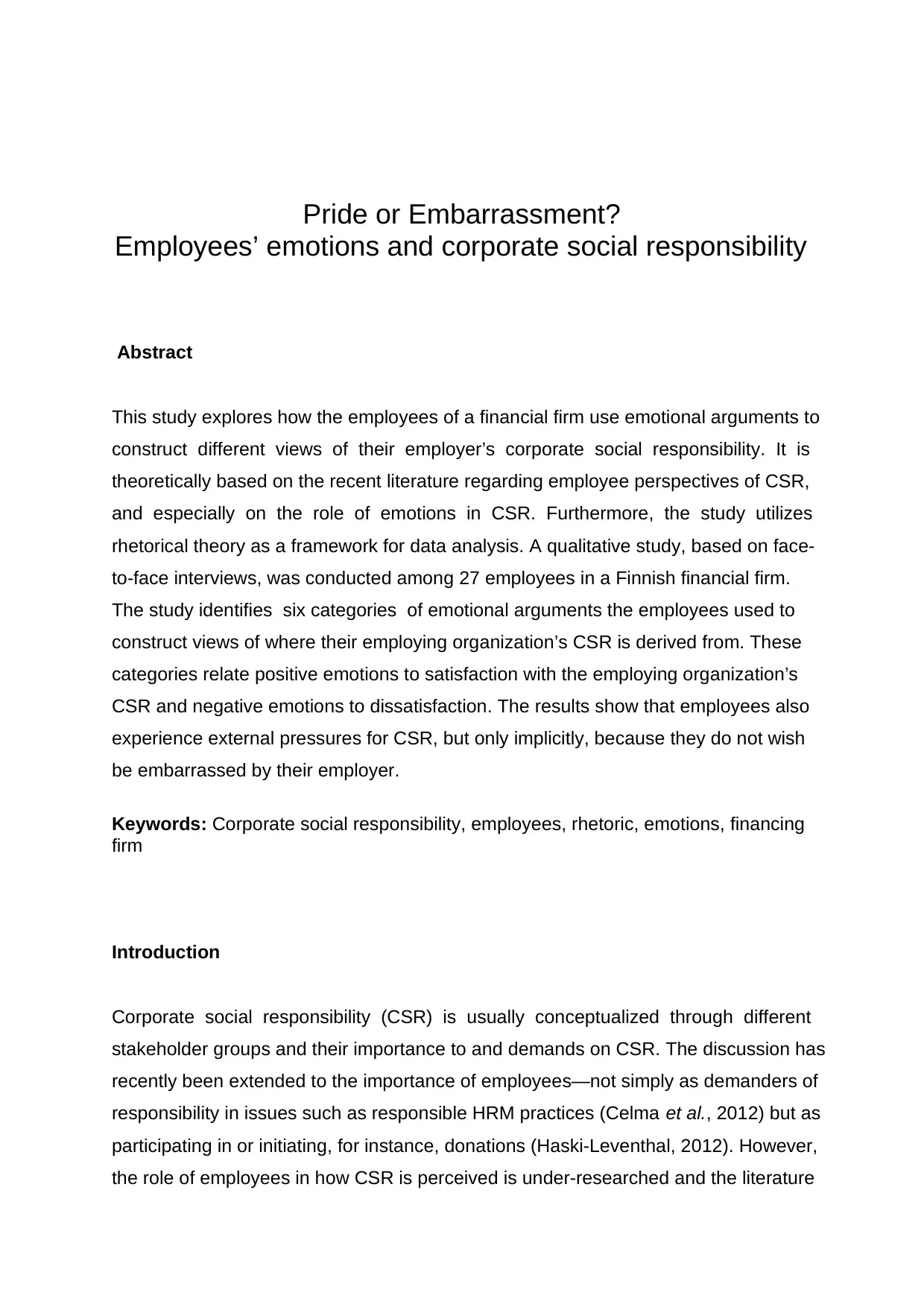
Pride or Embarrassment?
Employees’ emotions and corporate social responsibility
Abstract
This study explores how the employees of a financial firm use emotional arguments to
construct different views of their employer’s corporate social responsibility. It is
theoretically based on the recent literature regarding employee perspectives of CSR,
and especially on the role of emotions in CSR. Furthermore, the study utilizes
rhetorical theory as a framework for data analysis. A qualitative study, based on face-
to-face interviews, was conducted among 27 employees in a Finnish financial firm.
The study identifies six categories of emotional arguments the employees used to
construct views of where their employing organization’s CSR is derived from. These
categories relate positive emotions to satisfaction with the employing organization’s
CSR and negative emotions to dissatisfaction. The results show that employees also
experience external pressures for CSR, but only implicitly, because they do not wish
be embarrassed by their employer.
Keywords: Corporate social responsibility, employees, rhetoric, emotions, financing
firm
Introduction
Corporate social responsibility (CSR) is usually conceptualized through different
stakeholder groups and their importance to and demands on CSR. The discussion has
recently been extended to the importance of employees—not simply as demanders of
responsibility in issues such as responsible HRM practices (Celma et al., 2012) but as
participating in or initiating, for instance, donations (Haski-Leventhal, 2012). However,
the role of employees in how CSR is perceived is under-researched and the literature
Employees’ emotions and corporate social responsibility
Abstract
This study explores how the employees of a financial firm use emotional arguments to
construct different views of their employer’s corporate social responsibility. It is
theoretically based on the recent literature regarding employee perspectives of CSR,
and especially on the role of emotions in CSR. Furthermore, the study utilizes
rhetorical theory as a framework for data analysis. A qualitative study, based on face-
to-face interviews, was conducted among 27 employees in a Finnish financial firm.
The study identifies six categories of emotional arguments the employees used to
construct views of where their employing organization’s CSR is derived from. These
categories relate positive emotions to satisfaction with the employing organization’s
CSR and negative emotions to dissatisfaction. The results show that employees also
experience external pressures for CSR, but only implicitly, because they do not wish
be embarrassed by their employer.
Keywords: Corporate social responsibility, employees, rhetoric, emotions, financing
firm
Introduction
Corporate social responsibility (CSR) is usually conceptualized through different
stakeholder groups and their importance to and demands on CSR. The discussion has
recently been extended to the importance of employees—not simply as demanders of
responsibility in issues such as responsible HRM practices (Celma et al., 2012) but as
participating in or initiating, for instance, donations (Haski-Leventhal, 2012). However,
the role of employees in how CSR is perceived is under-researched and the literature
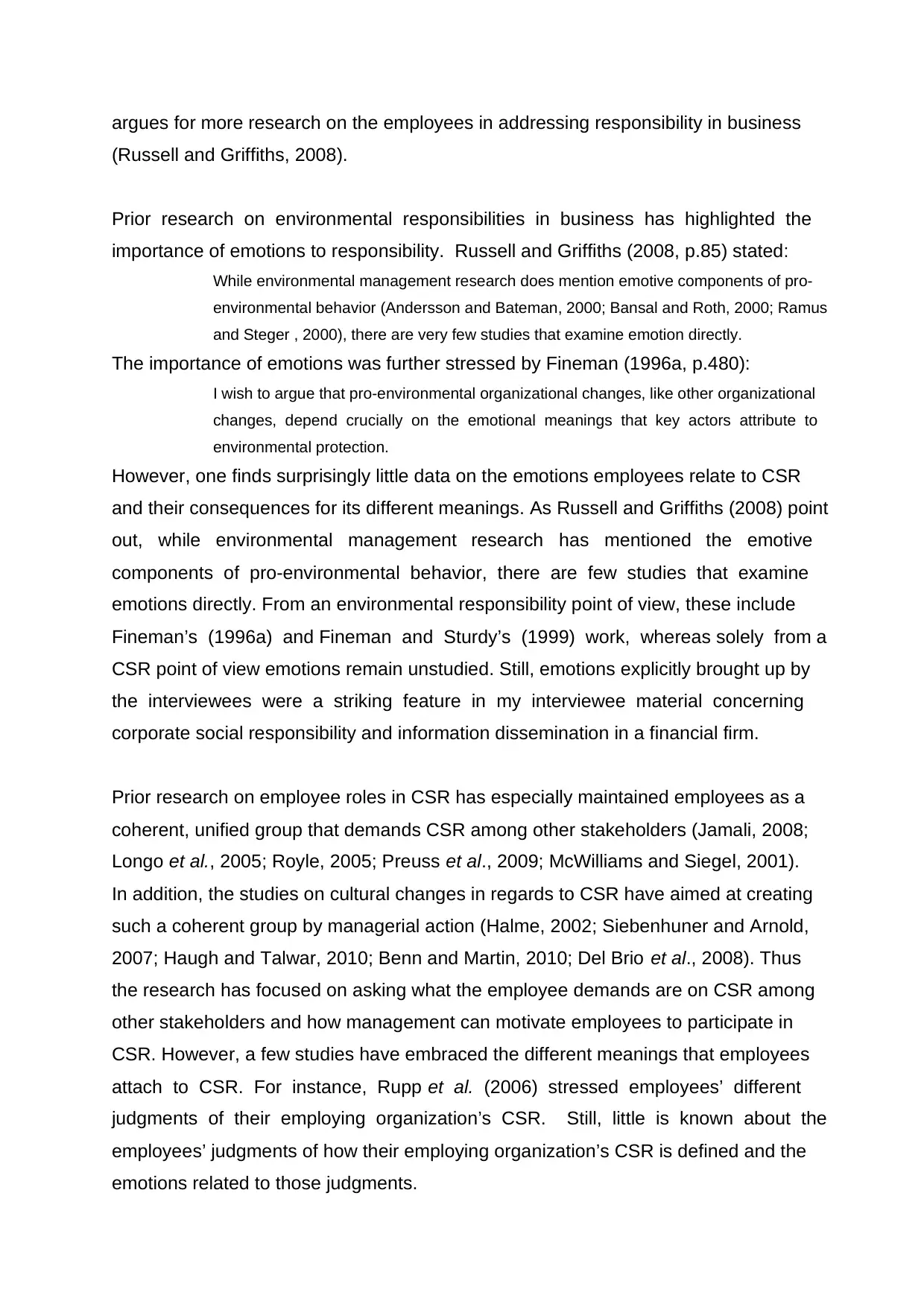
argues for more research on the employees in addressing responsibility in business
(Russell and Griffiths, 2008).
Prior research on environmental responsibilities in business has highlighted the
importance of emotions to responsibility. Russell and Griffiths (2008, p.85) stated:
While environmental management research does mention emotive components of pro-
environmental behavior (Andersson and Bateman, 2000; Bansal and Roth, 2000; Ramus
and Steger , 2000), there are very few studies that examine emotion directly.
The importance of emotions was further stressed by Fineman (1996a, p.480):
I wish to argue that pro-environmental organizational changes, like other organizational
changes, depend crucially on the emotional meanings that key actors attribute to
environmental protection.
However, one finds surprisingly little data on the emotions employees relate to CSR
and their consequences for its different meanings. As Russell and Griffiths (2008) point
out, while environmental management research has mentioned the emotive
components of pro-environmental behavior, there are few studies that examine
emotions directly. From an environmental responsibility point of view, these include
Fineman’s (1996a) and Fineman and Sturdy’s (1999) work, whereas solely from a
CSR point of view emotions remain unstudied. Still, emotions explicitly brought up by
the interviewees were a striking feature in my interviewee material concerning
corporate social responsibility and information dissemination in a financial firm.
Prior research on employee roles in CSR has especially maintained employees as a
coherent, unified group that demands CSR among other stakeholders (Jamali, 2008;
Longo et al., 2005; Royle, 2005; Preuss et al., 2009; McWilliams and Siegel, 2001).
In addition, the studies on cultural changes in regards to CSR have aimed at creating
such a coherent group by managerial action (Halme, 2002; Siebenhuner and Arnold,
2007; Haugh and Talwar, 2010; Benn and Martin, 2010; Del Brio et al., 2008). Thus
the research has focused on asking what the employee demands are on CSR among
other stakeholders and how management can motivate employees to participate in
CSR. However, a few studies have embraced the different meanings that employees
attach to CSR. For instance, Rupp et al. (2006) stressed employees’ different
judgments of their employing organization’s CSR. Still, little is known about the
employees’ judgments of how their employing organization’s CSR is defined and the
emotions related to those judgments.
(Russell and Griffiths, 2008).
Prior research on environmental responsibilities in business has highlighted the
importance of emotions to responsibility. Russell and Griffiths (2008, p.85) stated:
While environmental management research does mention emotive components of pro-
environmental behavior (Andersson and Bateman, 2000; Bansal and Roth, 2000; Ramus
and Steger , 2000), there are very few studies that examine emotion directly.
The importance of emotions was further stressed by Fineman (1996a, p.480):
I wish to argue that pro-environmental organizational changes, like other organizational
changes, depend crucially on the emotional meanings that key actors attribute to
environmental protection.
However, one finds surprisingly little data on the emotions employees relate to CSR
and their consequences for its different meanings. As Russell and Griffiths (2008) point
out, while environmental management research has mentioned the emotive
components of pro-environmental behavior, there are few studies that examine
emotions directly. From an environmental responsibility point of view, these include
Fineman’s (1996a) and Fineman and Sturdy’s (1999) work, whereas solely from a
CSR point of view emotions remain unstudied. Still, emotions explicitly brought up by
the interviewees were a striking feature in my interviewee material concerning
corporate social responsibility and information dissemination in a financial firm.
Prior research on employee roles in CSR has especially maintained employees as a
coherent, unified group that demands CSR among other stakeholders (Jamali, 2008;
Longo et al., 2005; Royle, 2005; Preuss et al., 2009; McWilliams and Siegel, 2001).
In addition, the studies on cultural changes in regards to CSR have aimed at creating
such a coherent group by managerial action (Halme, 2002; Siebenhuner and Arnold,
2007; Haugh and Talwar, 2010; Benn and Martin, 2010; Del Brio et al., 2008). Thus
the research has focused on asking what the employee demands are on CSR among
other stakeholders and how management can motivate employees to participate in
CSR. However, a few studies have embraced the different meanings that employees
attach to CSR. For instance, Rupp et al. (2006) stressed employees’ different
judgments of their employing organization’s CSR. Still, little is known about the
employees’ judgments of how their employing organization’s CSR is defined and the
emotions related to those judgments.
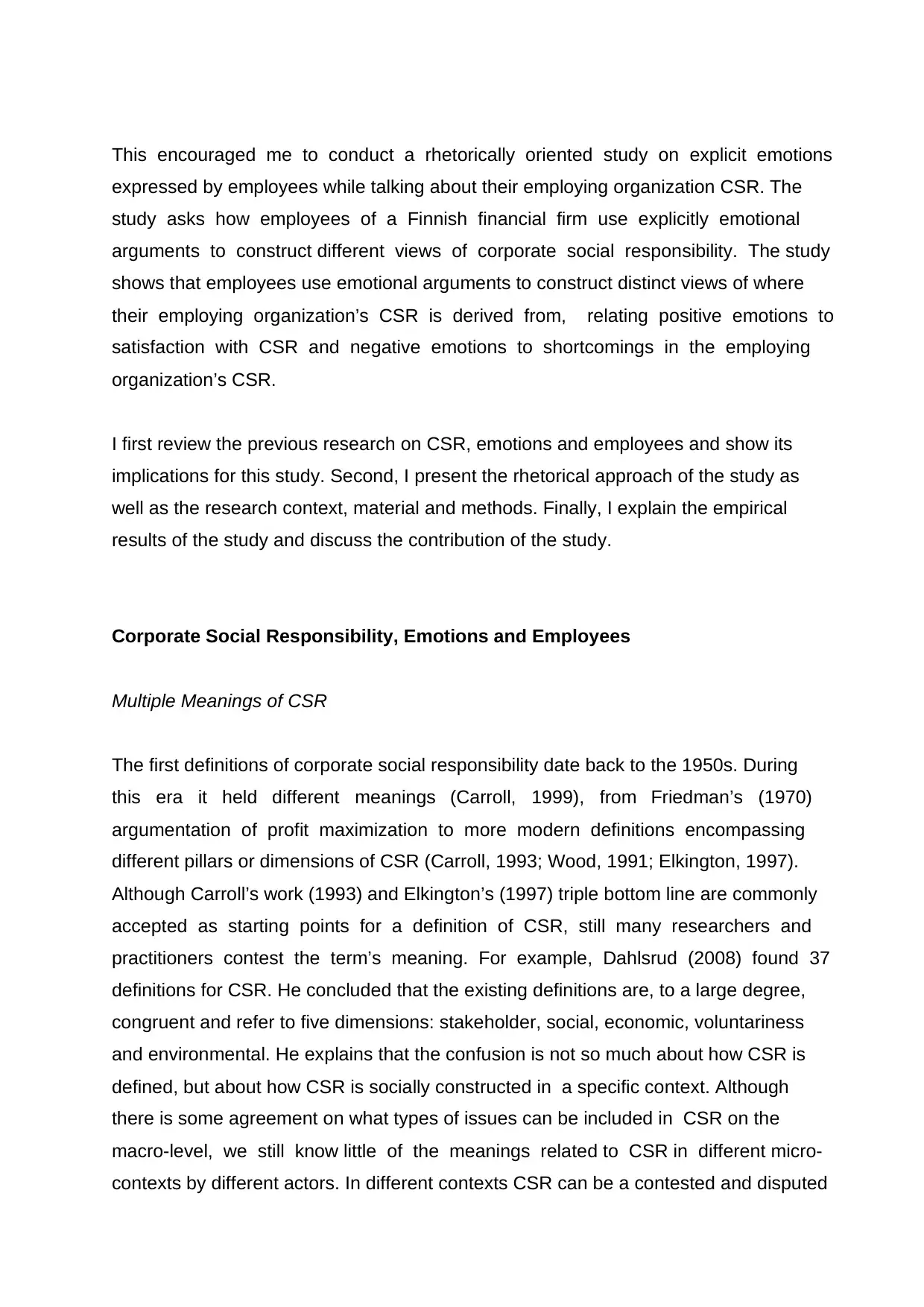
This encouraged me to conduct a rhetorically oriented study on explicit emotions
expressed by employees while talking about their employing organization CSR. The
study asks how employees of a Finnish financial firm use explicitly emotional
arguments to construct different views of corporate social responsibility. The study
shows that employees use emotional arguments to construct distinct views of where
their employing organization’s CSR is derived from, relating positive emotions to
satisfaction with CSR and negative emotions to shortcomings in the employing
organization’s CSR.
I first review the previous research on CSR, emotions and employees and show its
implications for this study. Second, I present the rhetorical approach of the study as
well as the research context, material and methods. Finally, I explain the empirical
results of the study and discuss the contribution of the study.
Corporate Social Responsibility, Emotions and Employees
Multiple Meanings of CSR
The first definitions of corporate social responsibility date back to the 1950s. During
this era it held different meanings (Carroll, 1999), from Friedman’s (1970)
argumentation of profit maximization to more modern definitions encompassing
different pillars or dimensions of CSR (Carroll, 1993; Wood, 1991; Elkington, 1997).
Although Carroll’s work (1993) and Elkington’s (1997) triple bottom line are commonly
accepted as starting points for a definition of CSR, still many researchers and
practitioners contest the term’s meaning. For example, Dahlsrud (2008) found 37
definitions for CSR. He concluded that the existing definitions are, to a large degree,
congruent and refer to five dimensions: stakeholder, social, economic, voluntariness
and environmental. He explains that the confusion is not so much about how CSR is
defined, but about how CSR is socially constructed in a specific context. Although
there is some agreement on what types of issues can be included in CSR on the
macro-level, we still know little of the meanings related to CSR in different micro-
contexts by different actors. In different contexts CSR can be a contested and disputed
expressed by employees while talking about their employing organization CSR. The
study asks how employees of a Finnish financial firm use explicitly emotional
arguments to construct different views of corporate social responsibility. The study
shows that employees use emotional arguments to construct distinct views of where
their employing organization’s CSR is derived from, relating positive emotions to
satisfaction with CSR and negative emotions to shortcomings in the employing
organization’s CSR.
I first review the previous research on CSR, emotions and employees and show its
implications for this study. Second, I present the rhetorical approach of the study as
well as the research context, material and methods. Finally, I explain the empirical
results of the study and discuss the contribution of the study.
Corporate Social Responsibility, Emotions and Employees
Multiple Meanings of CSR
The first definitions of corporate social responsibility date back to the 1950s. During
this era it held different meanings (Carroll, 1999), from Friedman’s (1970)
argumentation of profit maximization to more modern definitions encompassing
different pillars or dimensions of CSR (Carroll, 1993; Wood, 1991; Elkington, 1997).
Although Carroll’s work (1993) and Elkington’s (1997) triple bottom line are commonly
accepted as starting points for a definition of CSR, still many researchers and
practitioners contest the term’s meaning. For example, Dahlsrud (2008) found 37
definitions for CSR. He concluded that the existing definitions are, to a large degree,
congruent and refer to five dimensions: stakeholder, social, economic, voluntariness
and environmental. He explains that the confusion is not so much about how CSR is
defined, but about how CSR is socially constructed in a specific context. Although
there is some agreement on what types of issues can be included in CSR on the
macro-level, we still know little of the meanings related to CSR in different micro-
contexts by different actors. In different contexts CSR can be a contested and disputed
Secure Best Marks with AI Grader
Need help grading? Try our AI Grader for instant feedback on your assignments.
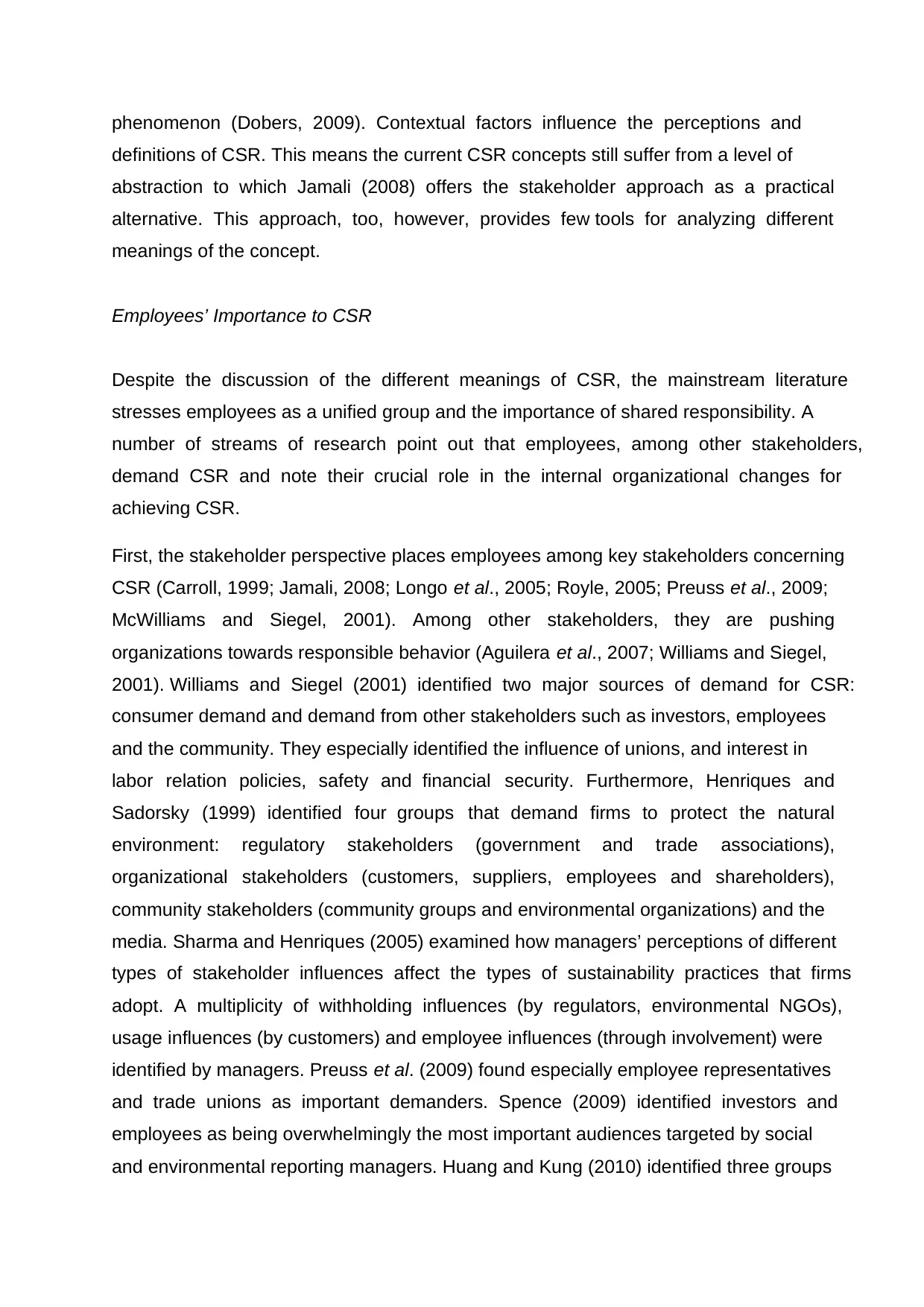
phenomenon (Dobers, 2009). Contextual factors influence the perceptions and
definitions of CSR. This means the current CSR concepts still suffer from a level of
abstraction to which Jamali (2008) offers the stakeholder approach as a practical
alternative. This approach, too, however, provides few tools for analyzing different
meanings of the concept.
Employees’ Importance to CSR
Despite the discussion of the different meanings of CSR, the mainstream literature
stresses employees as a unified group and the importance of shared responsibility. A
number of streams of research point out that employees, among other stakeholders,
demand CSR and note their crucial role in the internal organizational changes for
achieving CSR.
First, the stakeholder perspective places employees among key stakeholders concerning
CSR (Carroll, 1999; Jamali, 2008; Longo et al., 2005; Royle, 2005; Preuss et al., 2009;
McWilliams and Siegel, 2001). Among other stakeholders, they are pushing
organizations towards responsible behavior (Aguilera et al., 2007; Williams and Siegel,
2001). Williams and Siegel (2001) identified two major sources of demand for CSR:
consumer demand and demand from other stakeholders such as investors, employees
and the community. They especially identified the influence of unions, and interest in
labor relation policies, safety and financial security. Furthermore, Henriques and
Sadorsky (1999) identified four groups that demand firms to protect the natural
environment: regulatory stakeholders (government and trade associations),
organizational stakeholders (customers, suppliers, employees and shareholders),
community stakeholders (community groups and environmental organizations) and the
media. Sharma and Henriques (2005) examined how managers’ perceptions of different
types of stakeholder influences affect the types of sustainability practices that firms
adopt. A multiplicity of withholding influences (by regulators, environmental NGOs),
usage influences (by customers) and employee influences (through involvement) were
identified by managers. Preuss et al. (2009) found especially employee representatives
and trade unions as important demanders. Spence (2009) identified investors and
employees as being overwhelmingly the most important audiences targeted by social
and environmental reporting managers. Huang and Kung (2010) identified three groups
definitions of CSR. This means the current CSR concepts still suffer from a level of
abstraction to which Jamali (2008) offers the stakeholder approach as a practical
alternative. This approach, too, however, provides few tools for analyzing different
meanings of the concept.
Employees’ Importance to CSR
Despite the discussion of the different meanings of CSR, the mainstream literature
stresses employees as a unified group and the importance of shared responsibility. A
number of streams of research point out that employees, among other stakeholders,
demand CSR and note their crucial role in the internal organizational changes for
achieving CSR.
First, the stakeholder perspective places employees among key stakeholders concerning
CSR (Carroll, 1999; Jamali, 2008; Longo et al., 2005; Royle, 2005; Preuss et al., 2009;
McWilliams and Siegel, 2001). Among other stakeholders, they are pushing
organizations towards responsible behavior (Aguilera et al., 2007; Williams and Siegel,
2001). Williams and Siegel (2001) identified two major sources of demand for CSR:
consumer demand and demand from other stakeholders such as investors, employees
and the community. They especially identified the influence of unions, and interest in
labor relation policies, safety and financial security. Furthermore, Henriques and
Sadorsky (1999) identified four groups that demand firms to protect the natural
environment: regulatory stakeholders (government and trade associations),
organizational stakeholders (customers, suppliers, employees and shareholders),
community stakeholders (community groups and environmental organizations) and the
media. Sharma and Henriques (2005) examined how managers’ perceptions of different
types of stakeholder influences affect the types of sustainability practices that firms
adopt. A multiplicity of withholding influences (by regulators, environmental NGOs),
usage influences (by customers) and employee influences (through involvement) were
identified by managers. Preuss et al. (2009) found especially employee representatives
and trade unions as important demanders. Spence (2009) identified investors and
employees as being overwhelmingly the most important audiences targeted by social
and environmental reporting managers. Huang and Kung (2010) identified three groups
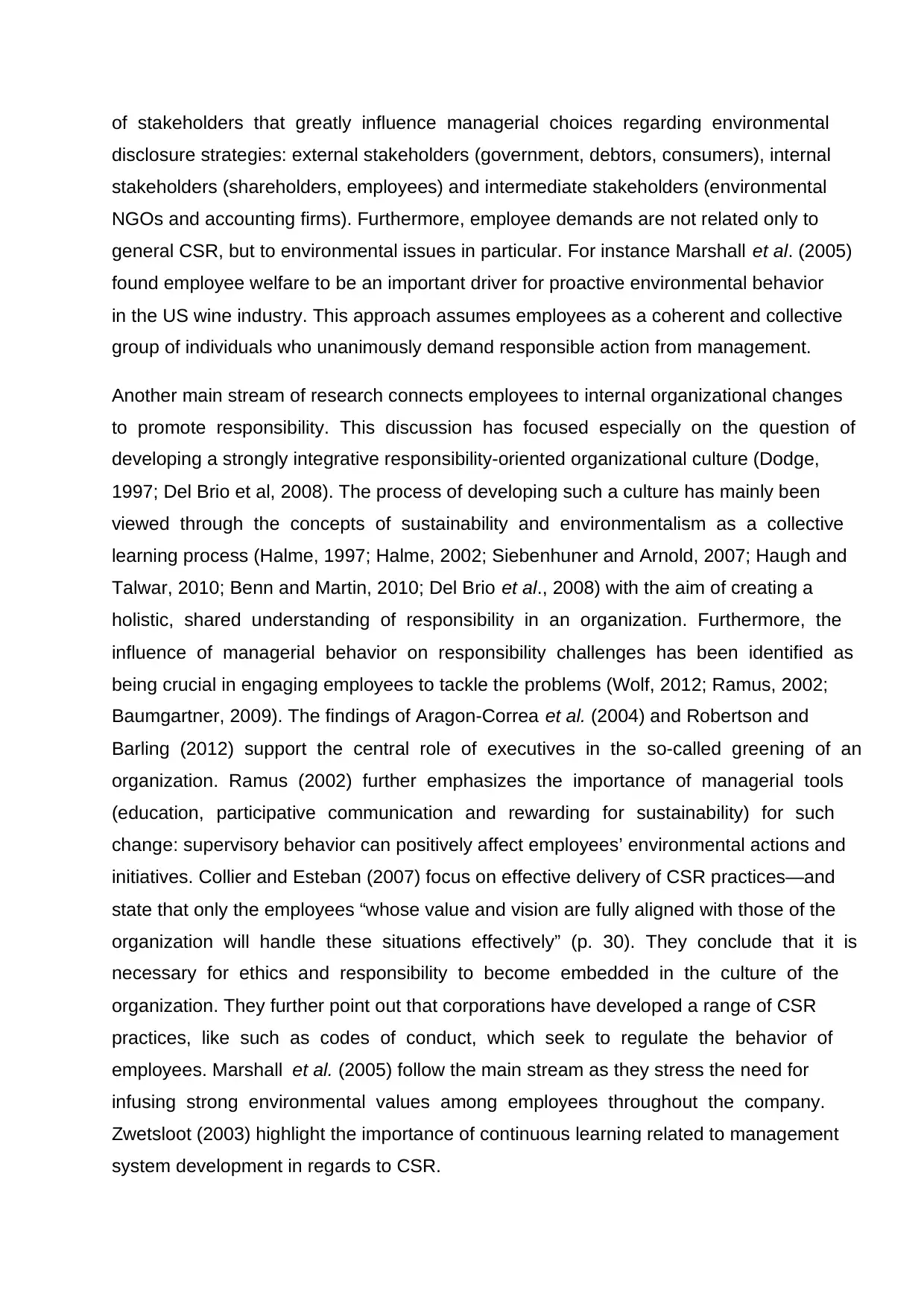
of stakeholders that greatly influence managerial choices regarding environmental
disclosure strategies: external stakeholders (government, debtors, consumers), internal
stakeholders (shareholders, employees) and intermediate stakeholders (environmental
NGOs and accounting firms). Furthermore, employee demands are not related only to
general CSR, but to environmental issues in particular. For instance Marshall et al. (2005)
found employee welfare to be an important driver for proactive environmental behavior
in the US wine industry. This approach assumes employees as a coherent and collective
group of individuals who unanimously demand responsible action from management.
Another main stream of research connects employees to internal organizational changes
to promote responsibility. This discussion has focused especially on the question of
developing a strongly integrative responsibility-oriented organizational culture (Dodge,
1997; Del Brio et al, 2008). The process of developing such a culture has mainly been
viewed through the concepts of sustainability and environmentalism as a collective
learning process (Halme, 1997; Halme, 2002; Siebenhuner and Arnold, 2007; Haugh and
Talwar, 2010; Benn and Martin, 2010; Del Brio et al., 2008) with the aim of creating a
holistic, shared understanding of responsibility in an organization. Furthermore, the
influence of managerial behavior on responsibility challenges has been identified as
being crucial in engaging employees to tackle the problems (Wolf, 2012; Ramus, 2002;
Baumgartner, 2009). The findings of Aragon-Correa et al. (2004) and Robertson and
Barling (2012) support the central role of executives in the so-called greening of an
organization. Ramus (2002) further emphasizes the importance of managerial tools
(education, participative communication and rewarding for sustainability) for such
change: supervisory behavior can positively affect employees’ environmental actions and
initiatives. Collier and Esteban (2007) focus on effective delivery of CSR practices—and
state that only the employees “whose value and vision are fully aligned with those of the
organization will handle these situations effectively” (p. 30). They conclude that it is
necessary for ethics and responsibility to become embedded in the culture of the
organization. They further point out that corporations have developed a range of CSR
practices, like such as codes of conduct, which seek to regulate the behavior of
employees. Marshall et al. (2005) follow the main stream as they stress the need for
infusing strong environmental values among employees throughout the company.
Zwetsloot (2003) highlight the importance of continuous learning related to management
system development in regards to CSR.
disclosure strategies: external stakeholders (government, debtors, consumers), internal
stakeholders (shareholders, employees) and intermediate stakeholders (environmental
NGOs and accounting firms). Furthermore, employee demands are not related only to
general CSR, but to environmental issues in particular. For instance Marshall et al. (2005)
found employee welfare to be an important driver for proactive environmental behavior
in the US wine industry. This approach assumes employees as a coherent and collective
group of individuals who unanimously demand responsible action from management.
Another main stream of research connects employees to internal organizational changes
to promote responsibility. This discussion has focused especially on the question of
developing a strongly integrative responsibility-oriented organizational culture (Dodge,
1997; Del Brio et al, 2008). The process of developing such a culture has mainly been
viewed through the concepts of sustainability and environmentalism as a collective
learning process (Halme, 1997; Halme, 2002; Siebenhuner and Arnold, 2007; Haugh and
Talwar, 2010; Benn and Martin, 2010; Del Brio et al., 2008) with the aim of creating a
holistic, shared understanding of responsibility in an organization. Furthermore, the
influence of managerial behavior on responsibility challenges has been identified as
being crucial in engaging employees to tackle the problems (Wolf, 2012; Ramus, 2002;
Baumgartner, 2009). The findings of Aragon-Correa et al. (2004) and Robertson and
Barling (2012) support the central role of executives in the so-called greening of an
organization. Ramus (2002) further emphasizes the importance of managerial tools
(education, participative communication and rewarding for sustainability) for such
change: supervisory behavior can positively affect employees’ environmental actions and
initiatives. Collier and Esteban (2007) focus on effective delivery of CSR practices—and
state that only the employees “whose value and vision are fully aligned with those of the
organization will handle these situations effectively” (p. 30). They conclude that it is
necessary for ethics and responsibility to become embedded in the culture of the
organization. They further point out that corporations have developed a range of CSR
practices, like such as codes of conduct, which seek to regulate the behavior of
employees. Marshall et al. (2005) follow the main stream as they stress the need for
infusing strong environmental values among employees throughout the company.
Zwetsloot (2003) highlight the importance of continuous learning related to management
system development in regards to CSR.
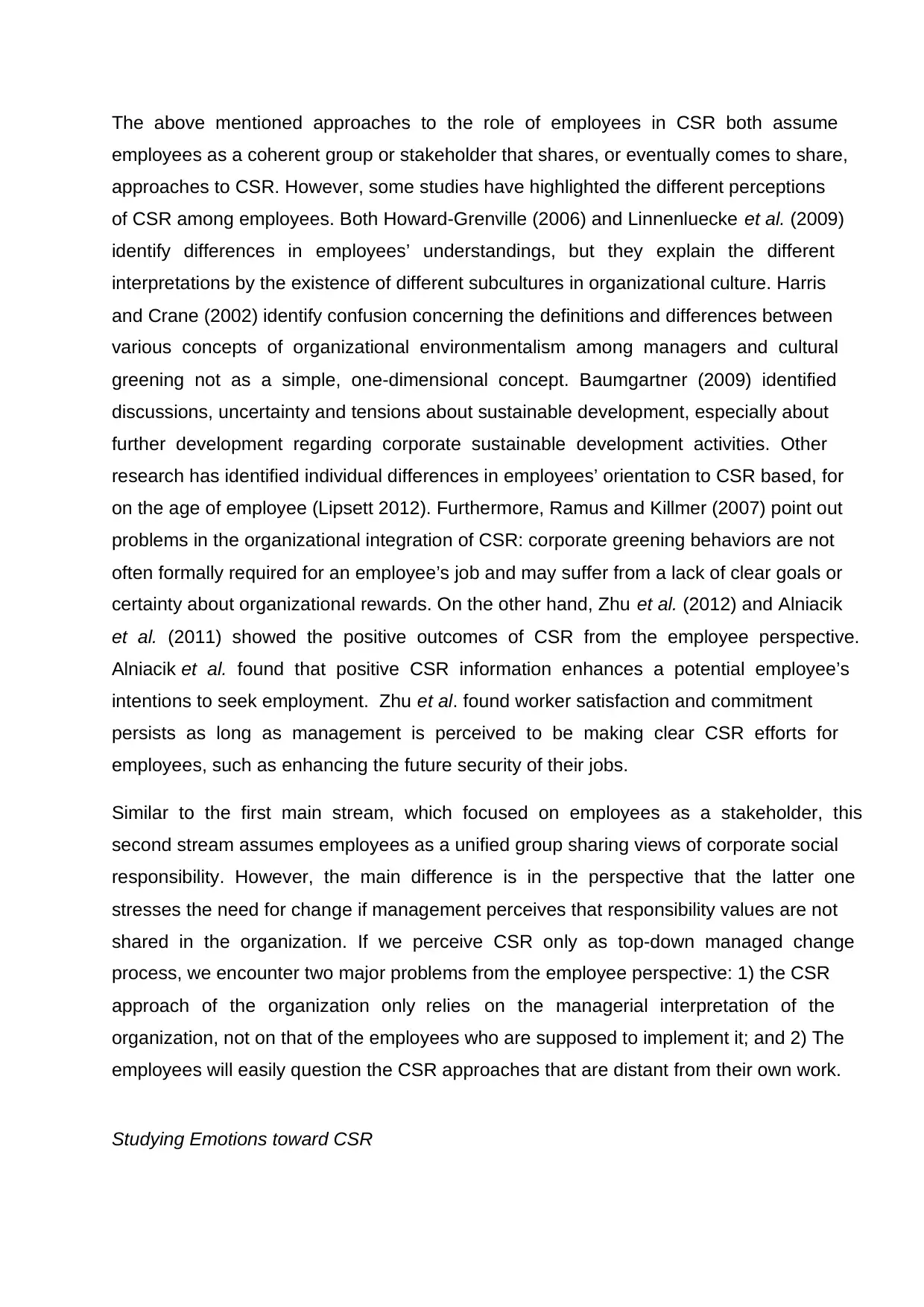
The above mentioned approaches to the role of employees in CSR both assume
employees as a coherent group or stakeholder that shares, or eventually comes to share,
approaches to CSR. However, some studies have highlighted the different perceptions
of CSR among employees. Both Howard-Grenville (2006) and Linnenluecke et al. (2009)
identify differences in employees’ understandings, but they explain the different
interpretations by the existence of different subcultures in organizational culture. Harris
and Crane (2002) identify confusion concerning the definitions and differences between
various concepts of organizational environmentalism among managers and cultural
greening not as a simple, one-dimensional concept. Baumgartner (2009) identified
discussions, uncertainty and tensions about sustainable development, especially about
further development regarding corporate sustainable development activities. Other
research has identified individual differences in employees’ orientation to CSR based, for
on the age of employee (Lipsett 2012). Furthermore, Ramus and Killmer (2007) point out
problems in the organizational integration of CSR: corporate greening behaviors are not
often formally required for an employee’s job and may suffer from a lack of clear goals or
certainty about organizational rewards. On the other hand, Zhu et al. (2012) and Alniacik
et al. (2011) showed the positive outcomes of CSR from the employee perspective.
Alniacik et al. found that positive CSR information enhances a potential employee’s
intentions to seek employment. Zhu et al. found worker satisfaction and commitment
persists as long as management is perceived to be making clear CSR efforts for
employees, such as enhancing the future security of their jobs.
Similar to the first main stream, which focused on employees as a stakeholder, this
second stream assumes employees as a unified group sharing views of corporate social
responsibility. However, the main difference is in the perspective that the latter one
stresses the need for change if management perceives that responsibility values are not
shared in the organization. If we perceive CSR only as top-down managed change
process, we encounter two major problems from the employee perspective: 1) the CSR
approach of the organization only relies on the managerial interpretation of the
organization, not on that of the employees who are supposed to implement it; and 2) The
employees will easily question the CSR approaches that are distant from their own work.
Studying Emotions toward CSR
employees as a coherent group or stakeholder that shares, or eventually comes to share,
approaches to CSR. However, some studies have highlighted the different perceptions
of CSR among employees. Both Howard-Grenville (2006) and Linnenluecke et al. (2009)
identify differences in employees’ understandings, but they explain the different
interpretations by the existence of different subcultures in organizational culture. Harris
and Crane (2002) identify confusion concerning the definitions and differences between
various concepts of organizational environmentalism among managers and cultural
greening not as a simple, one-dimensional concept. Baumgartner (2009) identified
discussions, uncertainty and tensions about sustainable development, especially about
further development regarding corporate sustainable development activities. Other
research has identified individual differences in employees’ orientation to CSR based, for
on the age of employee (Lipsett 2012). Furthermore, Ramus and Killmer (2007) point out
problems in the organizational integration of CSR: corporate greening behaviors are not
often formally required for an employee’s job and may suffer from a lack of clear goals or
certainty about organizational rewards. On the other hand, Zhu et al. (2012) and Alniacik
et al. (2011) showed the positive outcomes of CSR from the employee perspective.
Alniacik et al. found that positive CSR information enhances a potential employee’s
intentions to seek employment. Zhu et al. found worker satisfaction and commitment
persists as long as management is perceived to be making clear CSR efforts for
employees, such as enhancing the future security of their jobs.
Similar to the first main stream, which focused on employees as a stakeholder, this
second stream assumes employees as a unified group sharing views of corporate social
responsibility. However, the main difference is in the perspective that the latter one
stresses the need for change if management perceives that responsibility values are not
shared in the organization. If we perceive CSR only as top-down managed change
process, we encounter two major problems from the employee perspective: 1) the CSR
approach of the organization only relies on the managerial interpretation of the
organization, not on that of the employees who are supposed to implement it; and 2) The
employees will easily question the CSR approaches that are distant from their own work.
Studying Emotions toward CSR
Paraphrase This Document
Need a fresh take? Get an instant paraphrase of this document with our AI Paraphraser
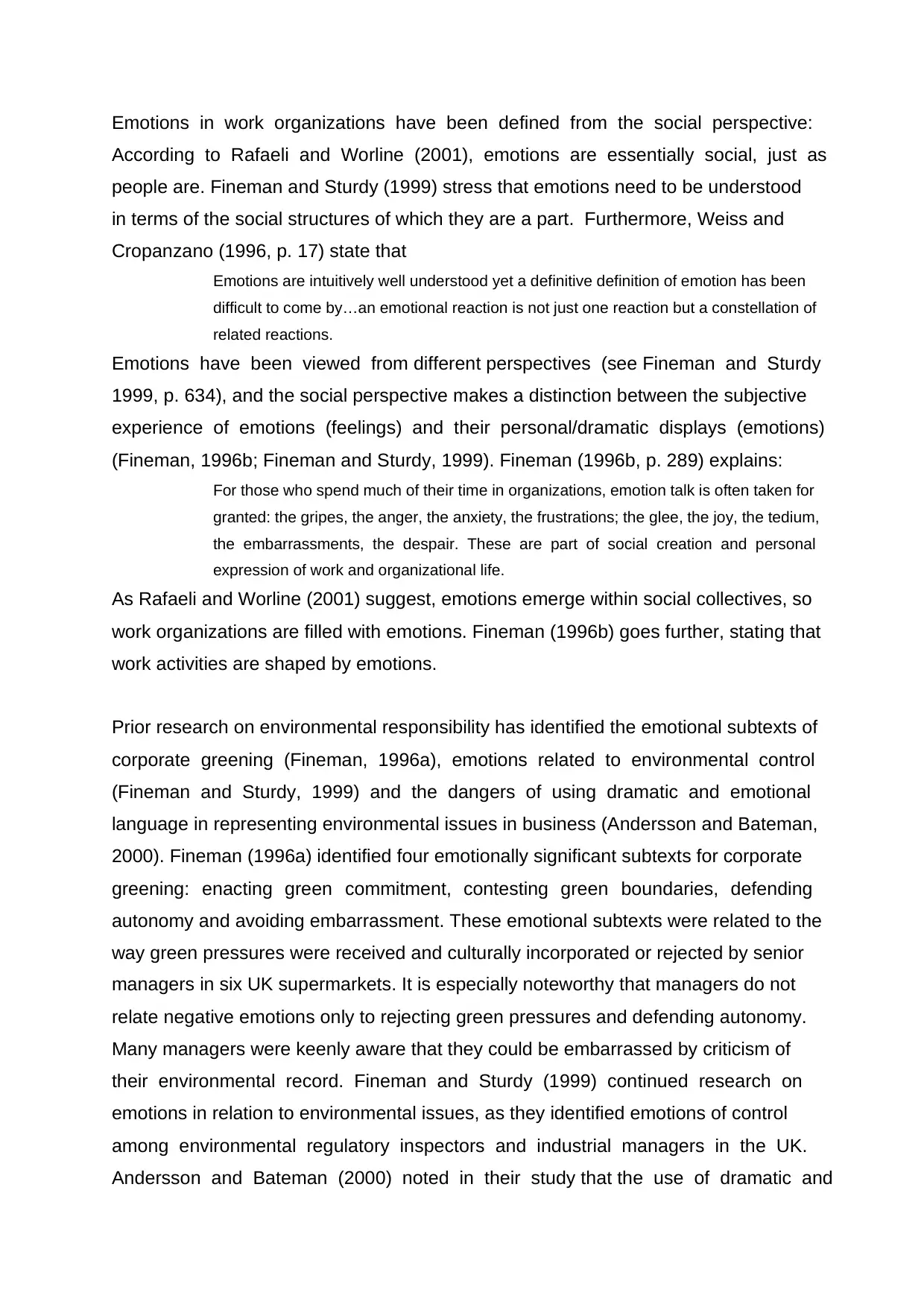
Emotions in work organizations have been defined from the social perspective:
According to Rafaeli and Worline (2001), emotions are essentially social, just as
people are. Fineman and Sturdy (1999) stress that emotions need to be understood
in terms of the social structures of which they are a part. Furthermore, Weiss and
Cropanzano (1996, p. 17) state that
Emotions are intuitively well understood yet a definitive definition of emotion has been
difficult to come by…an emotional reaction is not just one reaction but a constellation of
related reactions.
Emotions have been viewed from different perspectives (see Fineman and Sturdy
1999, p. 634), and the social perspective makes a distinction between the subjective
experience of emotions (feelings) and their personal/dramatic displays (emotions)
(Fineman, 1996b; Fineman and Sturdy, 1999). Fineman (1996b, p. 289) explains:
For those who spend much of their time in organizations, emotion talk is often taken for
granted: the gripes, the anger, the anxiety, the frustrations; the glee, the joy, the tedium,
the embarrassments, the despair. These are part of social creation and personal
expression of work and organizational life.
As Rafaeli and Worline (2001) suggest, emotions emerge within social collectives, so
work organizations are filled with emotions. Fineman (1996b) goes further, stating that
work activities are shaped by emotions.
Prior research on environmental responsibility has identified the emotional subtexts of
corporate greening (Fineman, 1996a), emotions related to environmental control
(Fineman and Sturdy, 1999) and the dangers of using dramatic and emotional
language in representing environmental issues in business (Andersson and Bateman,
2000). Fineman (1996a) identified four emotionally significant subtexts for corporate
greening: enacting green commitment, contesting green boundaries, defending
autonomy and avoiding embarrassment. These emotional subtexts were related to the
way green pressures were received and culturally incorporated or rejected by senior
managers in six UK supermarkets. It is especially noteworthy that managers do not
relate negative emotions only to rejecting green pressures and defending autonomy.
Many managers were keenly aware that they could be embarrassed by criticism of
their environmental record. Fineman and Sturdy (1999) continued research on
emotions in relation to environmental issues, as they identified emotions of control
among environmental regulatory inspectors and industrial managers in the UK.
Andersson and Bateman (2000) noted in their study that the use of dramatic and
According to Rafaeli and Worline (2001), emotions are essentially social, just as
people are. Fineman and Sturdy (1999) stress that emotions need to be understood
in terms of the social structures of which they are a part. Furthermore, Weiss and
Cropanzano (1996, p. 17) state that
Emotions are intuitively well understood yet a definitive definition of emotion has been
difficult to come by…an emotional reaction is not just one reaction but a constellation of
related reactions.
Emotions have been viewed from different perspectives (see Fineman and Sturdy
1999, p. 634), and the social perspective makes a distinction between the subjective
experience of emotions (feelings) and their personal/dramatic displays (emotions)
(Fineman, 1996b; Fineman and Sturdy, 1999). Fineman (1996b, p. 289) explains:
For those who spend much of their time in organizations, emotion talk is often taken for
granted: the gripes, the anger, the anxiety, the frustrations; the glee, the joy, the tedium,
the embarrassments, the despair. These are part of social creation and personal
expression of work and organizational life.
As Rafaeli and Worline (2001) suggest, emotions emerge within social collectives, so
work organizations are filled with emotions. Fineman (1996b) goes further, stating that
work activities are shaped by emotions.
Prior research on environmental responsibility has identified the emotional subtexts of
corporate greening (Fineman, 1996a), emotions related to environmental control
(Fineman and Sturdy, 1999) and the dangers of using dramatic and emotional
language in representing environmental issues in business (Andersson and Bateman,
2000). Fineman (1996a) identified four emotionally significant subtexts for corporate
greening: enacting green commitment, contesting green boundaries, defending
autonomy and avoiding embarrassment. These emotional subtexts were related to the
way green pressures were received and culturally incorporated or rejected by senior
managers in six UK supermarkets. It is especially noteworthy that managers do not
relate negative emotions only to rejecting green pressures and defending autonomy.
Many managers were keenly aware that they could be embarrassed by criticism of
their environmental record. Fineman and Sturdy (1999) continued research on
emotions in relation to environmental issues, as they identified emotions of control
among environmental regulatory inspectors and industrial managers in the UK.
Andersson and Bateman (2000) noted in their study that the use of dramatic and
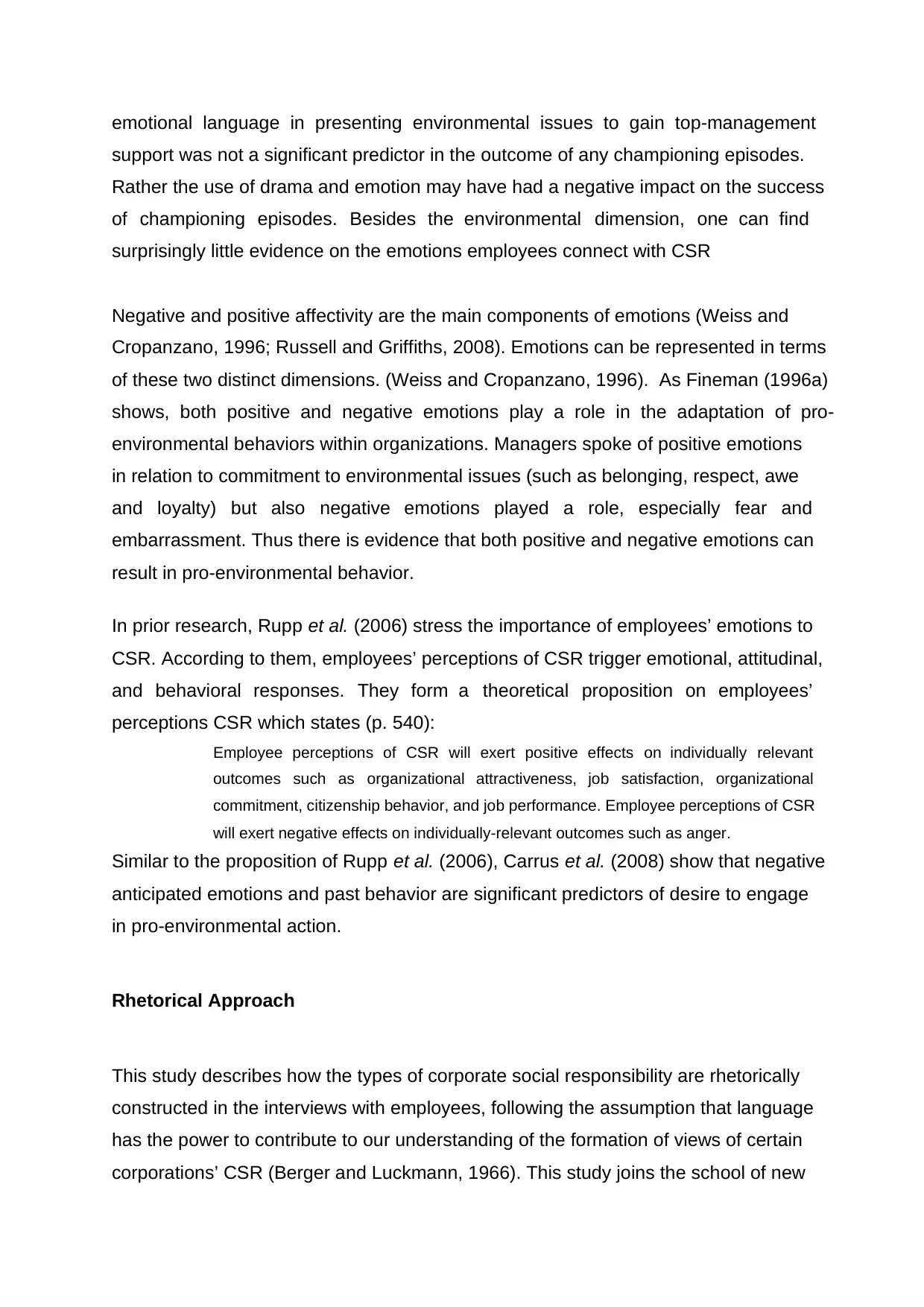
emotional language in presenting environmental issues to gain top-management
support was not a significant predictor in the outcome of any championing episodes.
Rather the use of drama and emotion may have had a negative impact on the success
of championing episodes. Besides the environmental dimension, one can find
surprisingly little evidence on the emotions employees connect with CSR
Negative and positive affectivity are the main components of emotions (Weiss and
Cropanzano, 1996; Russell and Griffiths, 2008). Emotions can be represented in terms
of these two distinct dimensions. (Weiss and Cropanzano, 1996). As Fineman (1996a)
shows, both positive and negative emotions play a role in the adaptation of pro-
environmental behaviors within organizations. Managers spoke of positive emotions
in relation to commitment to environmental issues (such as belonging, respect, awe
and loyalty) but also negative emotions played a role, especially fear and
embarrassment. Thus there is evidence that both positive and negative emotions can
result in pro-environmental behavior.
In prior research, Rupp et al. (2006) stress the importance of employees’ emotions to
CSR. According to them, employees’ perceptions of CSR trigger emotional, attitudinal,
and behavioral responses. They form a theoretical proposition on employees’
perceptions CSR which states (p. 540):
Employee perceptions of CSR will exert positive effects on individually relevant
outcomes such as organizational attractiveness, job satisfaction, organizational
commitment, citizenship behavior, and job performance. Employee perceptions of CSR
will exert negative effects on individually-relevant outcomes such as anger.
Similar to the proposition of Rupp et al. (2006), Carrus et al. (2008) show that negative
anticipated emotions and past behavior are significant predictors of desire to engage
in pro-environmental action.
Rhetorical Approach
This study describes how the types of corporate social responsibility are rhetorically
constructed in the interviews with employees, following the assumption that language
has the power to contribute to our understanding of the formation of views of certain
corporations’ CSR (Berger and Luckmann, 1966). This study joins the school of new
support was not a significant predictor in the outcome of any championing episodes.
Rather the use of drama and emotion may have had a negative impact on the success
of championing episodes. Besides the environmental dimension, one can find
surprisingly little evidence on the emotions employees connect with CSR
Negative and positive affectivity are the main components of emotions (Weiss and
Cropanzano, 1996; Russell and Griffiths, 2008). Emotions can be represented in terms
of these two distinct dimensions. (Weiss and Cropanzano, 1996). As Fineman (1996a)
shows, both positive and negative emotions play a role in the adaptation of pro-
environmental behaviors within organizations. Managers spoke of positive emotions
in relation to commitment to environmental issues (such as belonging, respect, awe
and loyalty) but also negative emotions played a role, especially fear and
embarrassment. Thus there is evidence that both positive and negative emotions can
result in pro-environmental behavior.
In prior research, Rupp et al. (2006) stress the importance of employees’ emotions to
CSR. According to them, employees’ perceptions of CSR trigger emotional, attitudinal,
and behavioral responses. They form a theoretical proposition on employees’
perceptions CSR which states (p. 540):
Employee perceptions of CSR will exert positive effects on individually relevant
outcomes such as organizational attractiveness, job satisfaction, organizational
commitment, citizenship behavior, and job performance. Employee perceptions of CSR
will exert negative effects on individually-relevant outcomes such as anger.
Similar to the proposition of Rupp et al. (2006), Carrus et al. (2008) show that negative
anticipated emotions and past behavior are significant predictors of desire to engage
in pro-environmental action.
Rhetorical Approach
This study describes how the types of corporate social responsibility are rhetorically
constructed in the interviews with employees, following the assumption that language
has the power to contribute to our understanding of the formation of views of certain
corporations’ CSR (Berger and Luckmann, 1966). This study joins the school of new
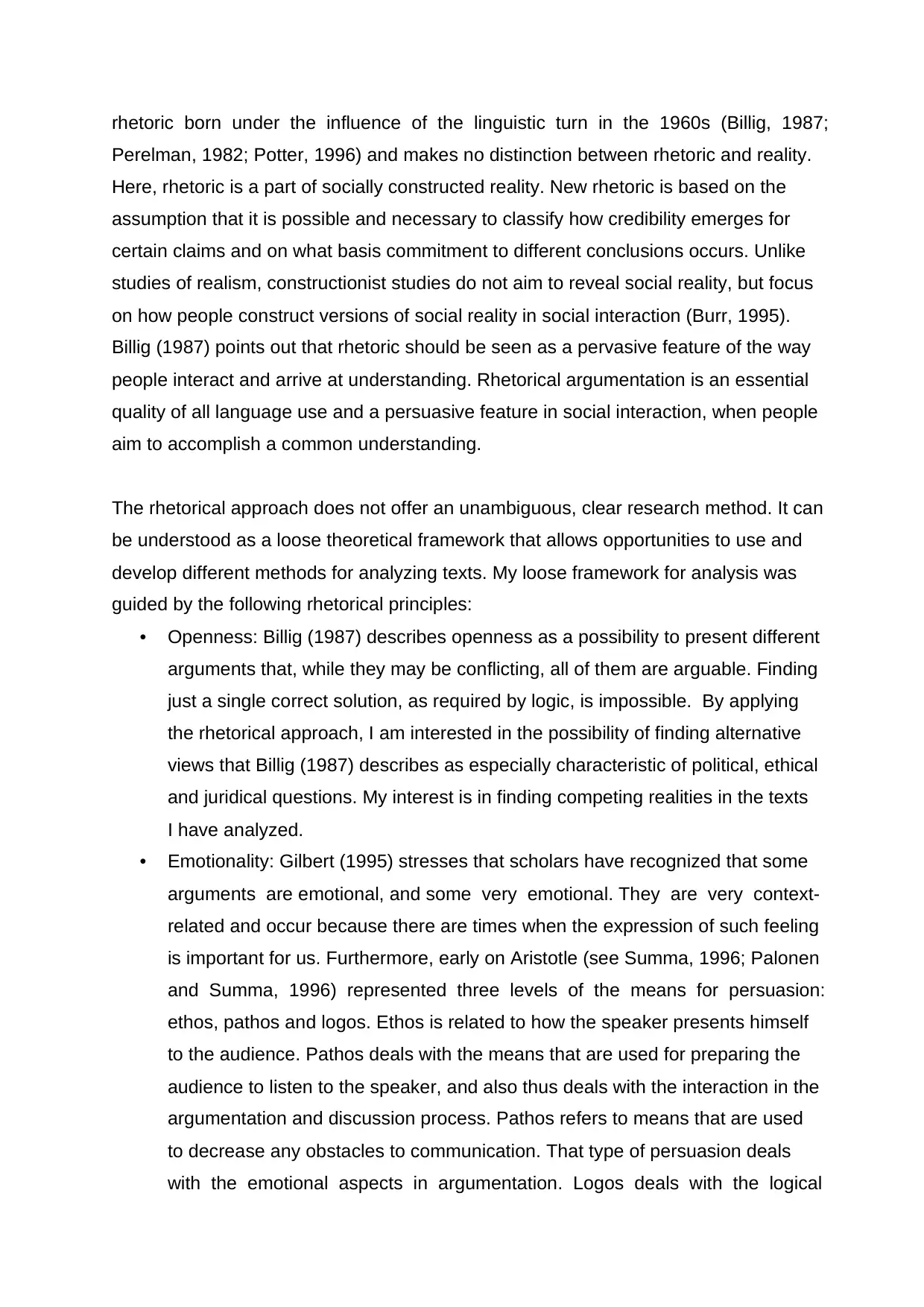
rhetoric born under the influence of the linguistic turn in the 1960s (Billig, 1987;
Perelman, 1982; Potter, 1996) and makes no distinction between rhetoric and reality.
Here, rhetoric is a part of socially constructed reality. New rhetoric is based on the
assumption that it is possible and necessary to classify how credibility emerges for
certain claims and on what basis commitment to different conclusions occurs. Unlike
studies of realism, constructionist studies do not aim to reveal social reality, but focus
on how people construct versions of social reality in social interaction (Burr, 1995).
Billig (1987) points out that rhetoric should be seen as a pervasive feature of the way
people interact and arrive at understanding. Rhetorical argumentation is an essential
quality of all language use and a persuasive feature in social interaction, when people
aim to accomplish a common understanding.
The rhetorical approach does not offer an unambiguous, clear research method. It can
be understood as a loose theoretical framework that allows opportunities to use and
develop different methods for analyzing texts. My loose framework for analysis was
guided by the following rhetorical principles:
• Openness: Billig (1987) describes openness as a possibility to present different
arguments that, while they may be conflicting, all of them are arguable. Finding
just a single correct solution, as required by logic, is impossible. By applying
the rhetorical approach, I am interested in the possibility of finding alternative
views that Billig (1987) describes as especially characteristic of political, ethical
and juridical questions. My interest is in finding competing realities in the texts
I have analyzed.
• Emotionality: Gilbert (1995) stresses that scholars have recognized that some
arguments are emotional, and some very emotional. They are very context-
related and occur because there are times when the expression of such feeling
is important for us. Furthermore, early on Aristotle (see Summa, 1996; Palonen
and Summa, 1996) represented three levels of the means for persuasion:
ethos, pathos and logos. Ethos is related to how the speaker presents himself
to the audience. Pathos deals with the means that are used for preparing the
audience to listen to the speaker, and also thus deals with the interaction in the
argumentation and discussion process. Pathos refers to means that are used
to decrease any obstacles to communication. That type of persuasion deals
with the emotional aspects in argumentation. Logos deals with the logical
Perelman, 1982; Potter, 1996) and makes no distinction between rhetoric and reality.
Here, rhetoric is a part of socially constructed reality. New rhetoric is based on the
assumption that it is possible and necessary to classify how credibility emerges for
certain claims and on what basis commitment to different conclusions occurs. Unlike
studies of realism, constructionist studies do not aim to reveal social reality, but focus
on how people construct versions of social reality in social interaction (Burr, 1995).
Billig (1987) points out that rhetoric should be seen as a pervasive feature of the way
people interact and arrive at understanding. Rhetorical argumentation is an essential
quality of all language use and a persuasive feature in social interaction, when people
aim to accomplish a common understanding.
The rhetorical approach does not offer an unambiguous, clear research method. It can
be understood as a loose theoretical framework that allows opportunities to use and
develop different methods for analyzing texts. My loose framework for analysis was
guided by the following rhetorical principles:
• Openness: Billig (1987) describes openness as a possibility to present different
arguments that, while they may be conflicting, all of them are arguable. Finding
just a single correct solution, as required by logic, is impossible. By applying
the rhetorical approach, I am interested in the possibility of finding alternative
views that Billig (1987) describes as especially characteristic of political, ethical
and juridical questions. My interest is in finding competing realities in the texts
I have analyzed.
• Emotionality: Gilbert (1995) stresses that scholars have recognized that some
arguments are emotional, and some very emotional. They are very context-
related and occur because there are times when the expression of such feeling
is important for us. Furthermore, early on Aristotle (see Summa, 1996; Palonen
and Summa, 1996) represented three levels of the means for persuasion:
ethos, pathos and logos. Ethos is related to how the speaker presents himself
to the audience. Pathos deals with the means that are used for preparing the
audience to listen to the speaker, and also thus deals with the interaction in the
argumentation and discussion process. Pathos refers to means that are used
to decrease any obstacles to communication. That type of persuasion deals
with the emotional aspects in argumentation. Logos deals with the logical
Secure Best Marks with AI Grader
Need help grading? Try our AI Grader for instant feedback on your assignments.
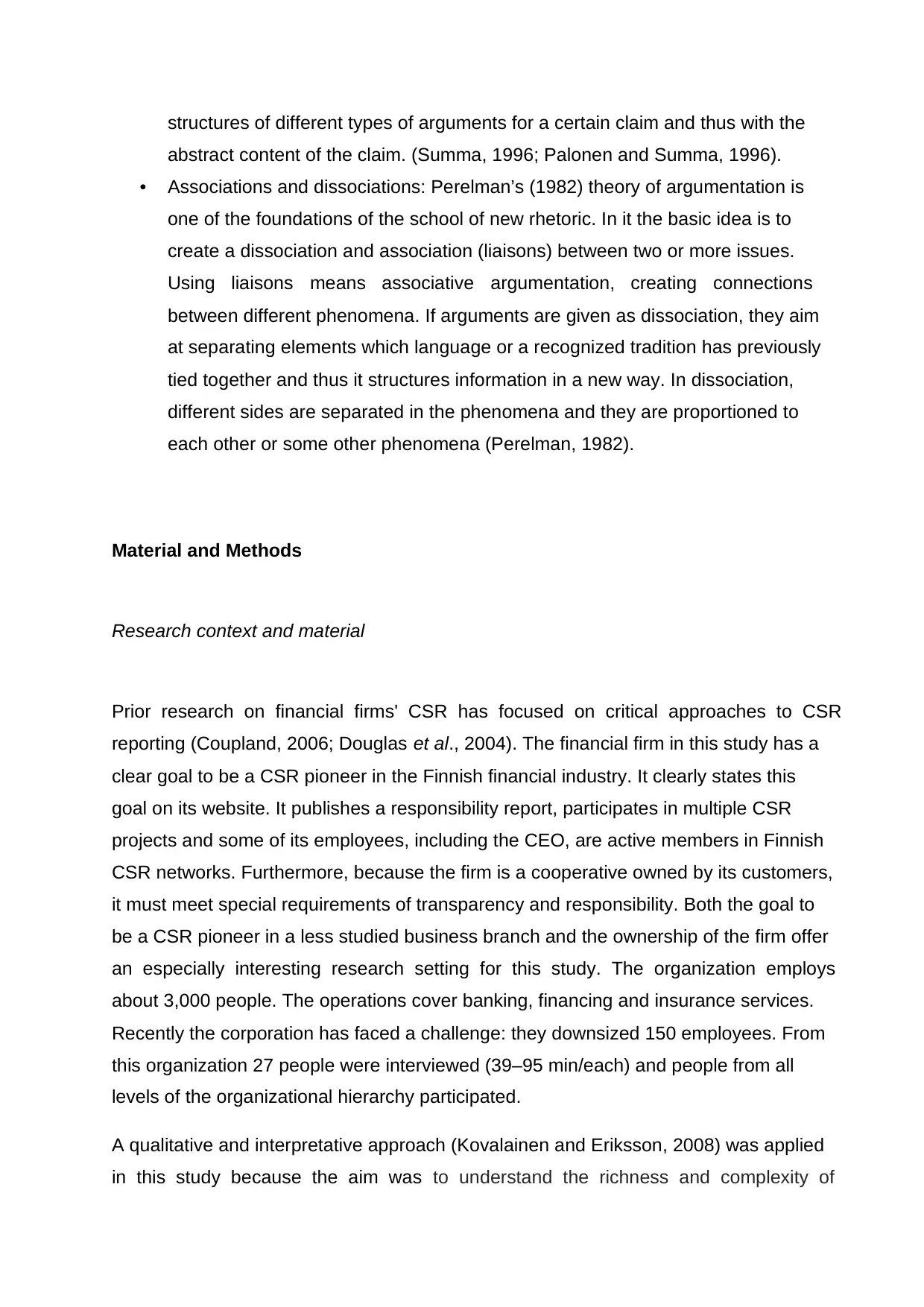
structures of different types of arguments for a certain claim and thus with the
abstract content of the claim. (Summa, 1996; Palonen and Summa, 1996).
• Associations and dissociations: Perelman’s (1982) theory of argumentation is
one of the foundations of the school of new rhetoric. In it the basic idea is to
create a dissociation and association (liaisons) between two or more issues.
Using liaisons means associative argumentation, creating connections
between different phenomena. If arguments are given as dissociation, they aim
at separating elements which language or a recognized tradition has previously
tied together and thus it structures information in a new way. In dissociation,
different sides are separated in the phenomena and they are proportioned to
each other or some other phenomena (Perelman, 1982).
Material and Methods
Research context and material
Prior research on financial firms' CSR has focused on critical approaches to CSR
reporting (Coupland, 2006; Douglas et al., 2004). The financial firm in this study has a
clear goal to be a CSR pioneer in the Finnish financial industry. It clearly states this
goal on its website. It publishes a responsibility report, participates in multiple CSR
projects and some of its employees, including the CEO, are active members in Finnish
CSR networks. Furthermore, because the firm is a cooperative owned by its customers,
it must meet special requirements of transparency and responsibility. Both the goal to
be a CSR pioneer in a less studied business branch and the ownership of the firm offer
an especially interesting research setting for this study. The organization employs
about 3,000 people. The operations cover banking, financing and insurance services.
Recently the corporation has faced a challenge: they downsized 150 employees. From
this organization 27 people were interviewed (39–95 min/each) and people from all
levels of the organizational hierarchy participated.
A qualitative and interpretative approach (Kovalainen and Eriksson, 2008) was applied
in this study because the aim was to understand the richness and complexity of
abstract content of the claim. (Summa, 1996; Palonen and Summa, 1996).
• Associations and dissociations: Perelman’s (1982) theory of argumentation is
one of the foundations of the school of new rhetoric. In it the basic idea is to
create a dissociation and association (liaisons) between two or more issues.
Using liaisons means associative argumentation, creating connections
between different phenomena. If arguments are given as dissociation, they aim
at separating elements which language or a recognized tradition has previously
tied together and thus it structures information in a new way. In dissociation,
different sides are separated in the phenomena and they are proportioned to
each other or some other phenomena (Perelman, 1982).
Material and Methods
Research context and material
Prior research on financial firms' CSR has focused on critical approaches to CSR
reporting (Coupland, 2006; Douglas et al., 2004). The financial firm in this study has a
clear goal to be a CSR pioneer in the Finnish financial industry. It clearly states this
goal on its website. It publishes a responsibility report, participates in multiple CSR
projects and some of its employees, including the CEO, are active members in Finnish
CSR networks. Furthermore, because the firm is a cooperative owned by its customers,
it must meet special requirements of transparency and responsibility. Both the goal to
be a CSR pioneer in a less studied business branch and the ownership of the firm offer
an especially interesting research setting for this study. The organization employs
about 3,000 people. The operations cover banking, financing and insurance services.
Recently the corporation has faced a challenge: they downsized 150 employees. From
this organization 27 people were interviewed (39–95 min/each) and people from all
levels of the organizational hierarchy participated.
A qualitative and interpretative approach (Kovalainen and Eriksson, 2008) was applied
in this study because the aim was to understand the richness and complexity of
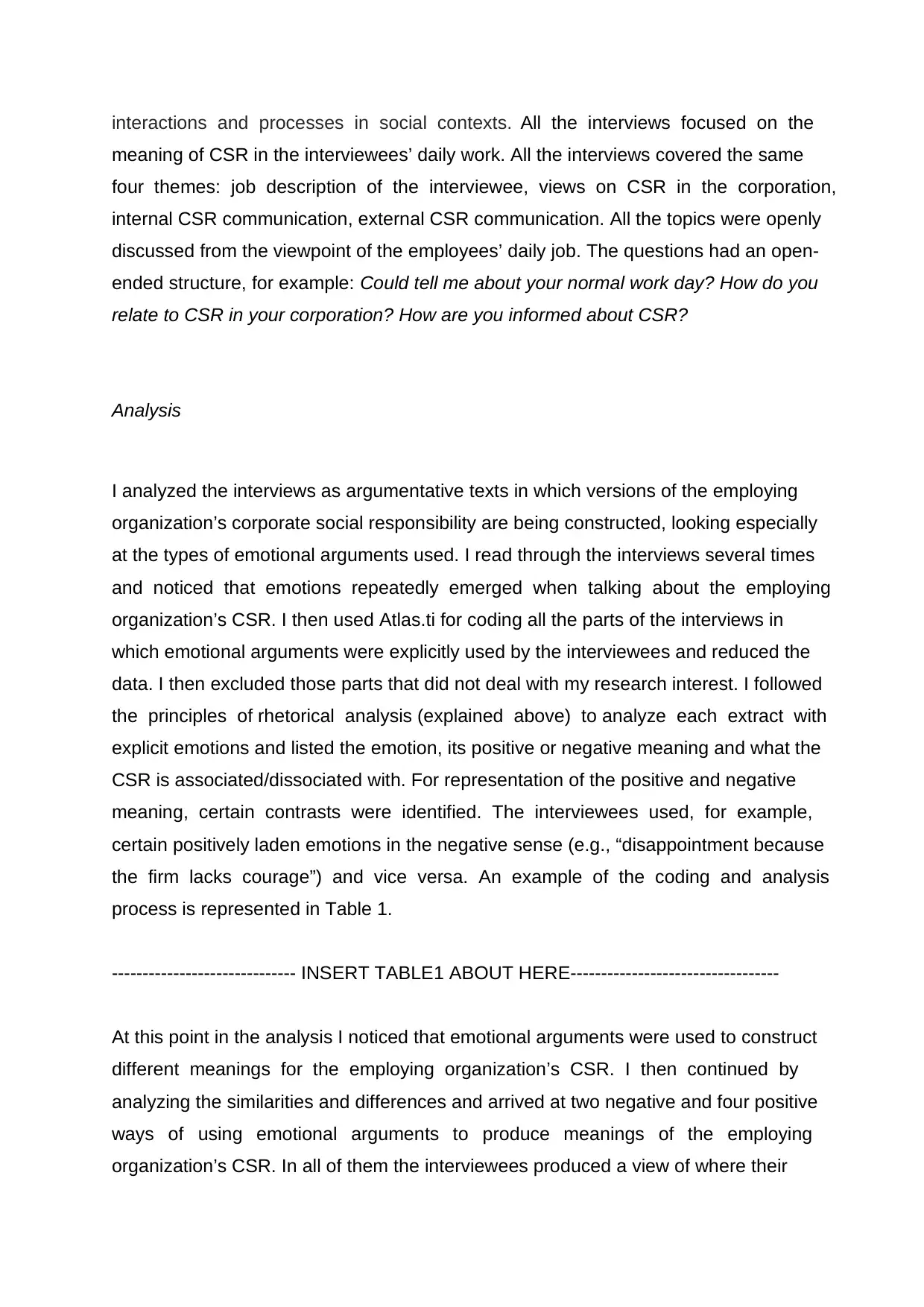
interactions and processes in social contexts. All the interviews focused on the
meaning of CSR in the interviewees’ daily work. All the interviews covered the same
four themes: job description of the interviewee, views on CSR in the corporation,
internal CSR communication, external CSR communication. All the topics were openly
discussed from the viewpoint of the employees’ daily job. The questions had an open-
ended structure, for example: Could tell me about your normal work day? How do you
relate to CSR in your corporation? How are you informed about CSR?
Analysis
I analyzed the interviews as argumentative texts in which versions of the employing
organization’s corporate social responsibility are being constructed, looking especially
at the types of emotional arguments used. I read through the interviews several times
and noticed that emotions repeatedly emerged when talking about the employing
organization’s CSR. I then used Atlas.ti for coding all the parts of the interviews in
which emotional arguments were explicitly used by the interviewees and reduced the
data. I then excluded those parts that did not deal with my research interest. I followed
the principles of rhetorical analysis (explained above) to analyze each extract with
explicit emotions and listed the emotion, its positive or negative meaning and what the
CSR is associated/dissociated with. For representation of the positive and negative
meaning, certain contrasts were identified. The interviewees used, for example,
certain positively laden emotions in the negative sense (e.g., “disappointment because
the firm lacks courage”) and vice versa. An example of the coding and analysis
process is represented in Table 1.
------------------------------ INSERT TABLE1 ABOUT HERE----------------------------------
At this point in the analysis I noticed that emotional arguments were used to construct
different meanings for the employing organization’s CSR. I then continued by
analyzing the similarities and differences and arrived at two negative and four positive
ways of using emotional arguments to produce meanings of the employing
organization’s CSR. In all of them the interviewees produced a view of where their
meaning of CSR in the interviewees’ daily work. All the interviews covered the same
four themes: job description of the interviewee, views on CSR in the corporation,
internal CSR communication, external CSR communication. All the topics were openly
discussed from the viewpoint of the employees’ daily job. The questions had an open-
ended structure, for example: Could tell me about your normal work day? How do you
relate to CSR in your corporation? How are you informed about CSR?
Analysis
I analyzed the interviews as argumentative texts in which versions of the employing
organization’s corporate social responsibility are being constructed, looking especially
at the types of emotional arguments used. I read through the interviews several times
and noticed that emotions repeatedly emerged when talking about the employing
organization’s CSR. I then used Atlas.ti for coding all the parts of the interviews in
which emotional arguments were explicitly used by the interviewees and reduced the
data. I then excluded those parts that did not deal with my research interest. I followed
the principles of rhetorical analysis (explained above) to analyze each extract with
explicit emotions and listed the emotion, its positive or negative meaning and what the
CSR is associated/dissociated with. For representation of the positive and negative
meaning, certain contrasts were identified. The interviewees used, for example,
certain positively laden emotions in the negative sense (e.g., “disappointment because
the firm lacks courage”) and vice versa. An example of the coding and analysis
process is represented in Table 1.
------------------------------ INSERT TABLE1 ABOUT HERE----------------------------------
At this point in the analysis I noticed that emotional arguments were used to construct
different meanings for the employing organization’s CSR. I then continued by
analyzing the similarities and differences and arrived at two negative and four positive
ways of using emotional arguments to produce meanings of the employing
organization’s CSR. In all of them the interviewees produced a view of where their
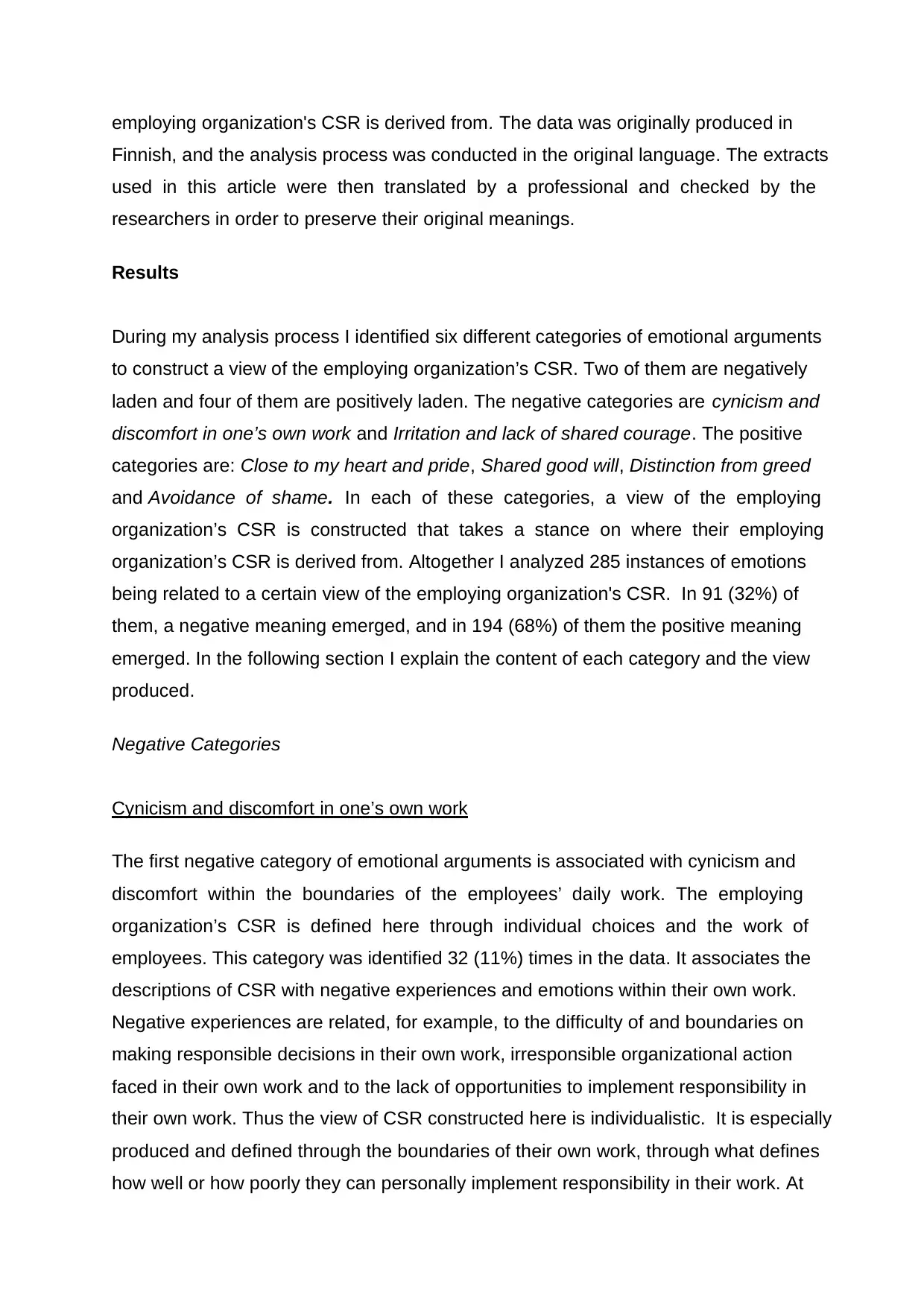
employing organization's CSR is derived from. The data was originally produced in
Finnish, and the analysis process was conducted in the original language. The extracts
used in this article were then translated by a professional and checked by the
researchers in order to preserve their original meanings.
Results
During my analysis process I identified six different categories of emotional arguments
to construct a view of the employing organization’s CSR. Two of them are negatively
laden and four of them are positively laden. The negative categories are cynicism and
discomfort in one’s own work and Irritation and lack of shared courage. The positive
categories are: Close to my heart and pride, Shared good will, Distinction from greed
and Avoidance of shame. In each of these categories, a view of the employing
organization’s CSR is constructed that takes a stance on where their employing
organization’s CSR is derived from. Altogether I analyzed 285 instances of emotions
being related to a certain view of the employing organization's CSR. In 91 (32%) of
them, a negative meaning emerged, and in 194 (68%) of them the positive meaning
emerged. In the following section I explain the content of each category and the view
produced.
Negative Categories
Cynicism and discomfort in one’s own work
The first negative category of emotional arguments is associated with cynicism and
discomfort within the boundaries of the employees’ daily work. The employing
organization’s CSR is defined here through individual choices and the work of
employees. This category was identified 32 (11%) times in the data. It associates the
descriptions of CSR with negative experiences and emotions within their own work.
Negative experiences are related, for example, to the difficulty of and boundaries on
making responsible decisions in their own work, irresponsible organizational action
faced in their own work and to the lack of opportunities to implement responsibility in
their own work. Thus the view of CSR constructed here is individualistic. It is especially
produced and defined through the boundaries of their own work, through what defines
how well or how poorly they can personally implement responsibility in their work. At
Finnish, and the analysis process was conducted in the original language. The extracts
used in this article were then translated by a professional and checked by the
researchers in order to preserve their original meanings.
Results
During my analysis process I identified six different categories of emotional arguments
to construct a view of the employing organization’s CSR. Two of them are negatively
laden and four of them are positively laden. The negative categories are cynicism and
discomfort in one’s own work and Irritation and lack of shared courage. The positive
categories are: Close to my heart and pride, Shared good will, Distinction from greed
and Avoidance of shame. In each of these categories, a view of the employing
organization’s CSR is constructed that takes a stance on where their employing
organization’s CSR is derived from. Altogether I analyzed 285 instances of emotions
being related to a certain view of the employing organization's CSR. In 91 (32%) of
them, a negative meaning emerged, and in 194 (68%) of them the positive meaning
emerged. In the following section I explain the content of each category and the view
produced.
Negative Categories
Cynicism and discomfort in one’s own work
The first negative category of emotional arguments is associated with cynicism and
discomfort within the boundaries of the employees’ daily work. The employing
organization’s CSR is defined here through individual choices and the work of
employees. This category was identified 32 (11%) times in the data. It associates the
descriptions of CSR with negative experiences and emotions within their own work.
Negative experiences are related, for example, to the difficulty of and boundaries on
making responsible decisions in their own work, irresponsible organizational action
faced in their own work and to the lack of opportunities to implement responsibility in
their own work. Thus the view of CSR constructed here is individualistic. It is especially
produced and defined through the boundaries of their own work, through what defines
how well or how poorly they can personally implement responsibility in their work. At
Paraphrase This Document
Need a fresh take? Get an instant paraphrase of this document with our AI Paraphraser
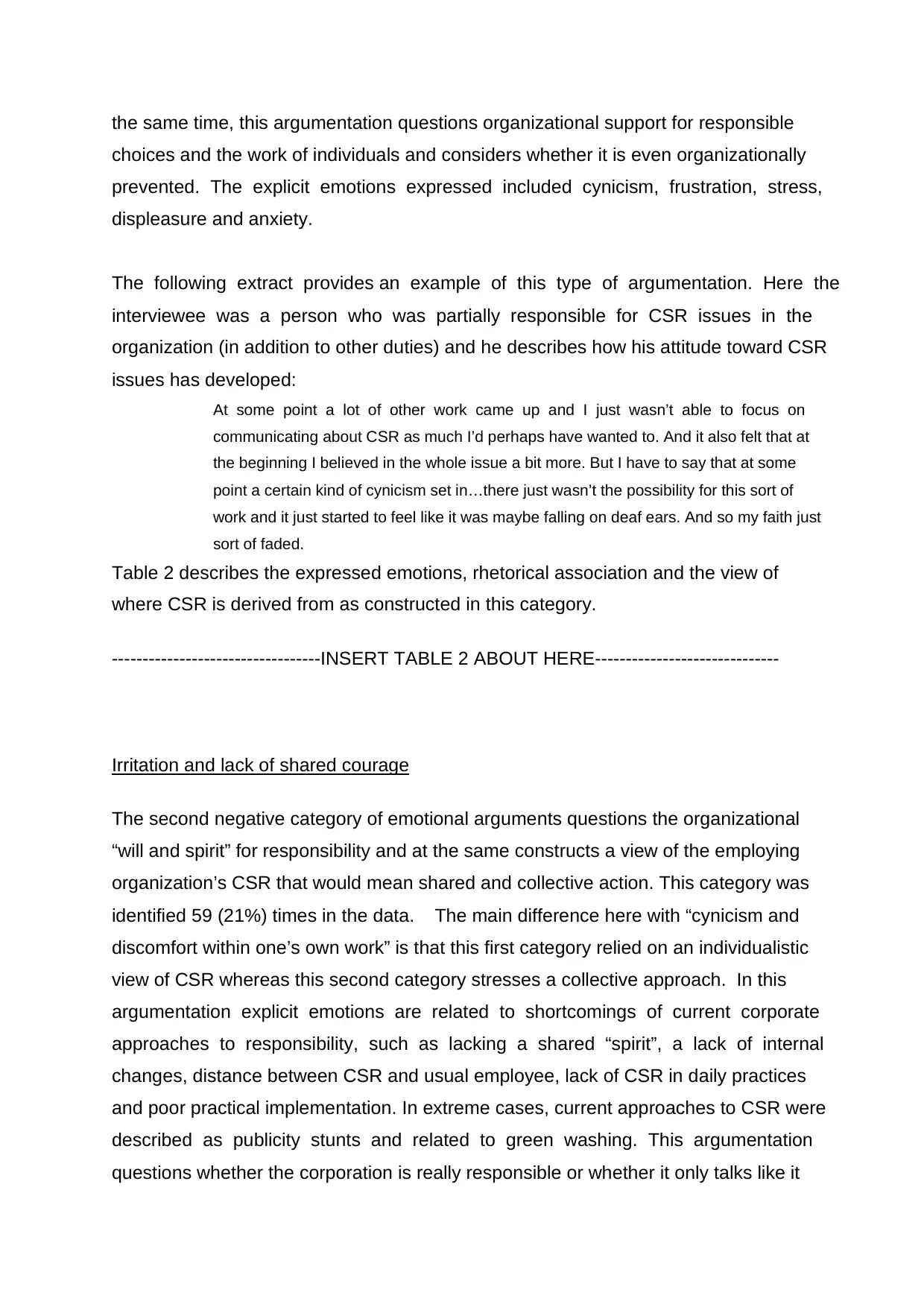
the same time, this argumentation questions organizational support for responsible
choices and the work of individuals and considers whether it is even organizationally
prevented. The explicit emotions expressed included cynicism, frustration, stress,
displeasure and anxiety.
The following extract provides an example of this type of argumentation. Here the
interviewee was a person who was partially responsible for CSR issues in the
organization (in addition to other duties) and he describes how his attitude toward CSR
issues has developed:
At some point a lot of other work came up and I just wasn’t able to focus on
communicating about CSR as much I’d perhaps have wanted to. And it also felt that at
the beginning I believed in the whole issue a bit more. But I have to say that at some
point a certain kind of cynicism set in…there just wasn’t the possibility for this sort of
work and it just started to feel like it was maybe falling on deaf ears. And so my faith just
sort of faded.
Table 2 describes the expressed emotions, rhetorical association and the view of
where CSR is derived from as constructed in this category.
----------------------------------INSERT TABLE 2 ABOUT HERE------------------------------
Irritation and lack of shared courage
The second negative category of emotional arguments questions the organizational
“will and spirit” for responsibility and at the same constructs a view of the employing
organization’s CSR that would mean shared and collective action. This category was
identified 59 (21%) times in the data. The main difference here with “cynicism and
discomfort within one’s own work” is that this first category relied on an individualistic
view of CSR whereas this second category stresses a collective approach. In this
argumentation explicit emotions are related to shortcomings of current corporate
approaches to responsibility, such as lacking a shared “spirit”, a lack of internal
changes, distance between CSR and usual employee, lack of CSR in daily practices
and poor practical implementation. In extreme cases, current approaches to CSR were
described as publicity stunts and related to green washing. This argumentation
questions whether the corporation is really responsible or whether it only talks like it
choices and the work of individuals and considers whether it is even organizationally
prevented. The explicit emotions expressed included cynicism, frustration, stress,
displeasure and anxiety.
The following extract provides an example of this type of argumentation. Here the
interviewee was a person who was partially responsible for CSR issues in the
organization (in addition to other duties) and he describes how his attitude toward CSR
issues has developed:
At some point a lot of other work came up and I just wasn’t able to focus on
communicating about CSR as much I’d perhaps have wanted to. And it also felt that at
the beginning I believed in the whole issue a bit more. But I have to say that at some
point a certain kind of cynicism set in…there just wasn’t the possibility for this sort of
work and it just started to feel like it was maybe falling on deaf ears. And so my faith just
sort of faded.
Table 2 describes the expressed emotions, rhetorical association and the view of
where CSR is derived from as constructed in this category.
----------------------------------INSERT TABLE 2 ABOUT HERE------------------------------
Irritation and lack of shared courage
The second negative category of emotional arguments questions the organizational
“will and spirit” for responsibility and at the same constructs a view of the employing
organization’s CSR that would mean shared and collective action. This category was
identified 59 (21%) times in the data. The main difference here with “cynicism and
discomfort within one’s own work” is that this first category relied on an individualistic
view of CSR whereas this second category stresses a collective approach. In this
argumentation explicit emotions are related to shortcomings of current corporate
approaches to responsibility, such as lacking a shared “spirit”, a lack of internal
changes, distance between CSR and usual employee, lack of CSR in daily practices
and poor practical implementation. In extreme cases, current approaches to CSR were
described as publicity stunts and related to green washing. This argumentation
questions whether the corporation is really responsible or whether it only talks like it
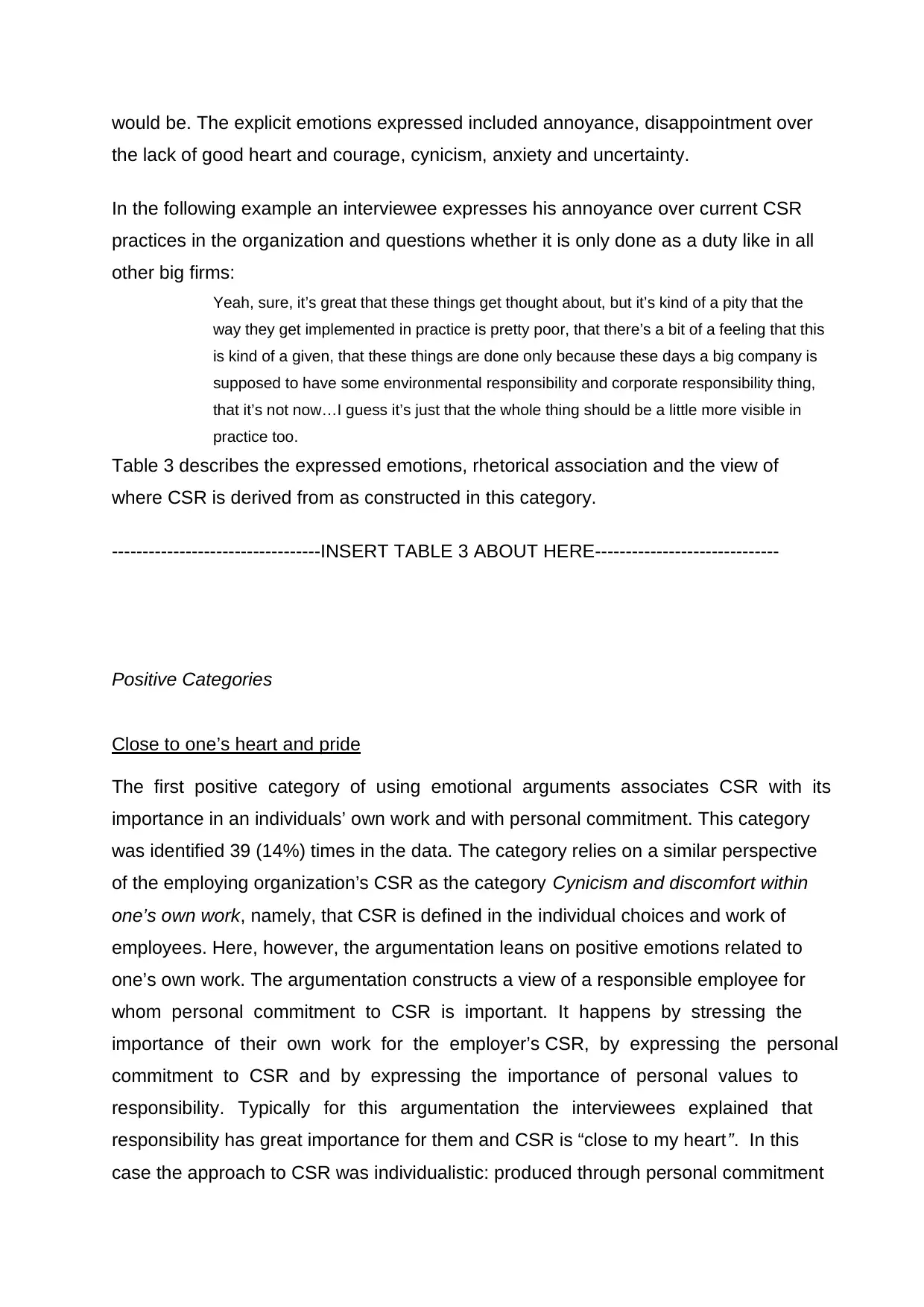
would be. The explicit emotions expressed included annoyance, disappointment over
the lack of good heart and courage, cynicism, anxiety and uncertainty.
In the following example an interviewee expresses his annoyance over current CSR
practices in the organization and questions whether it is only done as a duty like in all
other big firms:
Yeah, sure, it’s great that these things get thought about, but it’s kind of a pity that the
way they get implemented in practice is pretty poor, that there’s a bit of a feeling that this
is kind of a given, that these things are done only because these days a big company is
supposed to have some environmental responsibility and corporate responsibility thing,
that it’s not now…I guess it’s just that the whole thing should be a little more visible in
practice too.
Table 3 describes the expressed emotions, rhetorical association and the view of
where CSR is derived from as constructed in this category.
----------------------------------INSERT TABLE 3 ABOUT HERE------------------------------
Positive Categories
Close to one’s heart and pride
The first positive category of using emotional arguments associates CSR with its
importance in an individuals’ own work and with personal commitment. This category
was identified 39 (14%) times in the data. The category relies on a similar perspective
of the employing organization’s CSR as the category Cynicism and discomfort within
one’s own work, namely, that CSR is defined in the individual choices and work of
employees. Here, however, the argumentation leans on positive emotions related to
one’s own work. The argumentation constructs a view of a responsible employee for
whom personal commitment to CSR is important. It happens by stressing the
importance of their own work for the employer’s CSR, by expressing the personal
commitment to CSR and by expressing the importance of personal values to
responsibility. Typically for this argumentation the interviewees explained that
responsibility has great importance for them and CSR is “close to my heart”. In this
case the approach to CSR was individualistic: produced through personal commitment
the lack of good heart and courage, cynicism, anxiety and uncertainty.
In the following example an interviewee expresses his annoyance over current CSR
practices in the organization and questions whether it is only done as a duty like in all
other big firms:
Yeah, sure, it’s great that these things get thought about, but it’s kind of a pity that the
way they get implemented in practice is pretty poor, that there’s a bit of a feeling that this
is kind of a given, that these things are done only because these days a big company is
supposed to have some environmental responsibility and corporate responsibility thing,
that it’s not now…I guess it’s just that the whole thing should be a little more visible in
practice too.
Table 3 describes the expressed emotions, rhetorical association and the view of
where CSR is derived from as constructed in this category.
----------------------------------INSERT TABLE 3 ABOUT HERE------------------------------
Positive Categories
Close to one’s heart and pride
The first positive category of using emotional arguments associates CSR with its
importance in an individuals’ own work and with personal commitment. This category
was identified 39 (14%) times in the data. The category relies on a similar perspective
of the employing organization’s CSR as the category Cynicism and discomfort within
one’s own work, namely, that CSR is defined in the individual choices and work of
employees. Here, however, the argumentation leans on positive emotions related to
one’s own work. The argumentation constructs a view of a responsible employee for
whom personal commitment to CSR is important. It happens by stressing the
importance of their own work for the employer’s CSR, by expressing the personal
commitment to CSR and by expressing the importance of personal values to
responsibility. Typically for this argumentation the interviewees explained that
responsibility has great importance for them and CSR is “close to my heart”. In this
case the approach to CSR was individualistic: produced through personal commitment
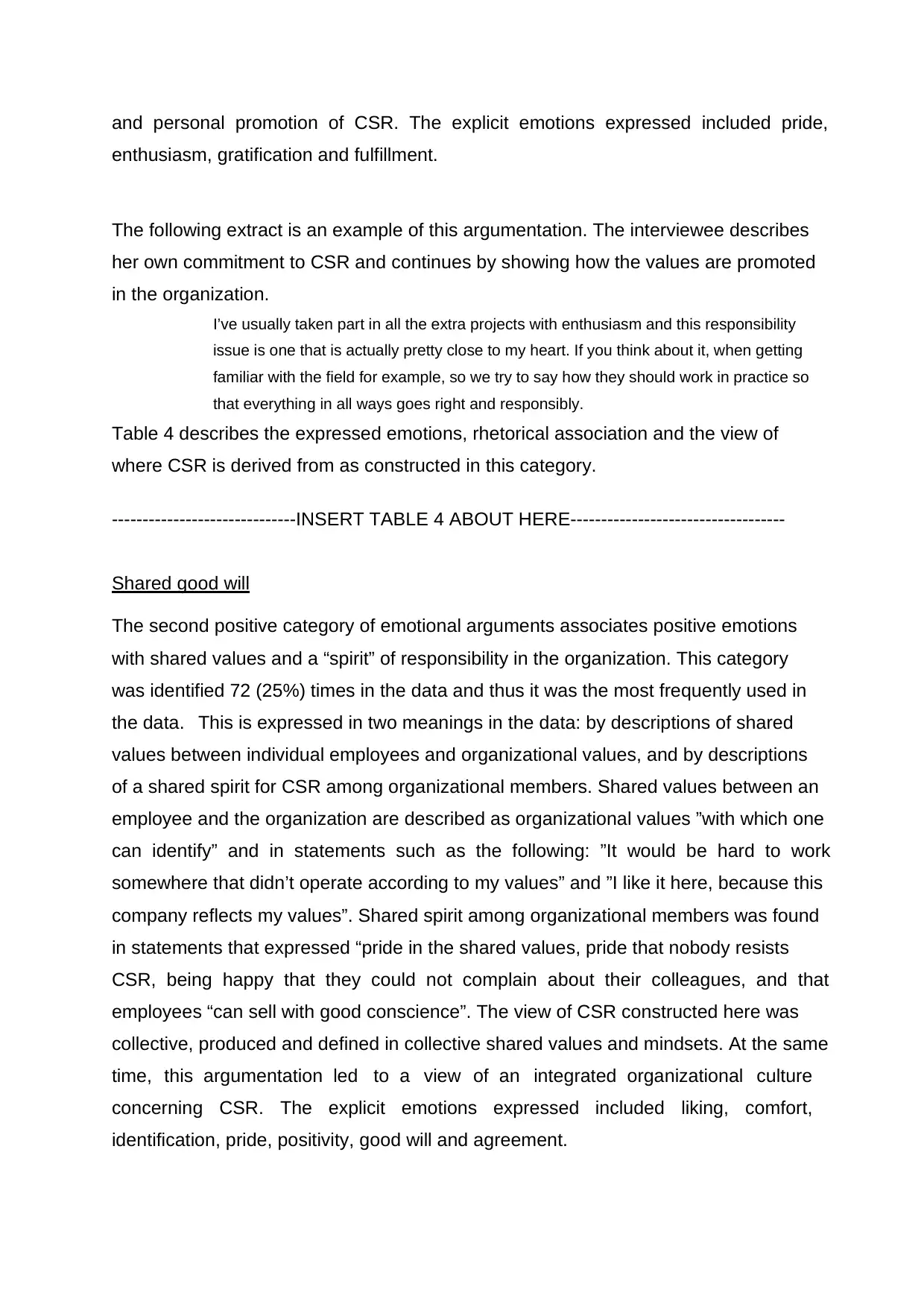
and personal promotion of CSR. The explicit emotions expressed included pride,
enthusiasm, gratification and fulfillment.
The following extract is an example of this argumentation. The interviewee describes
her own commitment to CSR and continues by showing how the values are promoted
in the organization.
I’ve usually taken part in all the extra projects with enthusiasm and this responsibility
issue is one that is actually pretty close to my heart. If you think about it, when getting
familiar with the field for example, so we try to say how they should work in practice so
that everything in all ways goes right and responsibly.
Table 4 describes the expressed emotions, rhetorical association and the view of
where CSR is derived from as constructed in this category.
------------------------------INSERT TABLE 4 ABOUT HERE-----------------------------------
Shared good will
The second positive category of emotional arguments associates positive emotions
with shared values and a “spirit” of responsibility in the organization. This category
was identified 72 (25%) times in the data and thus it was the most frequently used in
the data. This is expressed in two meanings in the data: by descriptions of shared
values between individual employees and organizational values, and by descriptions
of a shared spirit for CSR among organizational members. Shared values between an
employee and the organization are described as organizational values ”with which one
can identify” and in statements such as the following: ”It would be hard to work
somewhere that didn’t operate according to my values” and ”I like it here, because this
company reflects my values”. Shared spirit among organizational members was found
in statements that expressed “pride in the shared values, pride that nobody resists
CSR, being happy that they could not complain about their colleagues, and that
employees “can sell with good conscience”. The view of CSR constructed here was
collective, produced and defined in collective shared values and mindsets. At the same
time, this argumentation led to a view of an integrated organizational culture
concerning CSR. The explicit emotions expressed included liking, comfort,
identification, pride, positivity, good will and agreement.
enthusiasm, gratification and fulfillment.
The following extract is an example of this argumentation. The interviewee describes
her own commitment to CSR and continues by showing how the values are promoted
in the organization.
I’ve usually taken part in all the extra projects with enthusiasm and this responsibility
issue is one that is actually pretty close to my heart. If you think about it, when getting
familiar with the field for example, so we try to say how they should work in practice so
that everything in all ways goes right and responsibly.
Table 4 describes the expressed emotions, rhetorical association and the view of
where CSR is derived from as constructed in this category.
------------------------------INSERT TABLE 4 ABOUT HERE-----------------------------------
Shared good will
The second positive category of emotional arguments associates positive emotions
with shared values and a “spirit” of responsibility in the organization. This category
was identified 72 (25%) times in the data and thus it was the most frequently used in
the data. This is expressed in two meanings in the data: by descriptions of shared
values between individual employees and organizational values, and by descriptions
of a shared spirit for CSR among organizational members. Shared values between an
employee and the organization are described as organizational values ”with which one
can identify” and in statements such as the following: ”It would be hard to work
somewhere that didn’t operate according to my values” and ”I like it here, because this
company reflects my values”. Shared spirit among organizational members was found
in statements that expressed “pride in the shared values, pride that nobody resists
CSR, being happy that they could not complain about their colleagues, and that
employees “can sell with good conscience”. The view of CSR constructed here was
collective, produced and defined in collective shared values and mindsets. At the same
time, this argumentation led to a view of an integrated organizational culture
concerning CSR. The explicit emotions expressed included liking, comfort,
identification, pride, positivity, good will and agreement.
Secure Best Marks with AI Grader
Need help grading? Try our AI Grader for instant feedback on your assignments.
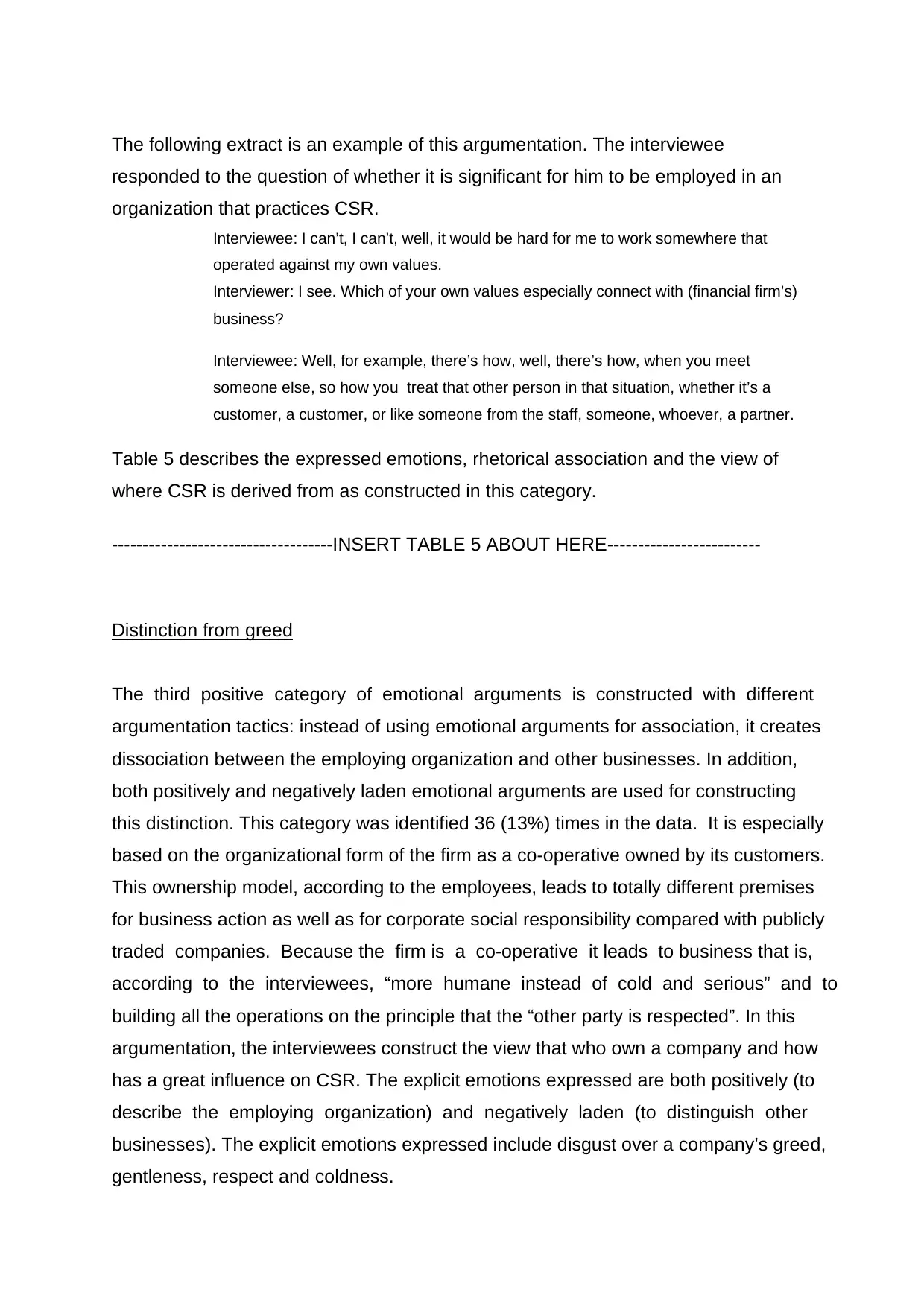
The following extract is an example of this argumentation. The interviewee
responded to the question of whether it is significant for him to be employed in an
organization that practices CSR.
Interviewee: I can’t, I can’t, well, it would be hard for me to work somewhere that
operated against my own values.
Interviewer: I see. Which of your own values especially connect with (financial firm’s)
business?
Interviewee: Well, for example, there’s how, well, there’s how, when you meet
someone else, so how you treat that other person in that situation, whether it’s a
customer, a customer, or like someone from the staff, someone, whoever, a partner.
Table 5 describes the expressed emotions, rhetorical association and the view of
where CSR is derived from as constructed in this category.
------------------------------------INSERT TABLE 5 ABOUT HERE-------------------------
Distinction from greed
The third positive category of emotional arguments is constructed with different
argumentation tactics: instead of using emotional arguments for association, it creates
dissociation between the employing organization and other businesses. In addition,
both positively and negatively laden emotional arguments are used for constructing
this distinction. This category was identified 36 (13%) times in the data. It is especially
based on the organizational form of the firm as a co-operative owned by its customers.
This ownership model, according to the employees, leads to totally different premises
for business action as well as for corporate social responsibility compared with publicly
traded companies. Because the firm is a co-operative it leads to business that is,
according to the interviewees, “more humane instead of cold and serious” and to
building all the operations on the principle that the “other party is respected”. In this
argumentation, the interviewees construct the view that who own a company and how
has a great influence on CSR. The explicit emotions expressed are both positively (to
describe the employing organization) and negatively laden (to distinguish other
businesses). The explicit emotions expressed include disgust over a company’s greed,
gentleness, respect and coldness.
responded to the question of whether it is significant for him to be employed in an
organization that practices CSR.
Interviewee: I can’t, I can’t, well, it would be hard for me to work somewhere that
operated against my own values.
Interviewer: I see. Which of your own values especially connect with (financial firm’s)
business?
Interviewee: Well, for example, there’s how, well, there’s how, when you meet
someone else, so how you treat that other person in that situation, whether it’s a
customer, a customer, or like someone from the staff, someone, whoever, a partner.
Table 5 describes the expressed emotions, rhetorical association and the view of
where CSR is derived from as constructed in this category.
------------------------------------INSERT TABLE 5 ABOUT HERE-------------------------
Distinction from greed
The third positive category of emotional arguments is constructed with different
argumentation tactics: instead of using emotional arguments for association, it creates
dissociation between the employing organization and other businesses. In addition,
both positively and negatively laden emotional arguments are used for constructing
this distinction. This category was identified 36 (13%) times in the data. It is especially
based on the organizational form of the firm as a co-operative owned by its customers.
This ownership model, according to the employees, leads to totally different premises
for business action as well as for corporate social responsibility compared with publicly
traded companies. Because the firm is a co-operative it leads to business that is,
according to the interviewees, “more humane instead of cold and serious” and to
building all the operations on the principle that the “other party is respected”. In this
argumentation, the interviewees construct the view that who own a company and how
has a great influence on CSR. The explicit emotions expressed are both positively (to
describe the employing organization) and negatively laden (to distinguish other
businesses). The explicit emotions expressed include disgust over a company’s greed,
gentleness, respect and coldness.
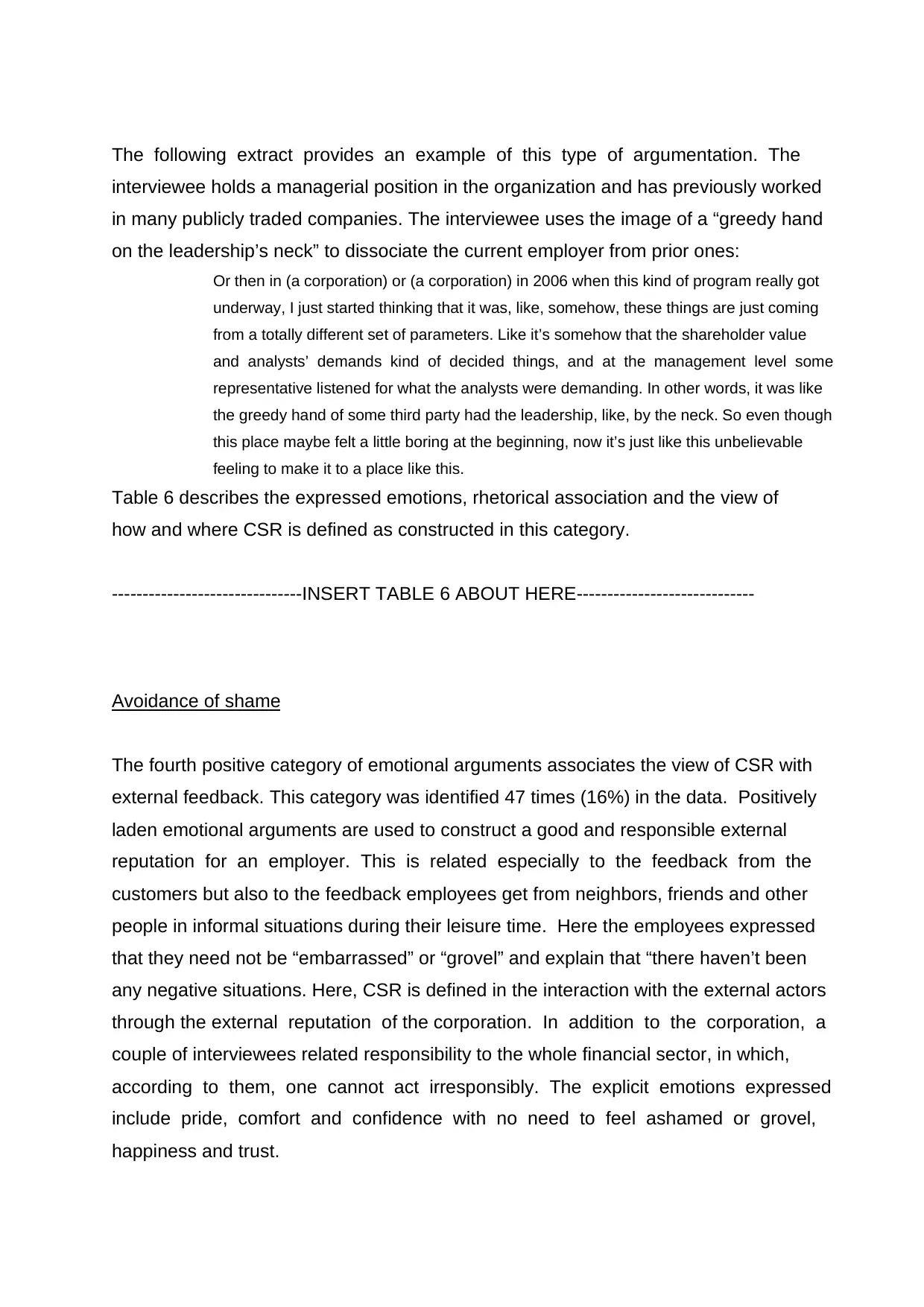
The following extract provides an example of this type of argumentation. The
interviewee holds a managerial position in the organization and has previously worked
in many publicly traded companies. The interviewee uses the image of a “greedy hand
on the leadership’s neck” to dissociate the current employer from prior ones:
Or then in (a corporation) or (a corporation) in 2006 when this kind of program really got
underway, I just started thinking that it was, like, somehow, these things are just coming
from a totally different set of parameters. Like it’s somehow that the shareholder value
and analysts’ demands kind of decided things, and at the management level some
representative listened for what the analysts were demanding. In other words, it was like
the greedy hand of some third party had the leadership, like, by the neck. So even though
this place maybe felt a little boring at the beginning, now it’s just like this unbelievable
feeling to make it to a place like this.
Table 6 describes the expressed emotions, rhetorical association and the view of
how and where CSR is defined as constructed in this category.
-------------------------------INSERT TABLE 6 ABOUT HERE-----------------------------
Avoidance of shame
The fourth positive category of emotional arguments associates the view of CSR with
external feedback. This category was identified 47 times (16%) in the data. Positively
laden emotional arguments are used to construct a good and responsible external
reputation for an employer. This is related especially to the feedback from the
customers but also to the feedback employees get from neighbors, friends and other
people in informal situations during their leisure time. Here the employees expressed
that they need not be “embarrassed” or “grovel” and explain that “there haven’t been
any negative situations. Here, CSR is defined in the interaction with the external actors
through the external reputation of the corporation. In addition to the corporation, a
couple of interviewees related responsibility to the whole financial sector, in which,
according to them, one cannot act irresponsibly. The explicit emotions expressed
include pride, comfort and confidence with no need to feel ashamed or grovel,
happiness and trust.
interviewee holds a managerial position in the organization and has previously worked
in many publicly traded companies. The interviewee uses the image of a “greedy hand
on the leadership’s neck” to dissociate the current employer from prior ones:
Or then in (a corporation) or (a corporation) in 2006 when this kind of program really got
underway, I just started thinking that it was, like, somehow, these things are just coming
from a totally different set of parameters. Like it’s somehow that the shareholder value
and analysts’ demands kind of decided things, and at the management level some
representative listened for what the analysts were demanding. In other words, it was like
the greedy hand of some third party had the leadership, like, by the neck. So even though
this place maybe felt a little boring at the beginning, now it’s just like this unbelievable
feeling to make it to a place like this.
Table 6 describes the expressed emotions, rhetorical association and the view of
how and where CSR is defined as constructed in this category.
-------------------------------INSERT TABLE 6 ABOUT HERE-----------------------------
Avoidance of shame
The fourth positive category of emotional arguments associates the view of CSR with
external feedback. This category was identified 47 times (16%) in the data. Positively
laden emotional arguments are used to construct a good and responsible external
reputation for an employer. This is related especially to the feedback from the
customers but also to the feedback employees get from neighbors, friends and other
people in informal situations during their leisure time. Here the employees expressed
that they need not be “embarrassed” or “grovel” and explain that “there haven’t been
any negative situations. Here, CSR is defined in the interaction with the external actors
through the external reputation of the corporation. In addition to the corporation, a
couple of interviewees related responsibility to the whole financial sector, in which,
according to them, one cannot act irresponsibly. The explicit emotions expressed
include pride, comfort and confidence with no need to feel ashamed or grovel,
happiness and trust.
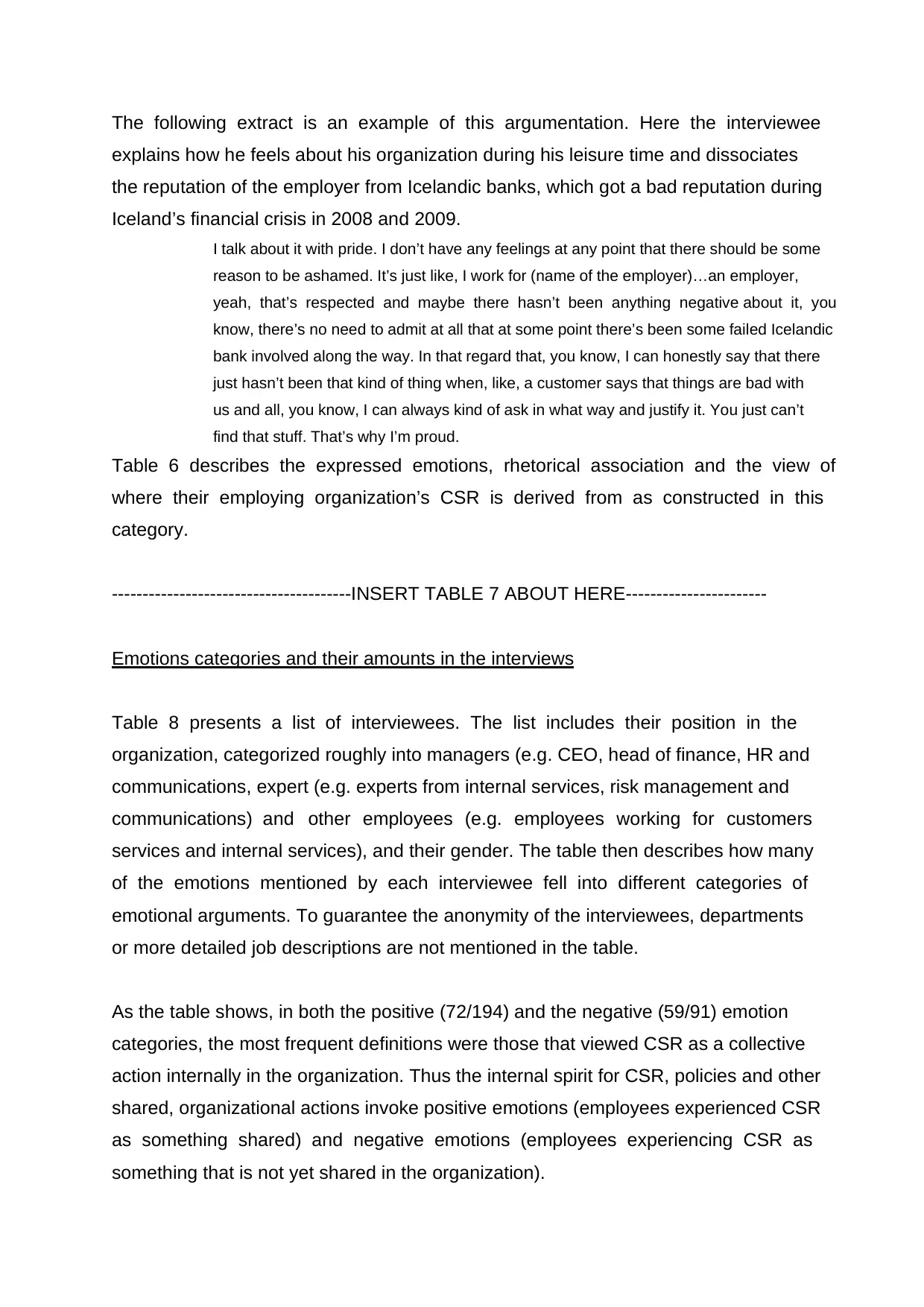
The following extract is an example of this argumentation. Here the interviewee
explains how he feels about his organization during his leisure time and dissociates
the reputation of the employer from Icelandic banks, which got a bad reputation during
Iceland’s financial crisis in 2008 and 2009.
I talk about it with pride. I don’t have any feelings at any point that there should be some
reason to be ashamed. It’s just like, I work for (name of the employer)…an employer,
yeah, that’s respected and maybe there hasn’t been anything negative about it, you
know, there’s no need to admit at all that at some point there’s been some failed Icelandic
bank involved along the way. In that regard that, you know, I can honestly say that there
just hasn’t been that kind of thing when, like, a customer says that things are bad with
us and all, you know, I can always kind of ask in what way and justify it. You just can’t
find that stuff. That’s why I’m proud.
Table 6 describes the expressed emotions, rhetorical association and the view of
where their employing organization’s CSR is derived from as constructed in this
category.
---------------------------------------INSERT TABLE 7 ABOUT HERE-----------------------
Emotions categories and their amounts in the interviews
Table 8 presents a list of interviewees. The list includes their position in the
organization, categorized roughly into managers (e.g. CEO, head of finance, HR and
communications, expert (e.g. experts from internal services, risk management and
communications) and other employees (e.g. employees working for customers
services and internal services), and their gender. The table then describes how many
of the emotions mentioned by each interviewee fell into different categories of
emotional arguments. To guarantee the anonymity of the interviewees, departments
or more detailed job descriptions are not mentioned in the table.
As the table shows, in both the positive (72/194) and the negative (59/91) emotion
categories, the most frequent definitions were those that viewed CSR as a collective
action internally in the organization. Thus the internal spirit for CSR, policies and other
shared, organizational actions invoke positive emotions (employees experienced CSR
as something shared) and negative emotions (employees experiencing CSR as
something that is not yet shared in the organization).
explains how he feels about his organization during his leisure time and dissociates
the reputation of the employer from Icelandic banks, which got a bad reputation during
Iceland’s financial crisis in 2008 and 2009.
I talk about it with pride. I don’t have any feelings at any point that there should be some
reason to be ashamed. It’s just like, I work for (name of the employer)…an employer,
yeah, that’s respected and maybe there hasn’t been anything negative about it, you
know, there’s no need to admit at all that at some point there’s been some failed Icelandic
bank involved along the way. In that regard that, you know, I can honestly say that there
just hasn’t been that kind of thing when, like, a customer says that things are bad with
us and all, you know, I can always kind of ask in what way and justify it. You just can’t
find that stuff. That’s why I’m proud.
Table 6 describes the expressed emotions, rhetorical association and the view of
where their employing organization’s CSR is derived from as constructed in this
category.
---------------------------------------INSERT TABLE 7 ABOUT HERE-----------------------
Emotions categories and their amounts in the interviews
Table 8 presents a list of interviewees. The list includes their position in the
organization, categorized roughly into managers (e.g. CEO, head of finance, HR and
communications, expert (e.g. experts from internal services, risk management and
communications) and other employees (e.g. employees working for customers
services and internal services), and their gender. The table then describes how many
of the emotions mentioned by each interviewee fell into different categories of
emotional arguments. To guarantee the anonymity of the interviewees, departments
or more detailed job descriptions are not mentioned in the table.
As the table shows, in both the positive (72/194) and the negative (59/91) emotion
categories, the most frequent definitions were those that viewed CSR as a collective
action internally in the organization. Thus the internal spirit for CSR, policies and other
shared, organizational actions invoke positive emotions (employees experienced CSR
as something shared) and negative emotions (employees experiencing CSR as
something that is not yet shared in the organization).
Paraphrase This Document
Need a fresh take? Get an instant paraphrase of this document with our AI Paraphraser
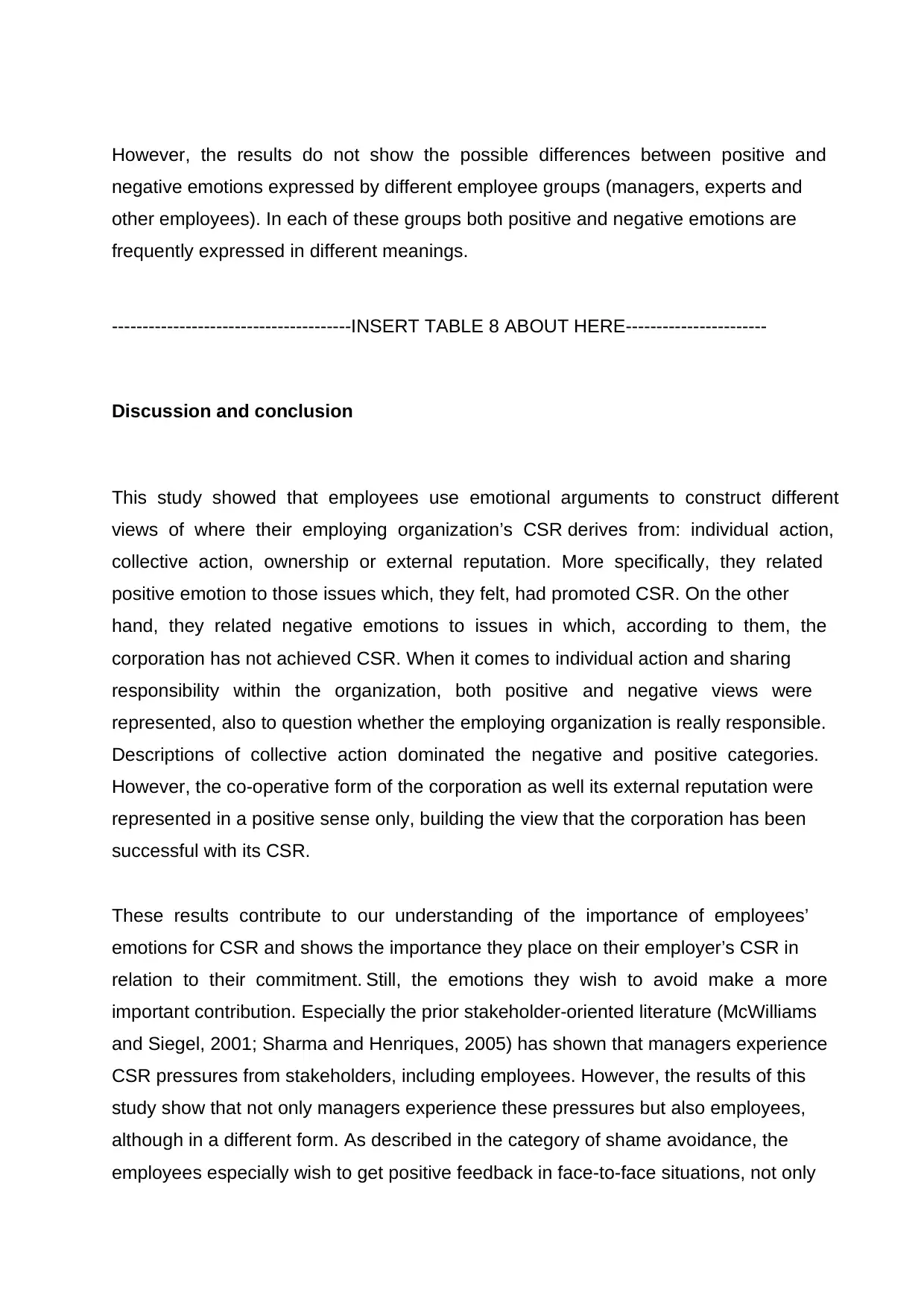
However, the results do not show the possible differences between positive and
negative emotions expressed by different employee groups (managers, experts and
other employees). In each of these groups both positive and negative emotions are
frequently expressed in different meanings.
---------------------------------------INSERT TABLE 8 ABOUT HERE-----------------------
Discussion and conclusion
This study showed that employees use emotional arguments to construct different
views of where their employing organization’s CSR derives from: individual action,
collective action, ownership or external reputation. More specifically, they related
positive emotion to those issues which, they felt, had promoted CSR. On the other
hand, they related negative emotions to issues in which, according to them, the
corporation has not achieved CSR. When it comes to individual action and sharing
responsibility within the organization, both positive and negative views were
represented, also to question whether the employing organization is really responsible.
Descriptions of collective action dominated the negative and positive categories.
However, the co-operative form of the corporation as well its external reputation were
represented in a positive sense only, building the view that the corporation has been
successful with its CSR.
These results contribute to our understanding of the importance of employees’
emotions for CSR and shows the importance they place on their employer’s CSR in
relation to their commitment. Still, the emotions they wish to avoid make a more
important contribution. Especially the prior stakeholder-oriented literature (McWilliams
and Siegel, 2001; Sharma and Henriques, 2005) has shown that managers experience
CSR pressures from stakeholders, including employees. However, the results of this
study show that not only managers experience these pressures but also employees,
although in a different form. As described in the category of shame avoidance, the
employees especially wish to get positive feedback in face-to-face situations, not only
negative emotions expressed by different employee groups (managers, experts and
other employees). In each of these groups both positive and negative emotions are
frequently expressed in different meanings.
---------------------------------------INSERT TABLE 8 ABOUT HERE-----------------------
Discussion and conclusion
This study showed that employees use emotional arguments to construct different
views of where their employing organization’s CSR derives from: individual action,
collective action, ownership or external reputation. More specifically, they related
positive emotion to those issues which, they felt, had promoted CSR. On the other
hand, they related negative emotions to issues in which, according to them, the
corporation has not achieved CSR. When it comes to individual action and sharing
responsibility within the organization, both positive and negative views were
represented, also to question whether the employing organization is really responsible.
Descriptions of collective action dominated the negative and positive categories.
However, the co-operative form of the corporation as well its external reputation were
represented in a positive sense only, building the view that the corporation has been
successful with its CSR.
These results contribute to our understanding of the importance of employees’
emotions for CSR and shows the importance they place on their employer’s CSR in
relation to their commitment. Still, the emotions they wish to avoid make a more
important contribution. Especially the prior stakeholder-oriented literature (McWilliams
and Siegel, 2001; Sharma and Henriques, 2005) has shown that managers experience
CSR pressures from stakeholders, including employees. However, the results of this
study show that not only managers experience these pressures but also employees,
although in a different form. As described in the category of shame avoidance, the
employees especially wish to get positive feedback in face-to-face situations, not only
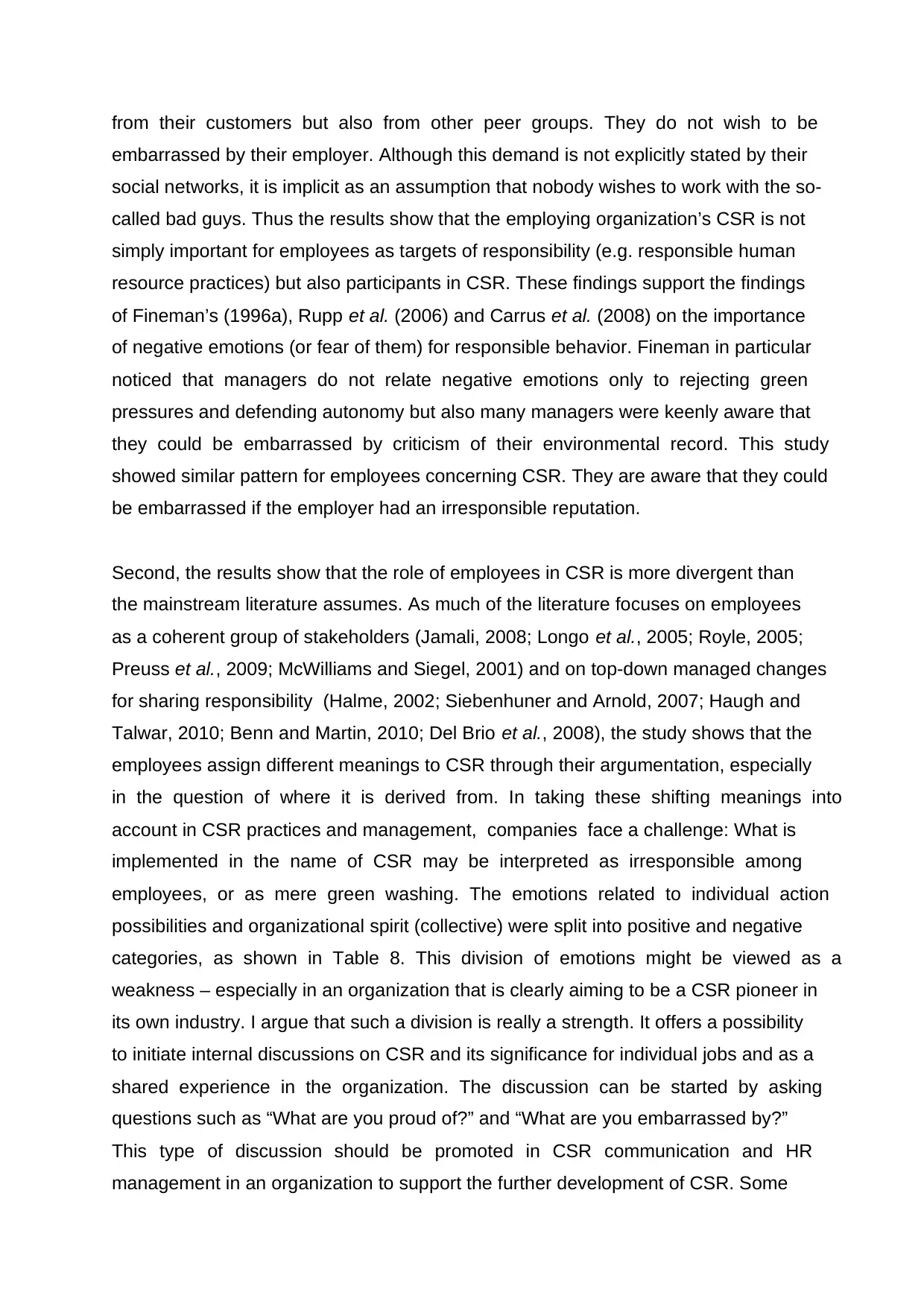
from their customers but also from other peer groups. They do not wish to be
embarrassed by their employer. Although this demand is not explicitly stated by their
social networks, it is implicit as an assumption that nobody wishes to work with the so-
called bad guys. Thus the results show that the employing organization’s CSR is not
simply important for employees as targets of responsibility (e.g. responsible human
resource practices) but also participants in CSR. These findings support the findings
of Fineman’s (1996a), Rupp et al. (2006) and Carrus et al. (2008) on the importance
of negative emotions (or fear of them) for responsible behavior. Fineman in particular
noticed that managers do not relate negative emotions only to rejecting green
pressures and defending autonomy but also many managers were keenly aware that
they could be embarrassed by criticism of their environmental record. This study
showed similar pattern for employees concerning CSR. They are aware that they could
be embarrassed if the employer had an irresponsible reputation.
Second, the results show that the role of employees in CSR is more divergent than
the mainstream literature assumes. As much of the literature focuses on employees
as a coherent group of stakeholders (Jamali, 2008; Longo et al., 2005; Royle, 2005;
Preuss et al., 2009; McWilliams and Siegel, 2001) and on top-down managed changes
for sharing responsibility (Halme, 2002; Siebenhuner and Arnold, 2007; Haugh and
Talwar, 2010; Benn and Martin, 2010; Del Brio et al., 2008), the study shows that the
employees assign different meanings to CSR through their argumentation, especially
in the question of where it is derived from. In taking these shifting meanings into
account in CSR practices and management, companies face a challenge: What is
implemented in the name of CSR may be interpreted as irresponsible among
employees, or as mere green washing. The emotions related to individual action
possibilities and organizational spirit (collective) were split into positive and negative
categories, as shown in Table 8. This division of emotions might be viewed as a
weakness – especially in an organization that is clearly aiming to be a CSR pioneer in
its own industry. I argue that such a division is really a strength. It offers a possibility
to initiate internal discussions on CSR and its significance for individual jobs and as a
shared experience in the organization. The discussion can be started by asking
questions such as “What are you proud of?” and “What are you embarrassed by?”
This type of discussion should be promoted in CSR communication and HR
management in an organization to support the further development of CSR. Some
embarrassed by their employer. Although this demand is not explicitly stated by their
social networks, it is implicit as an assumption that nobody wishes to work with the so-
called bad guys. Thus the results show that the employing organization’s CSR is not
simply important for employees as targets of responsibility (e.g. responsible human
resource practices) but also participants in CSR. These findings support the findings
of Fineman’s (1996a), Rupp et al. (2006) and Carrus et al. (2008) on the importance
of negative emotions (or fear of them) for responsible behavior. Fineman in particular
noticed that managers do not relate negative emotions only to rejecting green
pressures and defending autonomy but also many managers were keenly aware that
they could be embarrassed by criticism of their environmental record. This study
showed similar pattern for employees concerning CSR. They are aware that they could
be embarrassed if the employer had an irresponsible reputation.
Second, the results show that the role of employees in CSR is more divergent than
the mainstream literature assumes. As much of the literature focuses on employees
as a coherent group of stakeholders (Jamali, 2008; Longo et al., 2005; Royle, 2005;
Preuss et al., 2009; McWilliams and Siegel, 2001) and on top-down managed changes
for sharing responsibility (Halme, 2002; Siebenhuner and Arnold, 2007; Haugh and
Talwar, 2010; Benn and Martin, 2010; Del Brio et al., 2008), the study shows that the
employees assign different meanings to CSR through their argumentation, especially
in the question of where it is derived from. In taking these shifting meanings into
account in CSR practices and management, companies face a challenge: What is
implemented in the name of CSR may be interpreted as irresponsible among
employees, or as mere green washing. The emotions related to individual action
possibilities and organizational spirit (collective) were split into positive and negative
categories, as shown in Table 8. This division of emotions might be viewed as a
weakness – especially in an organization that is clearly aiming to be a CSR pioneer in
its own industry. I argue that such a division is really a strength. It offers a possibility
to initiate internal discussions on CSR and its significance for individual jobs and as a
shared experience in the organization. The discussion can be started by asking
questions such as “What are you proud of?” and “What are you embarrassed by?”
This type of discussion should be promoted in CSR communication and HR
management in an organization to support the further development of CSR. Some
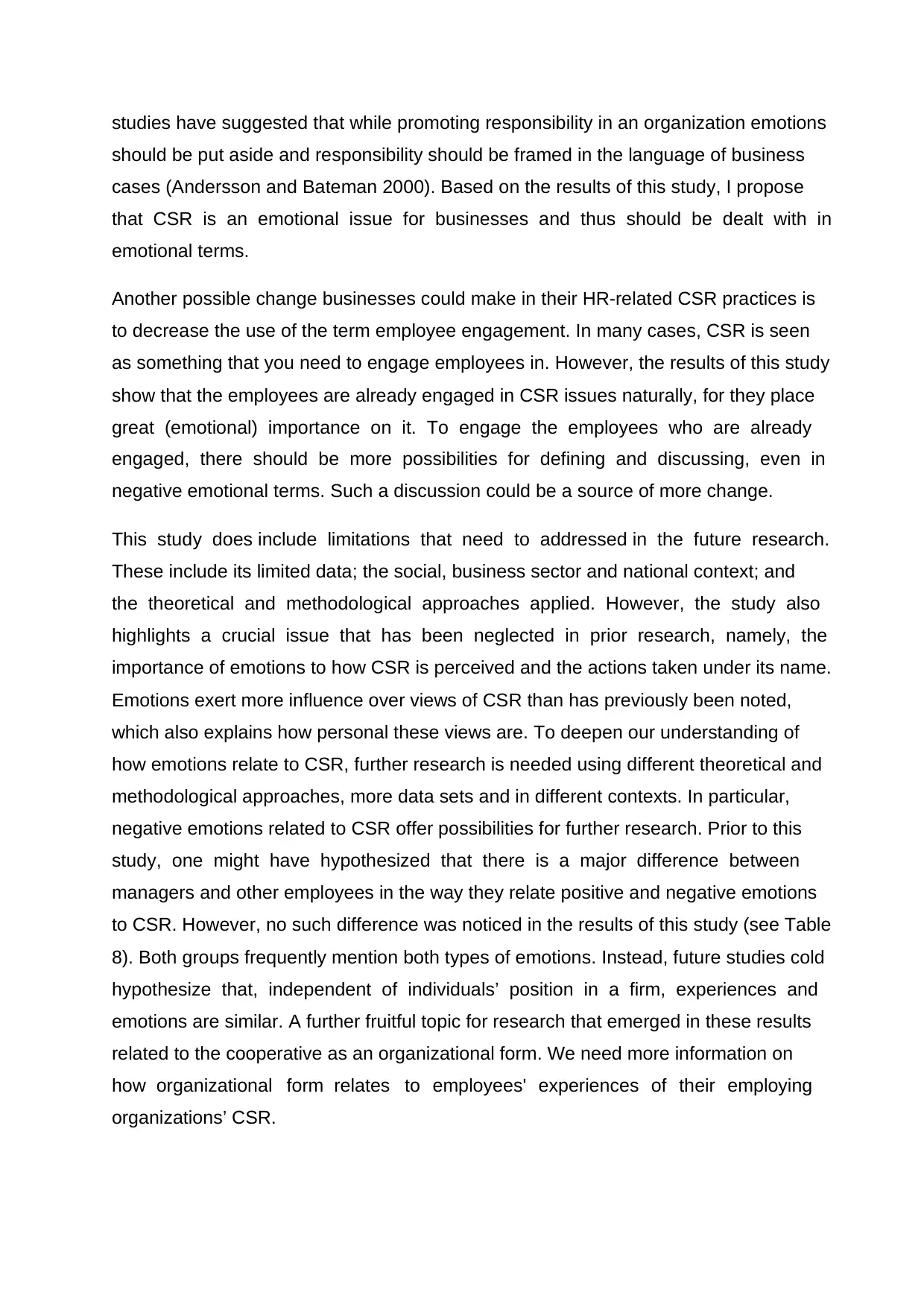
studies have suggested that while promoting responsibility in an organization emotions
should be put aside and responsibility should be framed in the language of business
cases (Andersson and Bateman 2000). Based on the results of this study, I propose
that CSR is an emotional issue for businesses and thus should be dealt with in
emotional terms.
Another possible change businesses could make in their HR-related CSR practices is
to decrease the use of the term employee engagement. In many cases, CSR is seen
as something that you need to engage employees in. However, the results of this study
show that the employees are already engaged in CSR issues naturally, for they place
great (emotional) importance on it. To engage the employees who are already
engaged, there should be more possibilities for defining and discussing, even in
negative emotional terms. Such a discussion could be a source of more change.
This study does include limitations that need to addressed in the future research.
These include its limited data; the social, business sector and national context; and
the theoretical and methodological approaches applied. However, the study also
highlights a crucial issue that has been neglected in prior research, namely, the
importance of emotions to how CSR is perceived and the actions taken under its name.
Emotions exert more influence over views of CSR than has previously been noted,
which also explains how personal these views are. To deepen our understanding of
how emotions relate to CSR, further research is needed using different theoretical and
methodological approaches, more data sets and in different contexts. In particular,
negative emotions related to CSR offer possibilities for further research. Prior to this
study, one might have hypothesized that there is a major difference between
managers and other employees in the way they relate positive and negative emotions
to CSR. However, no such difference was noticed in the results of this study (see Table
8). Both groups frequently mention both types of emotions. Instead, future studies cold
hypothesize that, independent of individuals’ position in a firm, experiences and
emotions are similar. A further fruitful topic for research that emerged in these results
related to the cooperative as an organizational form. We need more information on
how organizational form relates to employees' experiences of their employing
organizations’ CSR.
should be put aside and responsibility should be framed in the language of business
cases (Andersson and Bateman 2000). Based on the results of this study, I propose
that CSR is an emotional issue for businesses and thus should be dealt with in
emotional terms.
Another possible change businesses could make in their HR-related CSR practices is
to decrease the use of the term employee engagement. In many cases, CSR is seen
as something that you need to engage employees in. However, the results of this study
show that the employees are already engaged in CSR issues naturally, for they place
great (emotional) importance on it. To engage the employees who are already
engaged, there should be more possibilities for defining and discussing, even in
negative emotional terms. Such a discussion could be a source of more change.
This study does include limitations that need to addressed in the future research.
These include its limited data; the social, business sector and national context; and
the theoretical and methodological approaches applied. However, the study also
highlights a crucial issue that has been neglected in prior research, namely, the
importance of emotions to how CSR is perceived and the actions taken under its name.
Emotions exert more influence over views of CSR than has previously been noted,
which also explains how personal these views are. To deepen our understanding of
how emotions relate to CSR, further research is needed using different theoretical and
methodological approaches, more data sets and in different contexts. In particular,
negative emotions related to CSR offer possibilities for further research. Prior to this
study, one might have hypothesized that there is a major difference between
managers and other employees in the way they relate positive and negative emotions
to CSR. However, no such difference was noticed in the results of this study (see Table
8). Both groups frequently mention both types of emotions. Instead, future studies cold
hypothesize that, independent of individuals’ position in a firm, experiences and
emotions are similar. A further fruitful topic for research that emerged in these results
related to the cooperative as an organizational form. We need more information on
how organizational form relates to employees' experiences of their employing
organizations’ CSR.
Secure Best Marks with AI Grader
Need help grading? Try our AI Grader for instant feedback on your assignments.
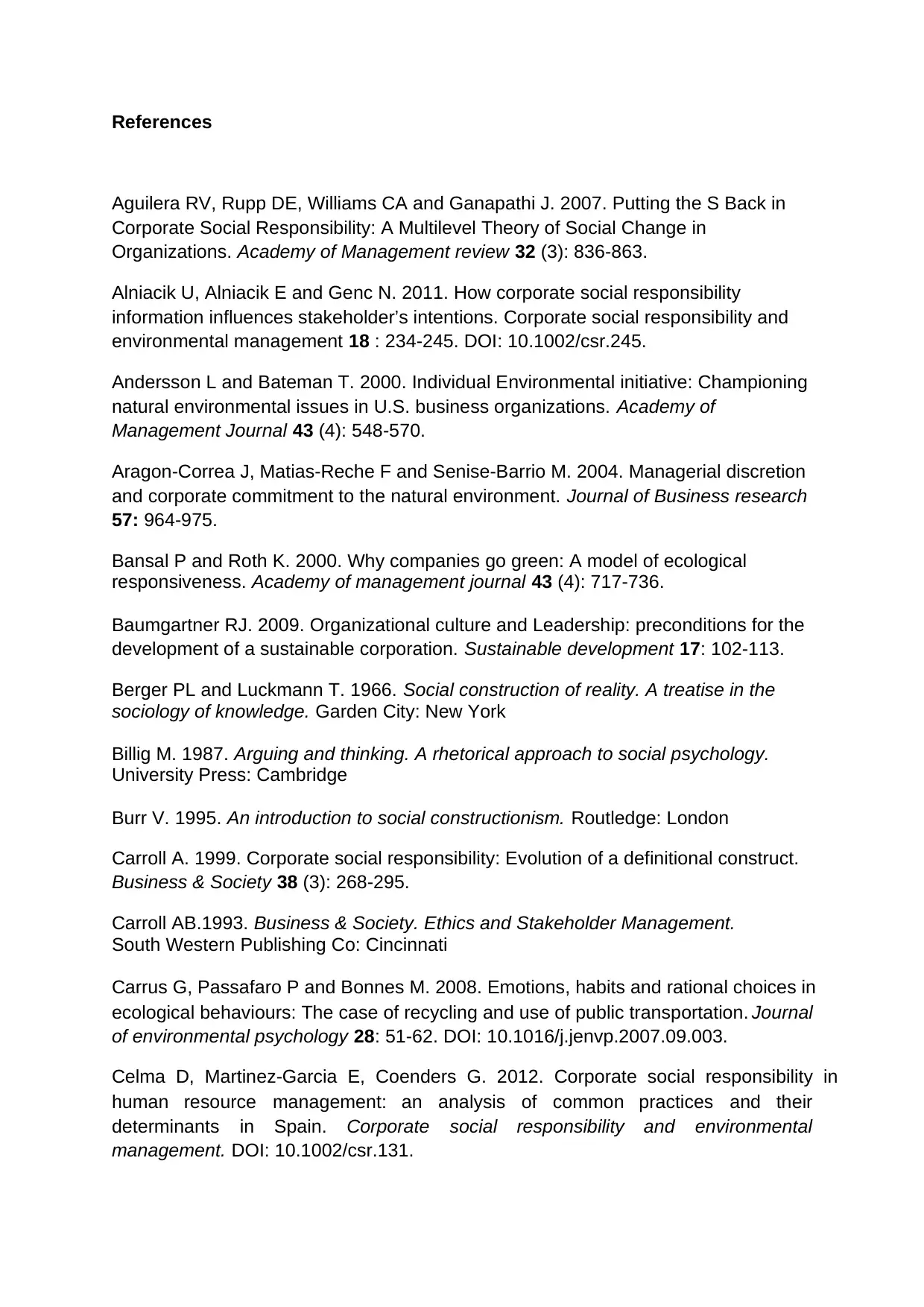
References
Aguilera RV, Rupp DE, Williams CA and Ganapathi J. 2007. Putting the S Back in
Corporate Social Responsibility: A Multilevel Theory of Social Change in
Organizations. Academy of Management review 32 (3): 836-863.
Alniacik U, Alniacik E and Genc N. 2011. How corporate social responsibility
information influences stakeholder’s intentions. Corporate social responsibility and
environmental management 18 : 234-245. DOI: 10.1002/csr.245.
Andersson L and Bateman T. 2000. Individual Environmental initiative: Championing
natural environmental issues in U.S. business organizations. Academy of
Management Journal 43 (4): 548-570.
Aragon-Correa J, Matias-Reche F and Senise-Barrio M. 2004. Managerial discretion
and corporate commitment to the natural environment. Journal of Business research
57: 964-975.
Bansal P and Roth K. 2000. Why companies go green: A model of ecological
responsiveness. Academy of management journal 43 (4): 717-736.
Baumgartner RJ. 2009. Organizational culture and Leadership: preconditions for the
development of a sustainable corporation. Sustainable development 17: 102-113.
Berger PL and Luckmann T. 1966. Social construction of reality. A treatise in the
sociology of knowledge. Garden City: New York
Billig M. 1987. Arguing and thinking. A rhetorical approach to social psychology.
University Press: Cambridge
Burr V. 1995. An introduction to social constructionism. Routledge: London
Carroll A. 1999. Corporate social responsibility: Evolution of a definitional construct.
Business & Society 38 (3): 268-295.
Carroll AB.1993. Business & Society. Ethics and Stakeholder Management.
South Western Publishing Co: Cincinnati
Carrus G, Passafaro P and Bonnes M. 2008. Emotions, habits and rational choices in
ecological behaviours: The case of recycling and use of public transportation. Journal
of environmental psychology 28: 51-62. DOI: 10.1016/j.jenvp.2007.09.003.
Celma D, Martinez-Garcia E, Coenders G. 2012. Corporate social responsibility in
human resource management: an analysis of common practices and their
determinants in Spain. Corporate social responsibility and environmental
management. DOI: 10.1002/csr.131.
Aguilera RV, Rupp DE, Williams CA and Ganapathi J. 2007. Putting the S Back in
Corporate Social Responsibility: A Multilevel Theory of Social Change in
Organizations. Academy of Management review 32 (3): 836-863.
Alniacik U, Alniacik E and Genc N. 2011. How corporate social responsibility
information influences stakeholder’s intentions. Corporate social responsibility and
environmental management 18 : 234-245. DOI: 10.1002/csr.245.
Andersson L and Bateman T. 2000. Individual Environmental initiative: Championing
natural environmental issues in U.S. business organizations. Academy of
Management Journal 43 (4): 548-570.
Aragon-Correa J, Matias-Reche F and Senise-Barrio M. 2004. Managerial discretion
and corporate commitment to the natural environment. Journal of Business research
57: 964-975.
Bansal P and Roth K. 2000. Why companies go green: A model of ecological
responsiveness. Academy of management journal 43 (4): 717-736.
Baumgartner RJ. 2009. Organizational culture and Leadership: preconditions for the
development of a sustainable corporation. Sustainable development 17: 102-113.
Berger PL and Luckmann T. 1966. Social construction of reality. A treatise in the
sociology of knowledge. Garden City: New York
Billig M. 1987. Arguing and thinking. A rhetorical approach to social psychology.
University Press: Cambridge
Burr V. 1995. An introduction to social constructionism. Routledge: London
Carroll A. 1999. Corporate social responsibility: Evolution of a definitional construct.
Business & Society 38 (3): 268-295.
Carroll AB.1993. Business & Society. Ethics and Stakeholder Management.
South Western Publishing Co: Cincinnati
Carrus G, Passafaro P and Bonnes M. 2008. Emotions, habits and rational choices in
ecological behaviours: The case of recycling and use of public transportation. Journal
of environmental psychology 28: 51-62. DOI: 10.1016/j.jenvp.2007.09.003.
Celma D, Martinez-Garcia E, Coenders G. 2012. Corporate social responsibility in
human resource management: an analysis of common practices and their
determinants in Spain. Corporate social responsibility and environmental
management. DOI: 10.1002/csr.131.
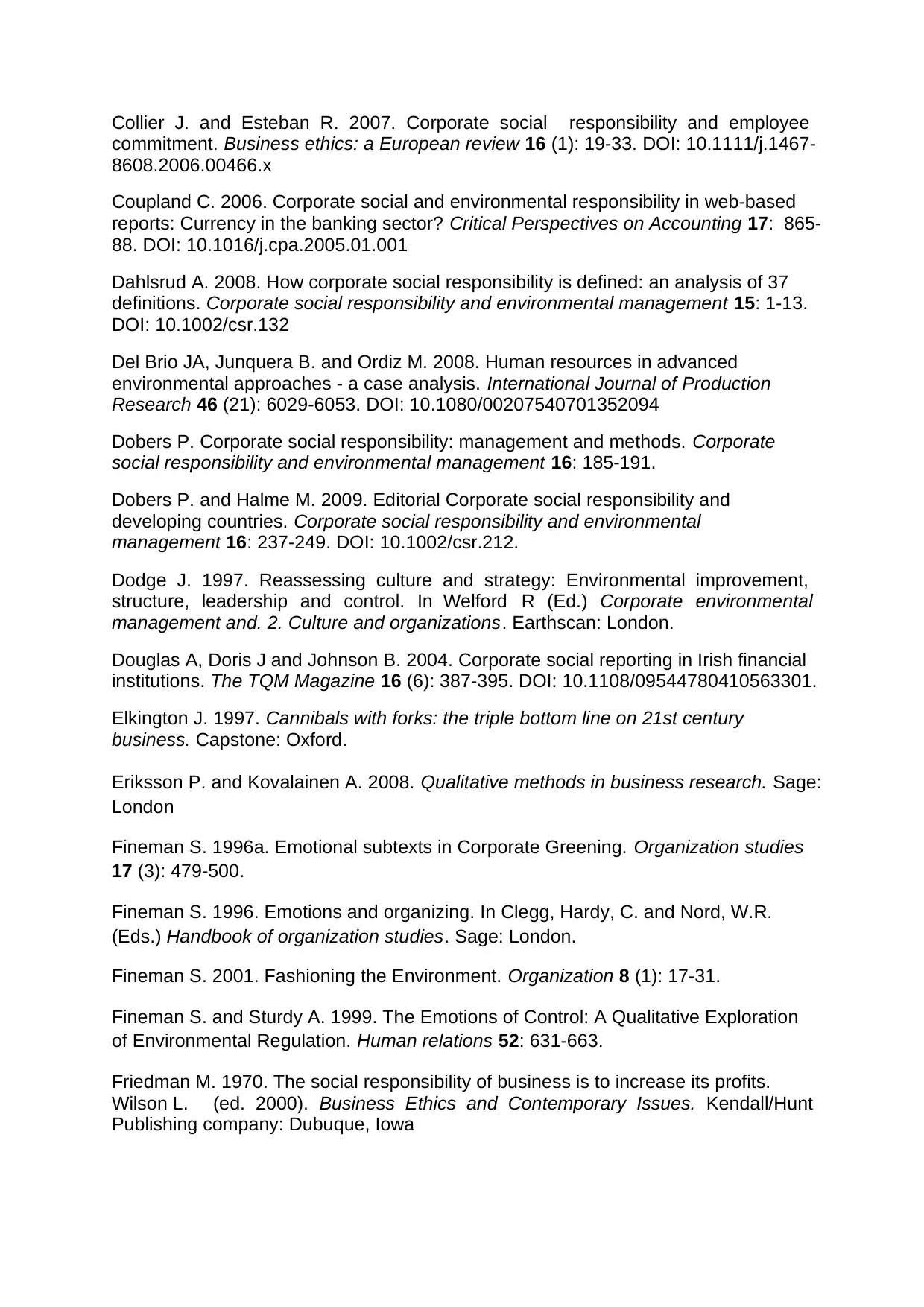
Collier J. and Esteban R. 2007. Corporate social responsibility and employee
commitment. Business ethics: a European review 16 (1): 19-33. DOI: 10.1111/j.1467-
8608.2006.00466.x
Coupland C. 2006. Corporate social and environmental responsibility in web-based
reports: Currency in the banking sector? Critical Perspectives on Accounting 17: 865-
88. DOI: 10.1016/j.cpa.2005.01.001
Dahlsrud A. 2008. How corporate social responsibility is defined: an analysis of 37
definitions. Corporate social responsibility and environmental management 15: 1-13.
DOI: 10.1002/csr.132
Del Brio JA, Junquera B. and Ordiz M. 2008. Human resources in advanced
environmental approaches - a case analysis. International Journal of Production
Research 46 (21): 6029-6053. DOI: 10.1080/00207540701352094
Dobers P. Corporate social responsibility: management and methods. Corporate
social responsibility and environmental management 16: 185-191.
Dobers P. and Halme M. 2009. Editorial Corporate social responsibility and
developing countries. Corporate social responsibility and environmental
management 16: 237-249. DOI: 10.1002/csr.212.
Dodge J. 1997. Reassessing culture and strategy: Environmental improvement,
structure, leadership and control. In Welford R (Ed.) Corporate environmental
management and. 2. Culture and organizations. Earthscan: London.
Douglas A, Doris J and Johnson B. 2004. Corporate social reporting in Irish financial
institutions. The TQM Magazine 16 (6): 387-395. DOI: 10.1108/09544780410563301.
Elkington J. 1997. Cannibals with forks: the triple bottom line on 21st century
business. Capstone: Oxford.
Eriksson P. and Kovalainen A. 2008. Qualitative methods in business research. Sage:
London
Fineman S. 1996a. Emotional subtexts in Corporate Greening. Organization studies
17 (3): 479-500.
Fineman S. 1996. Emotions and organizing. In Clegg, Hardy, C. and Nord, W.R.
(Eds.) Handbook of organization studies. Sage: London.
Fineman S. 2001. Fashioning the Environment. Organization 8 (1): 17-31.
Fineman S. and Sturdy A. 1999. The Emotions of Control: A Qualitative Exploration
of Environmental Regulation. Human relations 52: 631-663.
Friedman M. 1970. The social responsibility of business is to increase its profits.
Wilson L. (ed. 2000). Business Ethics and Contemporary Issues. Kendall/Hunt
Publishing company: Dubuque, Iowa
commitment. Business ethics: a European review 16 (1): 19-33. DOI: 10.1111/j.1467-
8608.2006.00466.x
Coupland C. 2006. Corporate social and environmental responsibility in web-based
reports: Currency in the banking sector? Critical Perspectives on Accounting 17: 865-
88. DOI: 10.1016/j.cpa.2005.01.001
Dahlsrud A. 2008. How corporate social responsibility is defined: an analysis of 37
definitions. Corporate social responsibility and environmental management 15: 1-13.
DOI: 10.1002/csr.132
Del Brio JA, Junquera B. and Ordiz M. 2008. Human resources in advanced
environmental approaches - a case analysis. International Journal of Production
Research 46 (21): 6029-6053. DOI: 10.1080/00207540701352094
Dobers P. Corporate social responsibility: management and methods. Corporate
social responsibility and environmental management 16: 185-191.
Dobers P. and Halme M. 2009. Editorial Corporate social responsibility and
developing countries. Corporate social responsibility and environmental
management 16: 237-249. DOI: 10.1002/csr.212.
Dodge J. 1997. Reassessing culture and strategy: Environmental improvement,
structure, leadership and control. In Welford R (Ed.) Corporate environmental
management and. 2. Culture and organizations. Earthscan: London.
Douglas A, Doris J and Johnson B. 2004. Corporate social reporting in Irish financial
institutions. The TQM Magazine 16 (6): 387-395. DOI: 10.1108/09544780410563301.
Elkington J. 1997. Cannibals with forks: the triple bottom line on 21st century
business. Capstone: Oxford.
Eriksson P. and Kovalainen A. 2008. Qualitative methods in business research. Sage:
London
Fineman S. 1996a. Emotional subtexts in Corporate Greening. Organization studies
17 (3): 479-500.
Fineman S. 1996. Emotions and organizing. In Clegg, Hardy, C. and Nord, W.R.
(Eds.) Handbook of organization studies. Sage: London.
Fineman S. 2001. Fashioning the Environment. Organization 8 (1): 17-31.
Fineman S. and Sturdy A. 1999. The Emotions of Control: A Qualitative Exploration
of Environmental Regulation. Human relations 52: 631-663.
Friedman M. 1970. The social responsibility of business is to increase its profits.
Wilson L. (ed. 2000). Business Ethics and Contemporary Issues. Kendall/Hunt
Publishing company: Dubuque, Iowa
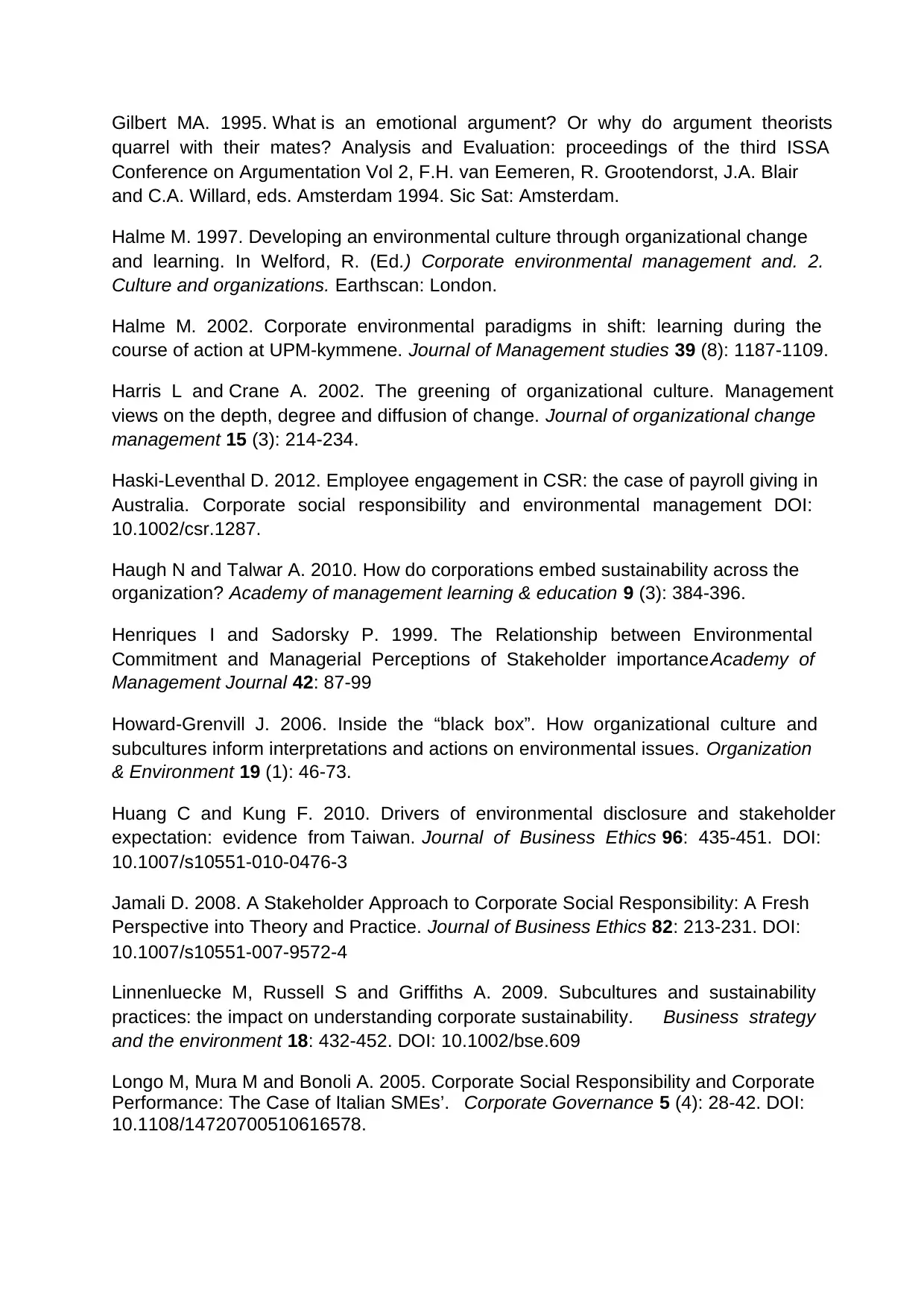
Gilbert MA. 1995. What is an emotional argument? Or why do argument theorists
quarrel with their mates? Analysis and Evaluation: proceedings of the third ISSA
Conference on Argumentation Vol 2, F.H. van Eemeren, R. Grootendorst, J.A. Blair
and C.A. Willard, eds. Amsterdam 1994. Sic Sat: Amsterdam.
Halme M. 1997. Developing an environmental culture through organizational change
and learning. In Welford, R. (Ed.) Corporate environmental management and. 2.
Culture and organizations. Earthscan: London.
Halme M. 2002. Corporate environmental paradigms in shift: learning during the
course of action at UPM-kymmene. Journal of Management studies 39 (8): 1187-1109.
Harris L and Crane A. 2002. The greening of organizational culture. Management
views on the depth, degree and diffusion of change. Journal of organizational change
management 15 (3): 214-234.
Haski-Leventhal D. 2012. Employee engagement in CSR: the case of payroll giving in
Australia. Corporate social responsibility and environmental management DOI:
10.1002/csr.1287.
Haugh N and Talwar A. 2010. How do corporations embed sustainability across the
organization? Academy of management learning & education 9 (3): 384-396.
Henriques I and Sadorsky P. 1999. The Relationship between Environmental
Commitment and Managerial Perceptions of Stakeholder importance.Academy of
Management Journal 42: 87-99
Howard-Grenvill J. 2006. Inside the “black box”. How organizational culture and
subcultures inform interpretations and actions on environmental issues. Organization
& Environment 19 (1): 46-73.
Huang C and Kung F. 2010. Drivers of environmental disclosure and stakeholder
expectation: evidence from Taiwan. Journal of Business Ethics 96: 435-451. DOI:
10.1007/s10551-010-0476-3
Jamali D. 2008. A Stakeholder Approach to Corporate Social Responsibility: A Fresh
Perspective into Theory and Practice. Journal of Business Ethics 82: 213-231. DOI:
10.1007/s10551-007-9572-4
Linnenluecke M, Russell S and Griffiths A. 2009. Subcultures and sustainability
practices: the impact on understanding corporate sustainability. Business strategy
and the environment 18: 432-452. DOI: 10.1002/bse.609
Longo M, Mura M and Bonoli A. 2005. Corporate Social Responsibility and Corporate
Performance: The Case of Italian SMEs’. Corporate Governance 5 (4): 28-42. DOI:
10.1108/14720700510616578.
quarrel with their mates? Analysis and Evaluation: proceedings of the third ISSA
Conference on Argumentation Vol 2, F.H. van Eemeren, R. Grootendorst, J.A. Blair
and C.A. Willard, eds. Amsterdam 1994. Sic Sat: Amsterdam.
Halme M. 1997. Developing an environmental culture through organizational change
and learning. In Welford, R. (Ed.) Corporate environmental management and. 2.
Culture and organizations. Earthscan: London.
Halme M. 2002. Corporate environmental paradigms in shift: learning during the
course of action at UPM-kymmene. Journal of Management studies 39 (8): 1187-1109.
Harris L and Crane A. 2002. The greening of organizational culture. Management
views on the depth, degree and diffusion of change. Journal of organizational change
management 15 (3): 214-234.
Haski-Leventhal D. 2012. Employee engagement in CSR: the case of payroll giving in
Australia. Corporate social responsibility and environmental management DOI:
10.1002/csr.1287.
Haugh N and Talwar A. 2010. How do corporations embed sustainability across the
organization? Academy of management learning & education 9 (3): 384-396.
Henriques I and Sadorsky P. 1999. The Relationship between Environmental
Commitment and Managerial Perceptions of Stakeholder importance.Academy of
Management Journal 42: 87-99
Howard-Grenvill J. 2006. Inside the “black box”. How organizational culture and
subcultures inform interpretations and actions on environmental issues. Organization
& Environment 19 (1): 46-73.
Huang C and Kung F. 2010. Drivers of environmental disclosure and stakeholder
expectation: evidence from Taiwan. Journal of Business Ethics 96: 435-451. DOI:
10.1007/s10551-010-0476-3
Jamali D. 2008. A Stakeholder Approach to Corporate Social Responsibility: A Fresh
Perspective into Theory and Practice. Journal of Business Ethics 82: 213-231. DOI:
10.1007/s10551-007-9572-4
Linnenluecke M, Russell S and Griffiths A. 2009. Subcultures and sustainability
practices: the impact on understanding corporate sustainability. Business strategy
and the environment 18: 432-452. DOI: 10.1002/bse.609
Longo M, Mura M and Bonoli A. 2005. Corporate Social Responsibility and Corporate
Performance: The Case of Italian SMEs’. Corporate Governance 5 (4): 28-42. DOI:
10.1108/14720700510616578.
Paraphrase This Document
Need a fresh take? Get an instant paraphrase of this document with our AI Paraphraser
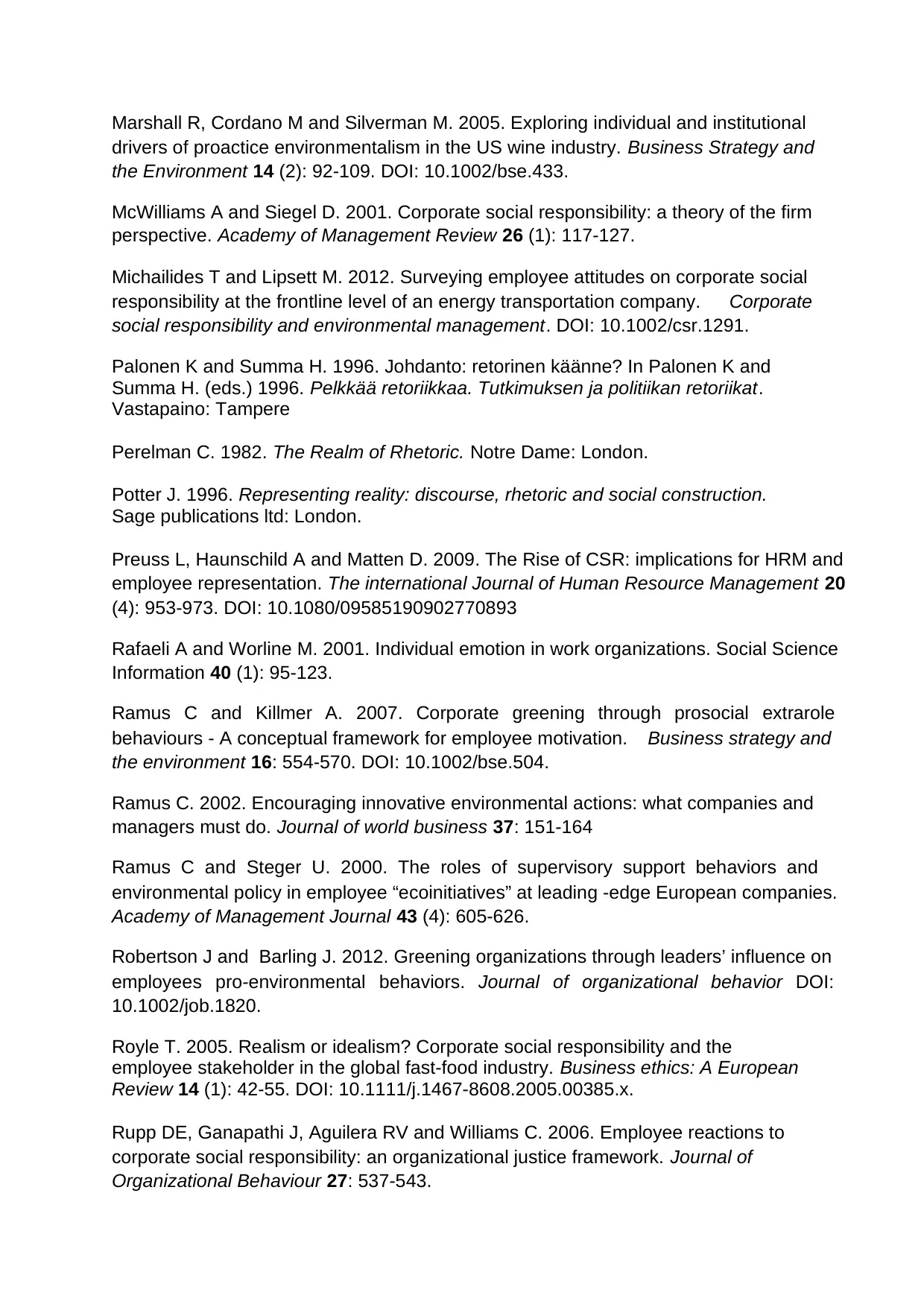
Marshall R, Cordano M and Silverman M. 2005. Exploring individual and institutional
drivers of proactice environmentalism in the US wine industry. Business Strategy and
the Environment 14 (2): 92-109. DOI: 10.1002/bse.433.
McWilliams A and Siegel D. 2001. Corporate social responsibility: a theory of the firm
perspective. Academy of Management Review 26 (1): 117-127.
Michailides T and Lipsett M. 2012. Surveying employee attitudes on corporate social
responsibility at the frontline level of an energy transportation company. Corporate
social responsibility and environmental management. DOI: 10.1002/csr.1291.
Palonen K and Summa H. 1996. Johdanto: retorinen käänne? In Palonen K and
Summa H. (eds.) 1996. Pelkkää retoriikkaa. Tutkimuksen ja politiikan retoriikat.
Vastapaino: Tampere
Perelman C. 1982. The Realm of Rhetoric. Notre Dame: London.
Potter J. 1996. Representing reality: discourse, rhetoric and social construction.
Sage publications ltd: London.
Preuss L, Haunschild A and Matten D. 2009. The Rise of CSR: implications for HRM and
employee representation. The international Journal of Human Resource Management 20
(4): 953-973. DOI: 10.1080/09585190902770893
Rafaeli A and Worline M. 2001. Individual emotion in work organizations. Social Science
Information 40 (1): 95-123.
Ramus C and Killmer A. 2007. Corporate greening through prosocial extrarole
behaviours - A conceptual framework for employee motivation. Business strategy and
the environment 16: 554-570. DOI: 10.1002/bse.504.
Ramus C. 2002. Encouraging innovative environmental actions: what companies and
managers must do. Journal of world business 37: 151-164
Ramus C and Steger U. 2000. The roles of supervisory support behaviors and
environmental policy in employee “ecoinitiatives” at leading -edge European companies.
Academy of Management Journal 43 (4): 605-626.
Robertson J and Barling J. 2012. Greening organizations through leaders’ influence on
employees pro-environmental behaviors. Journal of organizational behavior DOI:
10.1002/job.1820.
Royle T. 2005. Realism or idealism? Corporate social responsibility and the
employee stakeholder in the global fast-food industry. Business ethics: A European
Review 14 (1): 42-55. DOI: 10.1111/j.1467-8608.2005.00385.x.
Rupp DE, Ganapathi J, Aguilera RV and Williams C. 2006. Employee reactions to
corporate social responsibility: an organizational justice framework. Journal of
Organizational Behaviour 27: 537-543.
drivers of proactice environmentalism in the US wine industry. Business Strategy and
the Environment 14 (2): 92-109. DOI: 10.1002/bse.433.
McWilliams A and Siegel D. 2001. Corporate social responsibility: a theory of the firm
perspective. Academy of Management Review 26 (1): 117-127.
Michailides T and Lipsett M. 2012. Surveying employee attitudes on corporate social
responsibility at the frontline level of an energy transportation company. Corporate
social responsibility and environmental management. DOI: 10.1002/csr.1291.
Palonen K and Summa H. 1996. Johdanto: retorinen käänne? In Palonen K and
Summa H. (eds.) 1996. Pelkkää retoriikkaa. Tutkimuksen ja politiikan retoriikat.
Vastapaino: Tampere
Perelman C. 1982. The Realm of Rhetoric. Notre Dame: London.
Potter J. 1996. Representing reality: discourse, rhetoric and social construction.
Sage publications ltd: London.
Preuss L, Haunschild A and Matten D. 2009. The Rise of CSR: implications for HRM and
employee representation. The international Journal of Human Resource Management 20
(4): 953-973. DOI: 10.1080/09585190902770893
Rafaeli A and Worline M. 2001. Individual emotion in work organizations. Social Science
Information 40 (1): 95-123.
Ramus C and Killmer A. 2007. Corporate greening through prosocial extrarole
behaviours - A conceptual framework for employee motivation. Business strategy and
the environment 16: 554-570. DOI: 10.1002/bse.504.
Ramus C. 2002. Encouraging innovative environmental actions: what companies and
managers must do. Journal of world business 37: 151-164
Ramus C and Steger U. 2000. The roles of supervisory support behaviors and
environmental policy in employee “ecoinitiatives” at leading -edge European companies.
Academy of Management Journal 43 (4): 605-626.
Robertson J and Barling J. 2012. Greening organizations through leaders’ influence on
employees pro-environmental behaviors. Journal of organizational behavior DOI:
10.1002/job.1820.
Royle T. 2005. Realism or idealism? Corporate social responsibility and the
employee stakeholder in the global fast-food industry. Business ethics: A European
Review 14 (1): 42-55. DOI: 10.1111/j.1467-8608.2005.00385.x.
Rupp DE, Ganapathi J, Aguilera RV and Williams C. 2006. Employee reactions to
corporate social responsibility: an organizational justice framework. Journal of
Organizational Behaviour 27: 537-543.
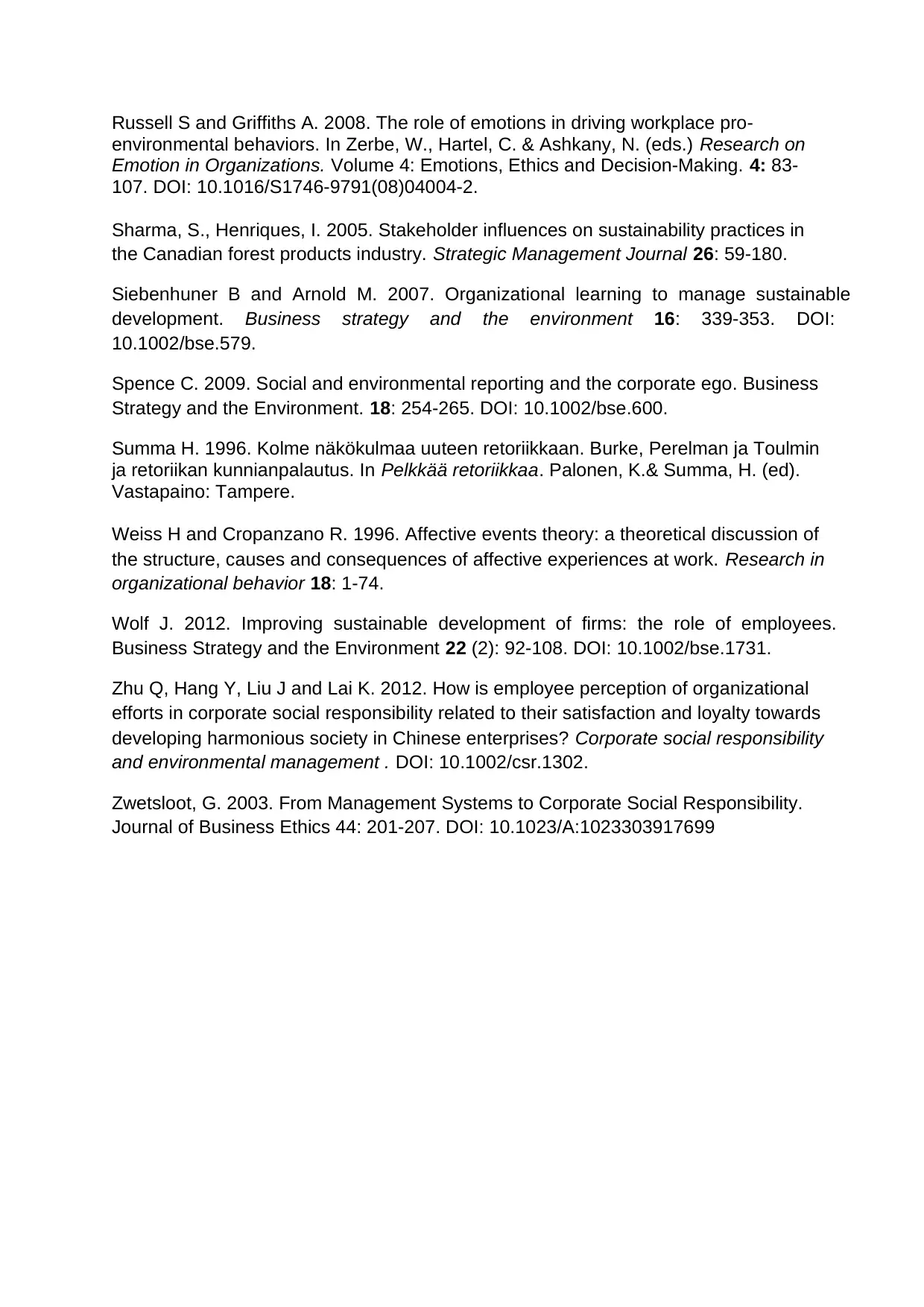
Russell S and Griffiths A. 2008. The role of emotions in driving workplace pro-
environmental behaviors. In Zerbe, W., Hartel, C. & Ashkany, N. (eds.) Research on
Emotion in Organizations. Volume 4: Emotions, Ethics and Decision-Making. 4: 83-
107. DOI: 10.1016/S1746-9791(08)04004-2.
Sharma, S., Henriques, I. 2005. Stakeholder influences on sustainability practices in
the Canadian forest products industry. Strategic Management Journal 26: 59-180.
Siebenhuner B and Arnold M. 2007. Organizational learning to manage sustainable
development. Business strategy and the environment 16: 339-353. DOI:
10.1002/bse.579.
Spence C. 2009. Social and environmental reporting and the corporate ego. Business
Strategy and the Environment. 18: 254-265. DOI: 10.1002/bse.600.
Summa H. 1996. Kolme näkökulmaa uuteen retoriikkaan. Burke, Perelman ja Toulmin
ja retoriikan kunnianpalautus. In Pelkkää retoriikkaa. Palonen, K.& Summa, H. (ed).
Vastapaino: Tampere.
Weiss H and Cropanzano R. 1996. Affective events theory: a theoretical discussion of
the structure, causes and consequences of affective experiences at work. Research in
organizational behavior 18: 1-74.
Wolf J. 2012. Improving sustainable development of firms: the role of employees.
Business Strategy and the Environment 22 (2): 92-108. DOI: 10.1002/bse.1731.
Zhu Q, Hang Y, Liu J and Lai K. 2012. How is employee perception of organizational
efforts in corporate social responsibility related to their satisfaction and loyalty towards
developing harmonious society in Chinese enterprises? Corporate social responsibility
and environmental management . DOI: 10.1002/csr.1302.
Zwetsloot, G. 2003. From Management Systems to Corporate Social Responsibility.
Journal of Business Ethics 44: 201-207. DOI: 10.1023/A:1023303917699
environmental behaviors. In Zerbe, W., Hartel, C. & Ashkany, N. (eds.) Research on
Emotion in Organizations. Volume 4: Emotions, Ethics and Decision-Making. 4: 83-
107. DOI: 10.1016/S1746-9791(08)04004-2.
Sharma, S., Henriques, I. 2005. Stakeholder influences on sustainability practices in
the Canadian forest products industry. Strategic Management Journal 26: 59-180.
Siebenhuner B and Arnold M. 2007. Organizational learning to manage sustainable
development. Business strategy and the environment 16: 339-353. DOI:
10.1002/bse.579.
Spence C. 2009. Social and environmental reporting and the corporate ego. Business
Strategy and the Environment. 18: 254-265. DOI: 10.1002/bse.600.
Summa H. 1996. Kolme näkökulmaa uuteen retoriikkaan. Burke, Perelman ja Toulmin
ja retoriikan kunnianpalautus. In Pelkkää retoriikkaa. Palonen, K.& Summa, H. (ed).
Vastapaino: Tampere.
Weiss H and Cropanzano R. 1996. Affective events theory: a theoretical discussion of
the structure, causes and consequences of affective experiences at work. Research in
organizational behavior 18: 1-74.
Wolf J. 2012. Improving sustainable development of firms: the role of employees.
Business Strategy and the Environment 22 (2): 92-108. DOI: 10.1002/bse.1731.
Zhu Q, Hang Y, Liu J and Lai K. 2012. How is employee perception of organizational
efforts in corporate social responsibility related to their satisfaction and loyalty towards
developing harmonious society in Chinese enterprises? Corporate social responsibility
and environmental management . DOI: 10.1002/csr.1302.
Zwetsloot, G. 2003. From Management Systems to Corporate Social Responsibility.
Journal of Business Ethics 44: 201-207. DOI: 10.1023/A:1023303917699
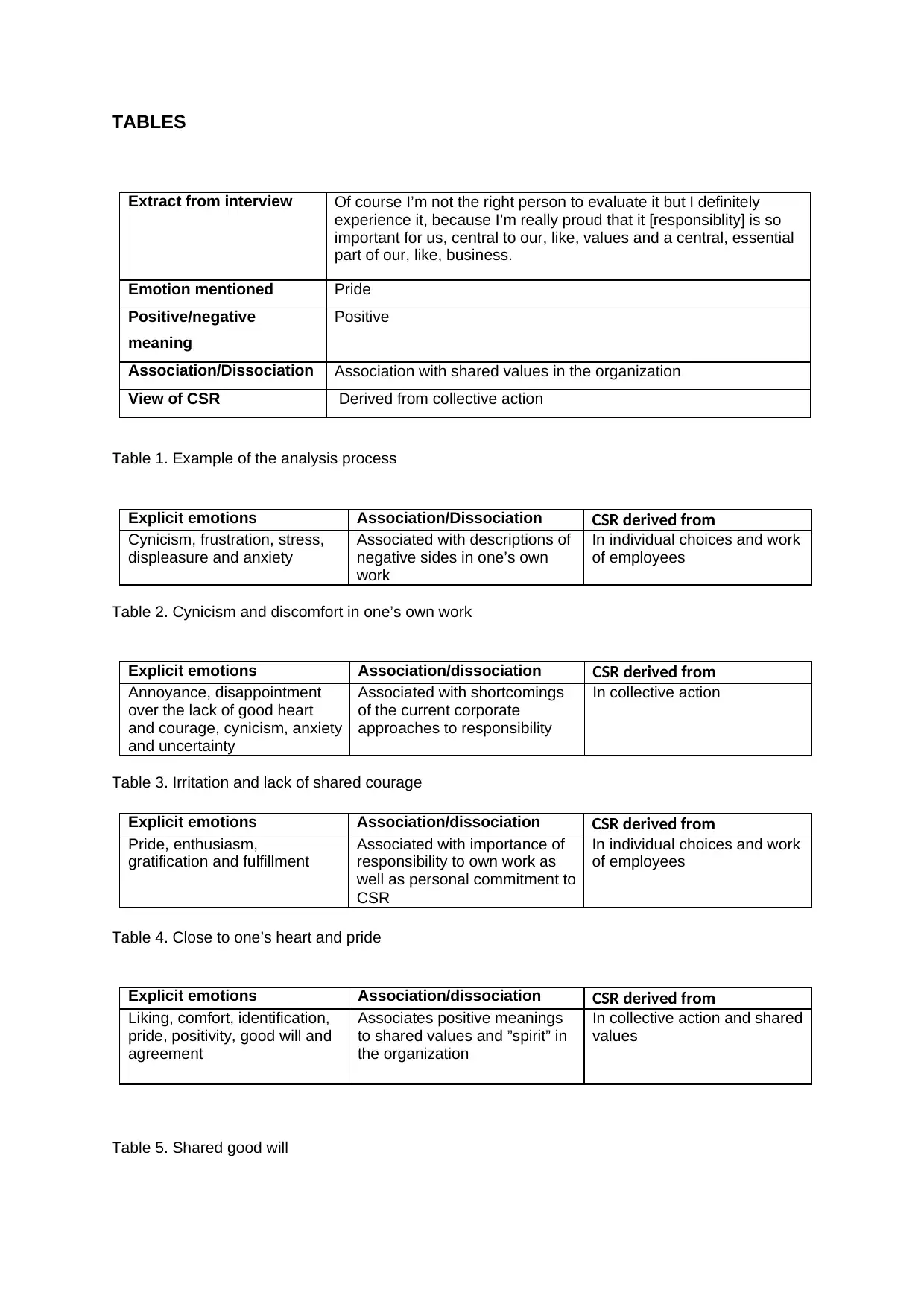
TABLES
Extract from interview Of course I’m not the right person to evaluate it but I definitely
experience it, because I’m really proud that it [responsiblity] is so
important for us, central to our, like, values and a central, essential
part of our, like, business.
Emotion mentioned Pride
Positive/negative
meaning
Positive
Association/Dissociation Association with shared values in the organization
View of CSR Derived from collective action
Table 1. Example of the analysis process
Explicit emotions Association/Dissociation CSR derived from
Cynicism, frustration, stress,
displeasure and anxiety
Associated with descriptions of
negative sides in one’s own
work
In individual choices and work
of employees
Table 2. Cynicism and discomfort in one’s own work
Explicit emotions Association/dissociation CSR derived from
Annoyance, disappointment
over the lack of good heart
and courage, cynicism, anxiety
and uncertainty
Associated with shortcomings
of the current corporate
approaches to responsibility
In collective action
Table 3. Irritation and lack of shared courage
Explicit emotions Association/dissociation CSR derived from
Pride, enthusiasm,
gratification and fulfillment
Associated with importance of
responsibility to own work as
well as personal commitment to
CSR
In individual choices and work
of employees
Table 4. Close to one’s heart and pride
Explicit emotions Association/dissociation CSR derived from
Liking, comfort, identification,
pride, positivity, good will and
agreement
Associates positive meanings
to shared values and ”spirit” in
the organization
In collective action and shared
values
Table 5. Shared good will
Extract from interview Of course I’m not the right person to evaluate it but I definitely
experience it, because I’m really proud that it [responsiblity] is so
important for us, central to our, like, values and a central, essential
part of our, like, business.
Emotion mentioned Pride
Positive/negative
meaning
Positive
Association/Dissociation Association with shared values in the organization
View of CSR Derived from collective action
Table 1. Example of the analysis process
Explicit emotions Association/Dissociation CSR derived from
Cynicism, frustration, stress,
displeasure and anxiety
Associated with descriptions of
negative sides in one’s own
work
In individual choices and work
of employees
Table 2. Cynicism and discomfort in one’s own work
Explicit emotions Association/dissociation CSR derived from
Annoyance, disappointment
over the lack of good heart
and courage, cynicism, anxiety
and uncertainty
Associated with shortcomings
of the current corporate
approaches to responsibility
In collective action
Table 3. Irritation and lack of shared courage
Explicit emotions Association/dissociation CSR derived from
Pride, enthusiasm,
gratification and fulfillment
Associated with importance of
responsibility to own work as
well as personal commitment to
CSR
In individual choices and work
of employees
Table 4. Close to one’s heart and pride
Explicit emotions Association/dissociation CSR derived from
Liking, comfort, identification,
pride, positivity, good will and
agreement
Associates positive meanings
to shared values and ”spirit” in
the organization
In collective action and shared
values
Table 5. Shared good will
Secure Best Marks with AI Grader
Need help grading? Try our AI Grader for instant feedback on your assignments.
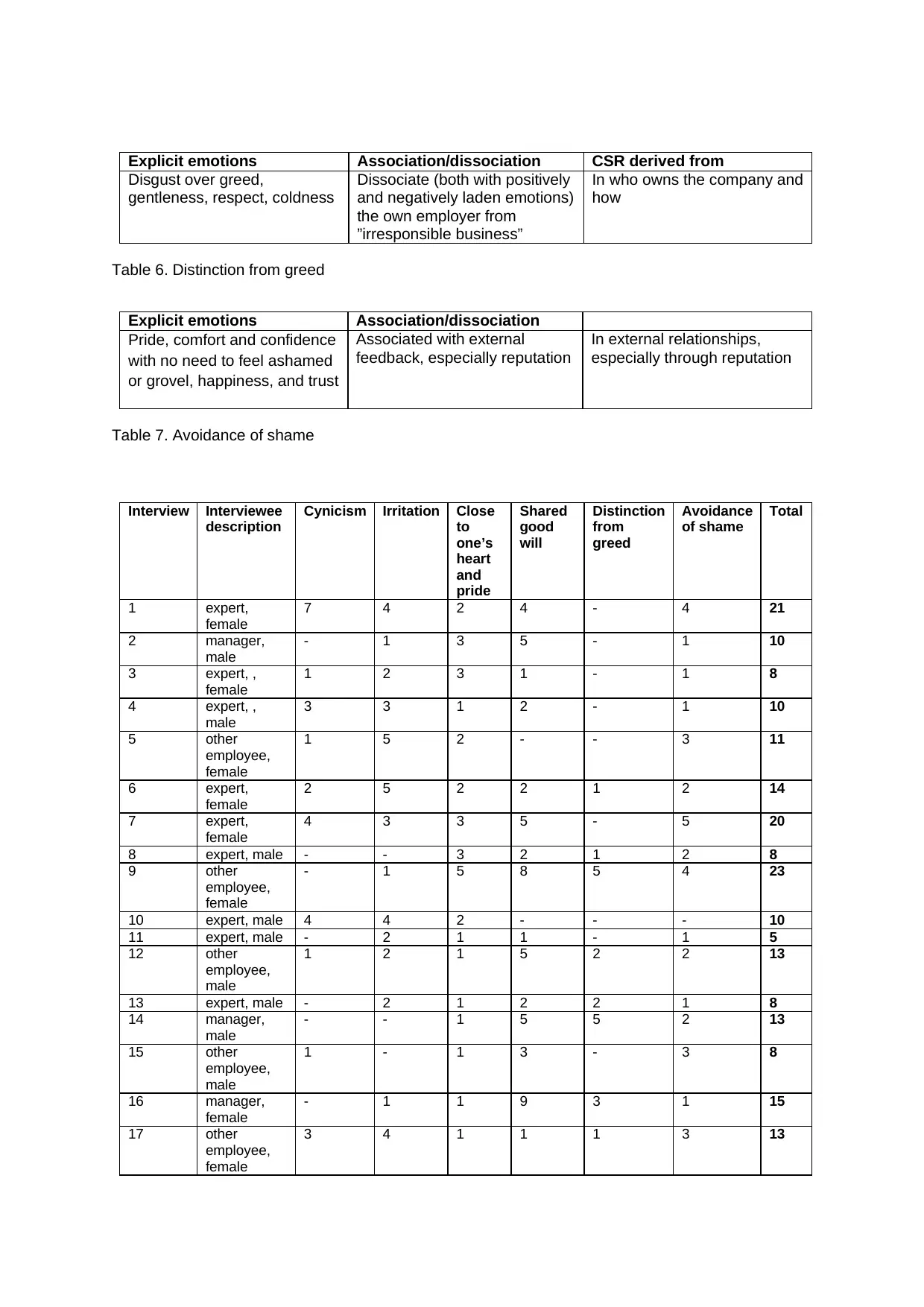
Explicit emotions Association/dissociation CSR derived from
Disgust over greed,
gentleness, respect, coldness
Dissociate (both with positively
and negatively laden emotions)
the own employer from
”irresponsible business”
In who owns the company and
how
Table 6. Distinction from greed
Explicit emotions Association/dissociation
Pride, comfort and confidence
with no need to feel ashamed
or grovel, happiness, and trust
Associated with external
feedback, especially reputation
In external relationships,
especially through reputation
Table 7. Avoidance of shame
Interview Interviewee
description
Cynicism Irritation Close
to
one’s
heart
and
pride
Shared
good
will
Distinction
from
greed
Avoidance
of shame
Total
1 expert,
female
7 4 2 4 - 4 21
2 manager,
male
- 1 3 5 - 1 10
3 expert, ,
female
1 2 3 1 - 1 8
4 expert, ,
male
3 3 1 2 - 1 10
5 other
employee,
female
1 5 2 - - 3 11
6 expert,
female
2 5 2 2 1 2 14
7 expert,
female
4 3 3 5 - 5 20
8 expert, male - - 3 2 1 2 8
9 other
employee,
female
- 1 5 8 5 4 23
10 expert, male 4 4 2 - - - 10
11 expert, male - 2 1 1 - 1 5
12 other
employee,
male
1 2 1 5 2 2 13
13 expert, male - 2 1 2 2 1 8
14 manager,
male
- - 1 5 5 2 13
15 other
employee,
male
1 - 1 3 - 3 8
16 manager,
female
- 1 1 9 3 1 15
17 other
employee,
female
3 4 1 1 1 3 13
Disgust over greed,
gentleness, respect, coldness
Dissociate (both with positively
and negatively laden emotions)
the own employer from
”irresponsible business”
In who owns the company and
how
Table 6. Distinction from greed
Explicit emotions Association/dissociation
Pride, comfort and confidence
with no need to feel ashamed
or grovel, happiness, and trust
Associated with external
feedback, especially reputation
In external relationships,
especially through reputation
Table 7. Avoidance of shame
Interview Interviewee
description
Cynicism Irritation Close
to
one’s
heart
and
pride
Shared
good
will
Distinction
from
greed
Avoidance
of shame
Total
1 expert,
female
7 4 2 4 - 4 21
2 manager,
male
- 1 3 5 - 1 10
3 expert, ,
female
1 2 3 1 - 1 8
4 expert, ,
male
3 3 1 2 - 1 10
5 other
employee,
female
1 5 2 - - 3 11
6 expert,
female
2 5 2 2 1 2 14
7 expert,
female
4 3 3 5 - 5 20
8 expert, male - - 3 2 1 2 8
9 other
employee,
female
- 1 5 8 5 4 23
10 expert, male 4 4 2 - - - 10
11 expert, male - 2 1 1 - 1 5
12 other
employee,
male
1 2 1 5 2 2 13
13 expert, male - 2 1 2 2 1 8
14 manager,
male
- - 1 5 5 2 13
15 other
employee,
male
1 - 1 3 - 3 8
16 manager,
female
- 1 1 9 3 1 15
17 other
employee,
female
3 4 1 1 1 3 13
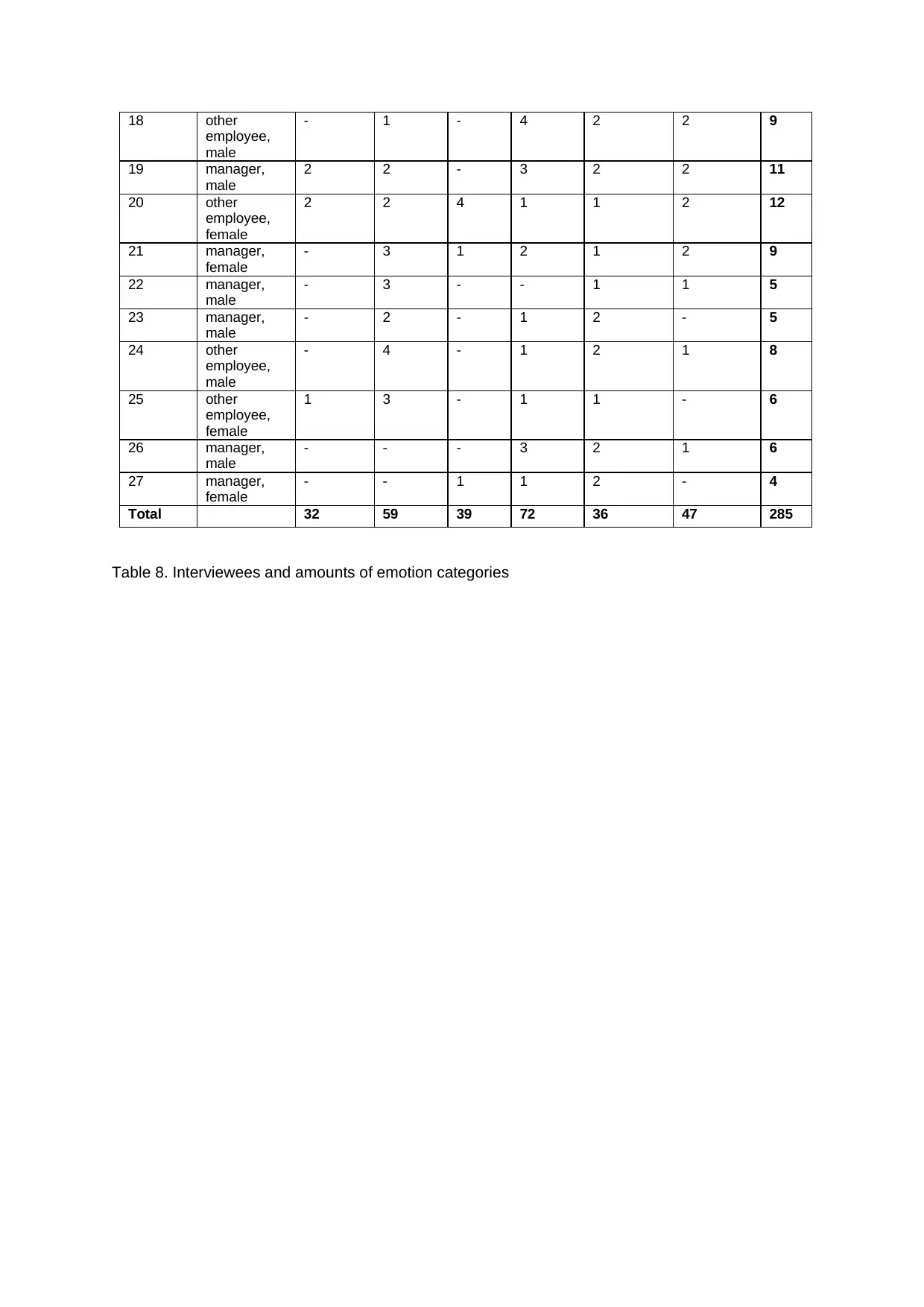
18 other
employee,
male
- 1 - 4 2 2 9
19 manager,
male
2 2 - 3 2 2 11
20 other
employee,
female
2 2 4 1 1 2 12
21 manager,
female
- 3 1 2 1 2 9
22 manager,
male
- 3 - - 1 1 5
23 manager,
male
- 2 - 1 2 - 5
24 other
employee,
male
- 4 - 1 2 1 8
25 other
employee,
female
1 3 - 1 1 - 6
26 manager,
male
- - - 3 2 1 6
27 manager,
female
- - 1 1 2 - 4
Total 32 59 39 72 36 47 285
Table 8. Interviewees and amounts of emotion categories
employee,
male
- 1 - 4 2 2 9
19 manager,
male
2 2 - 3 2 2 11
20 other
employee,
female
2 2 4 1 1 2 12
21 manager,
female
- 3 1 2 1 2 9
22 manager,
male
- 3 - - 1 1 5
23 manager,
male
- 2 - 1 2 - 5
24 other
employee,
male
- 4 - 1 2 1 8
25 other
employee,
female
1 3 - 1 1 - 6
26 manager,
male
- - - 3 2 1 6
27 manager,
female
- - 1 1 2 - 4
Total 32 59 39 72 36 47 285
Table 8. Interviewees and amounts of emotion categories
1 out of 30
Your All-in-One AI-Powered Toolkit for Academic Success.
+13062052269
info@desklib.com
Available 24*7 on WhatsApp / Email
![[object Object]](/_next/static/media/star-bottom.7253800d.svg)
Unlock your academic potential
© 2024 | Zucol Services PVT LTD | All rights reserved.